-
Deetjen’s Rustic Inn & Restaurant in Big Sur
This is fourth in my series of reviews of iconic Big Sur restaurants, look for more in the future!
Deetjen’s Restaurant & Inn lies in Big Sur’s Castro Creek Canyon, nestled beneath a grove of ancient redwoods. With eclectic room names like “Chateau Fiasco”, “Top Antique” & “13th Room” (to be avoided if you have triskaidekaphobia), Deetjen’s combines authentic Big Sur spirit with vintage furnishings, beautiful gardens, and delicious food. Deetjens Big Sur Inn, open since the 1930s, is on the National Register of Historic Places. Currently, the Inn is operated on a not-for-profit basis by the Deetjens Big Sur Inn Preservation Foundation.
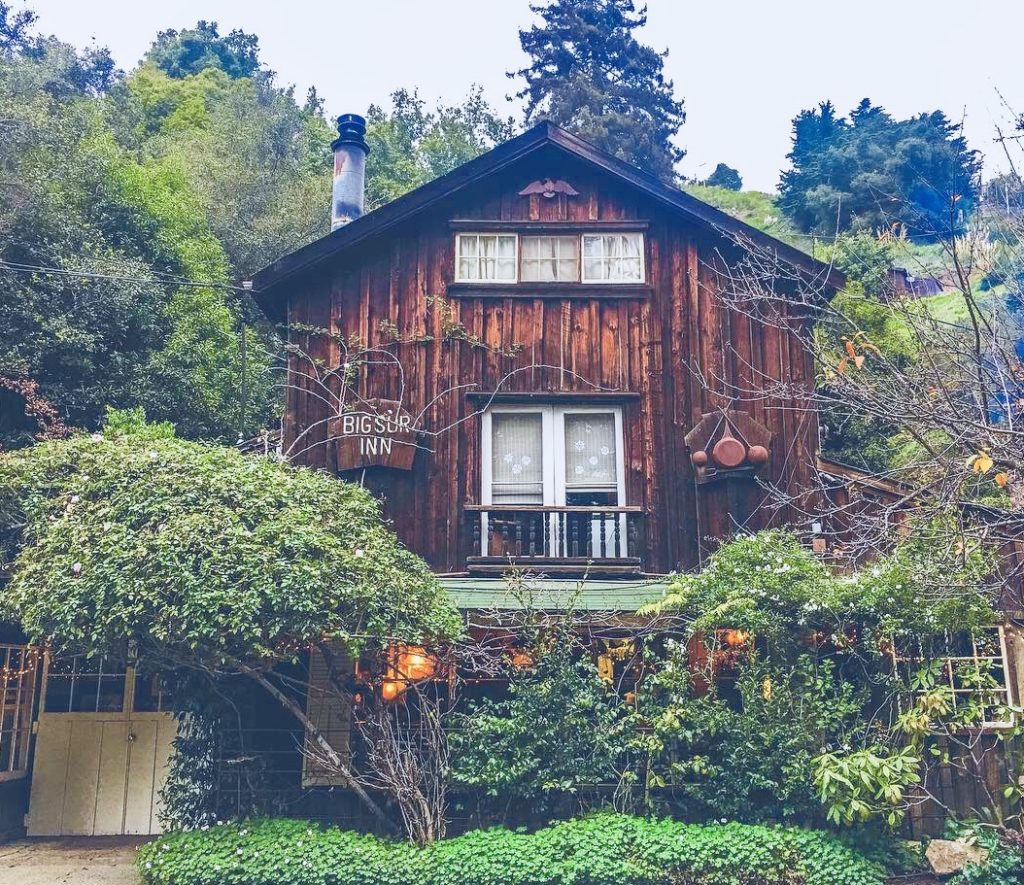
History
After the opening of Highway 1 between Carmel and San Simeon brought an influx of visitors to the area, the Deetjens decided to provide a place for people to stay and enjoy a home-cooked meal. Built from 1936 through 1950 by Helmuth Deetjen and his wife Helen, Deetjen’s features rustic cabins constructed with authentic Norwegian craftsmanship.
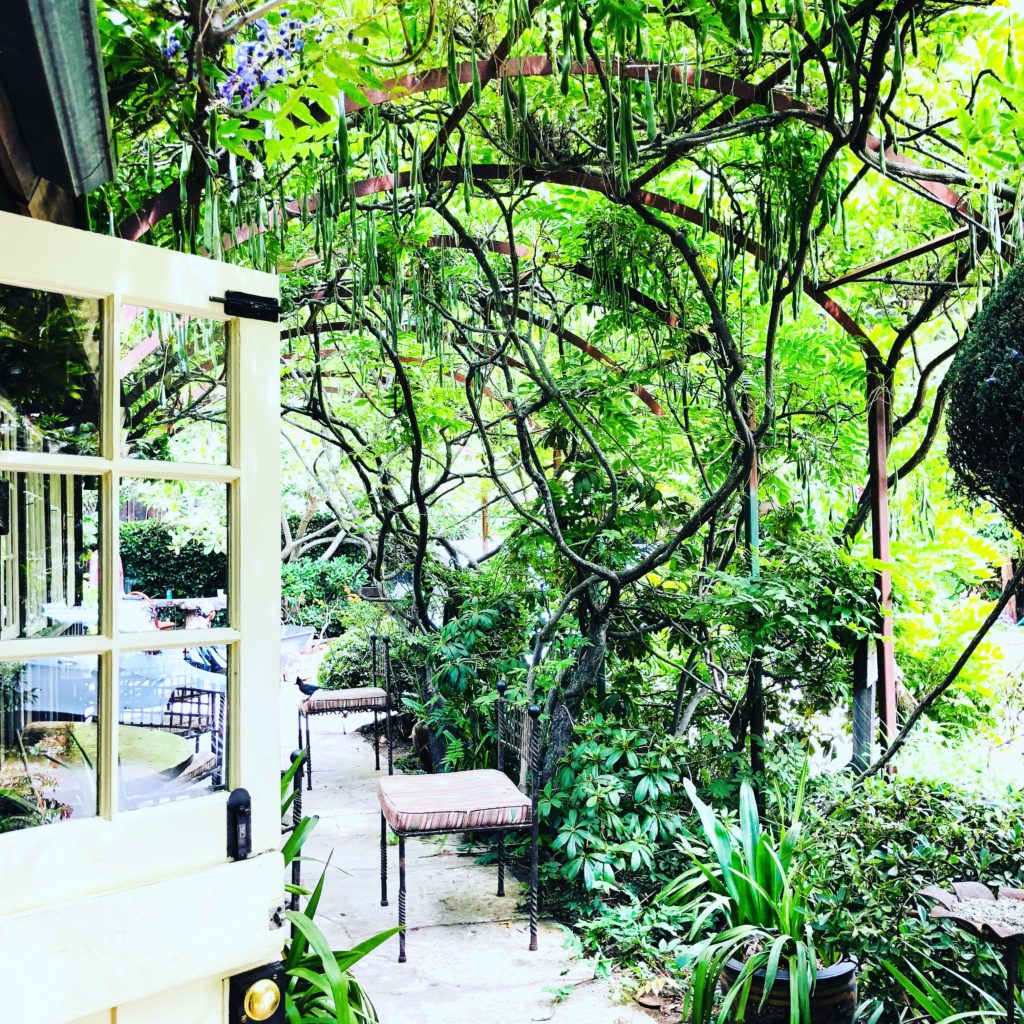
The Restaurant
The restaurant features outdoor dining beneath a canopy of wisteria, or charming indoor dining next to a cozy, crackling fireplace. The food here is amazingly delicious and guests regularly rave about it. What more could you ask for?
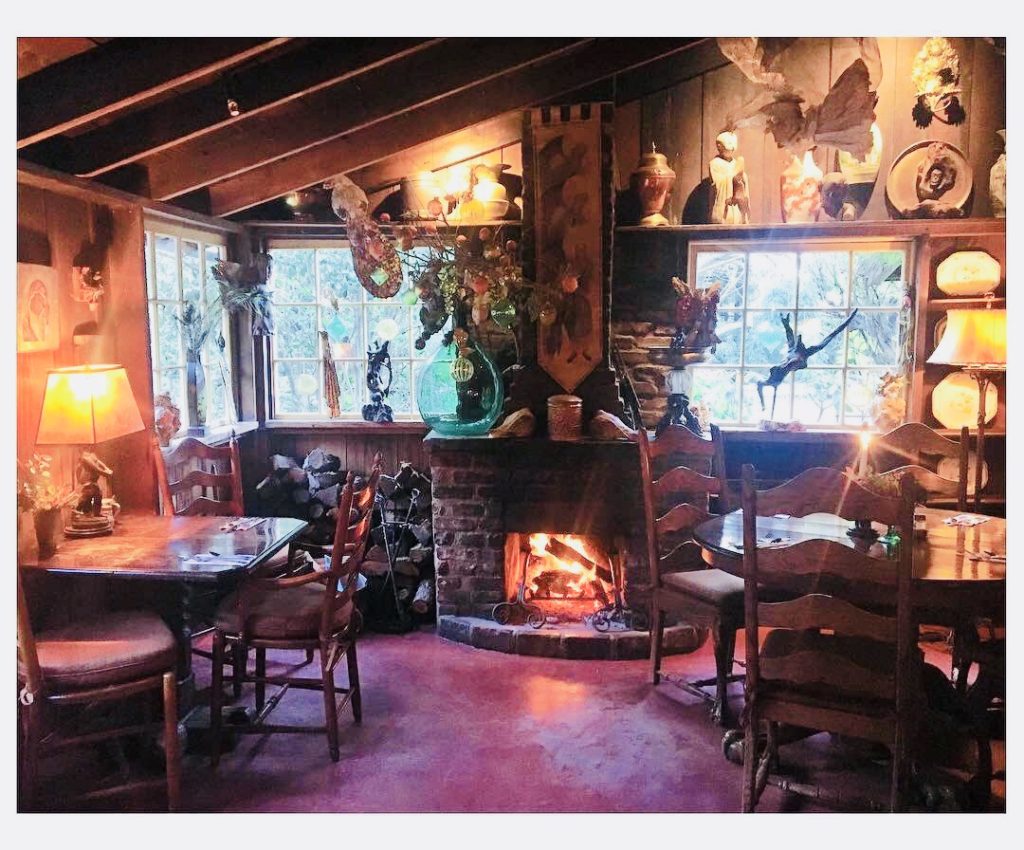
The dining room exudes a cozy, home-like environment The Inn
Throughout its history, Deetjen’s has been a refuge for writers, artists, and celebrities. Nonetheless, this is a basic, no frills kind of place. There is no wi-fi, no television, no cell service, no swimming pool or spa. Some rooms share a bathroom. The rooms are small and thin-walled, with wood stoves for heat. Yet there is a charm and comfort here you will find nowhere else. Opportunities to hike, bird watch (including the rare California Condor), or enjoy the gardens abound. Guests also enjoy perusing each room’s journal for previous lodger’s stories and tidbits of wisdom. Deetjens states that their mission is “to preserve the history of the Inn by providing a peaceful, retreat-type experience for our guests”.
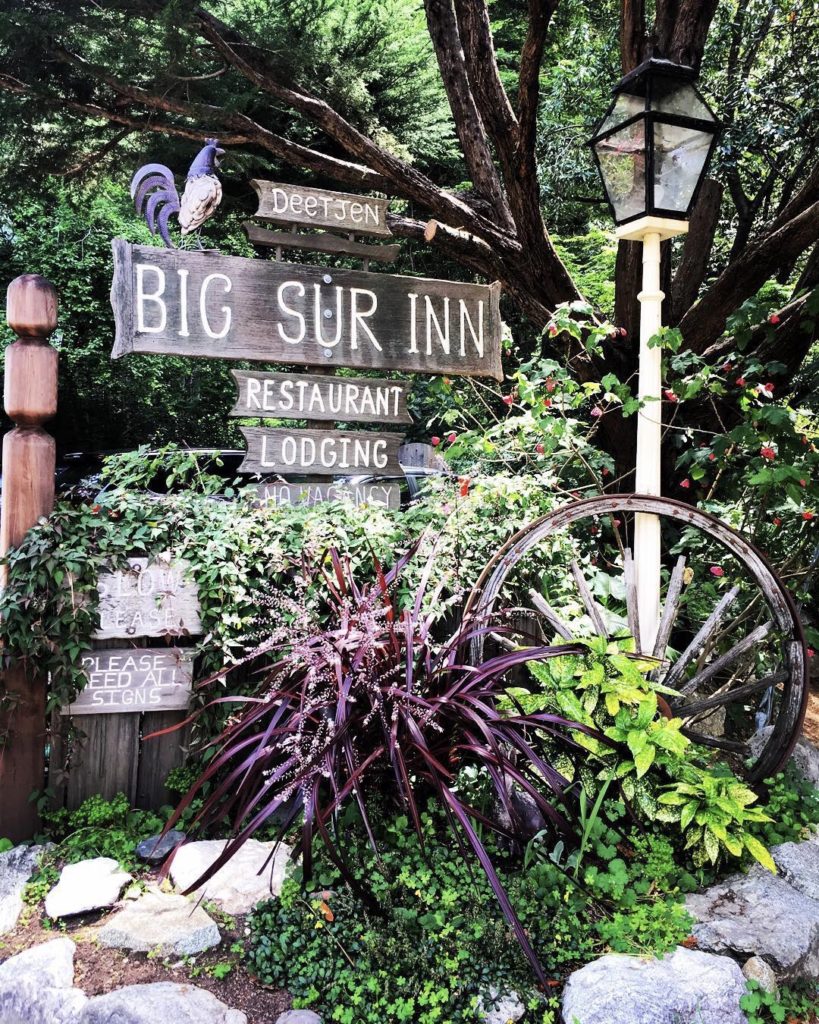
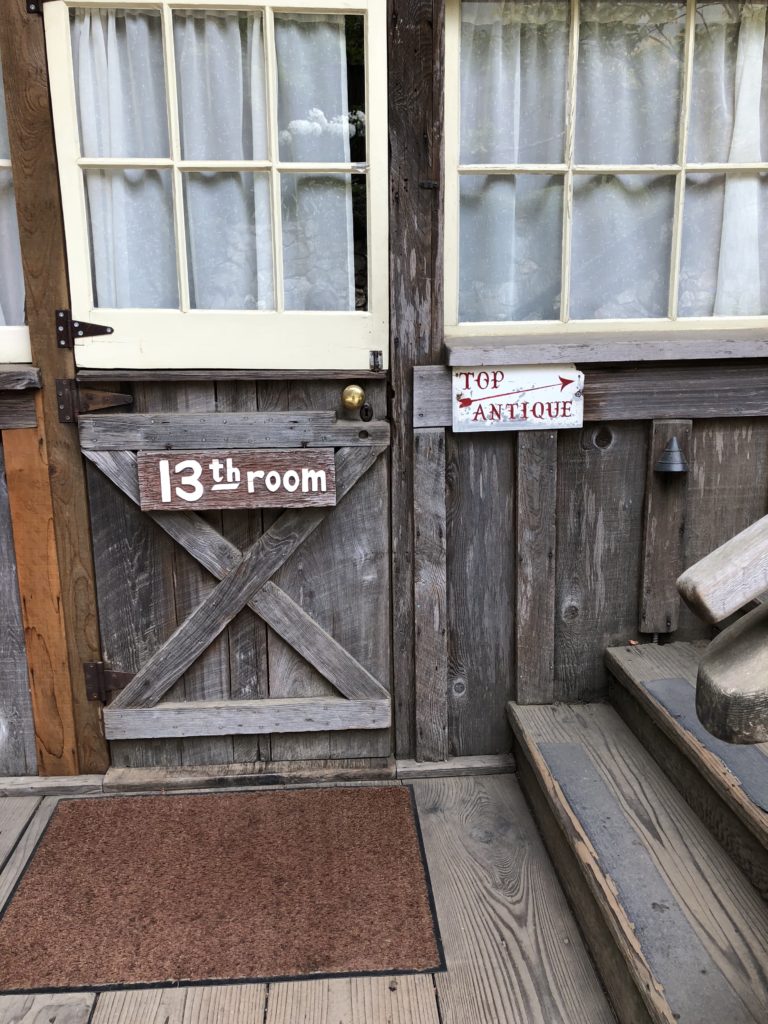
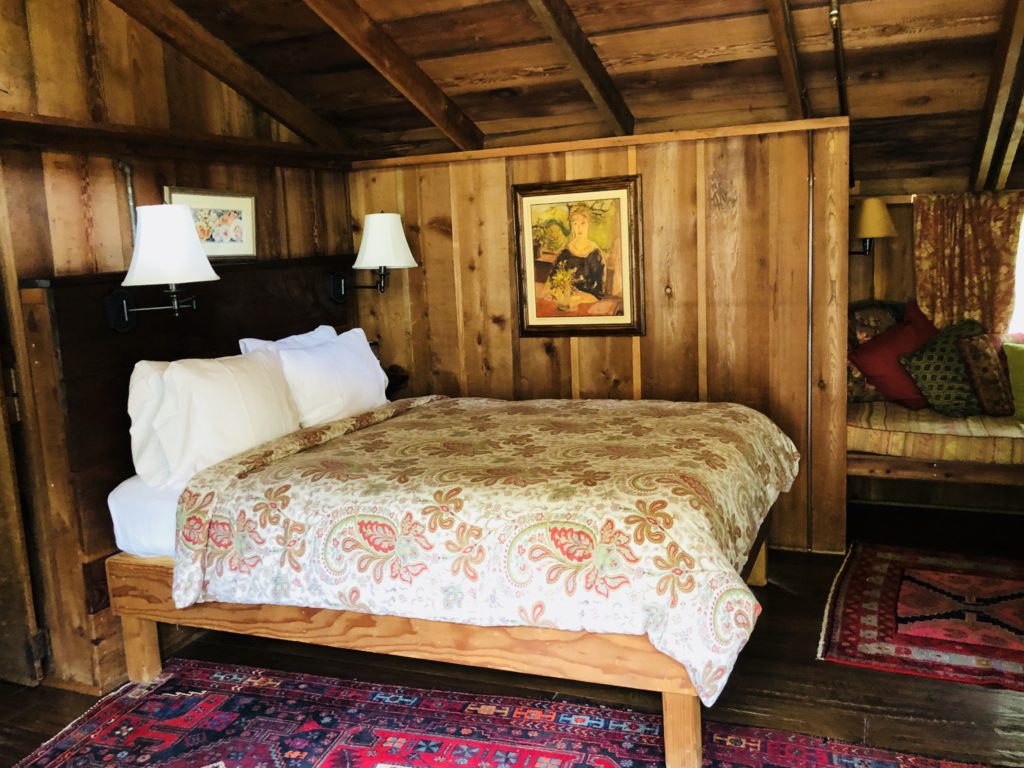
Tours
You are free to look around the grounds on your own, or you may wish to join a formal tour. Tours of the historic inn and grounds are available Tuesday through Thursday at 10 am, or you may schedule an appointment for a private tour. During your tour, you may notice one of the adorable resident cats roaming the gardens. One of the cats, Fabio, even has his own blog! (see Fabio)
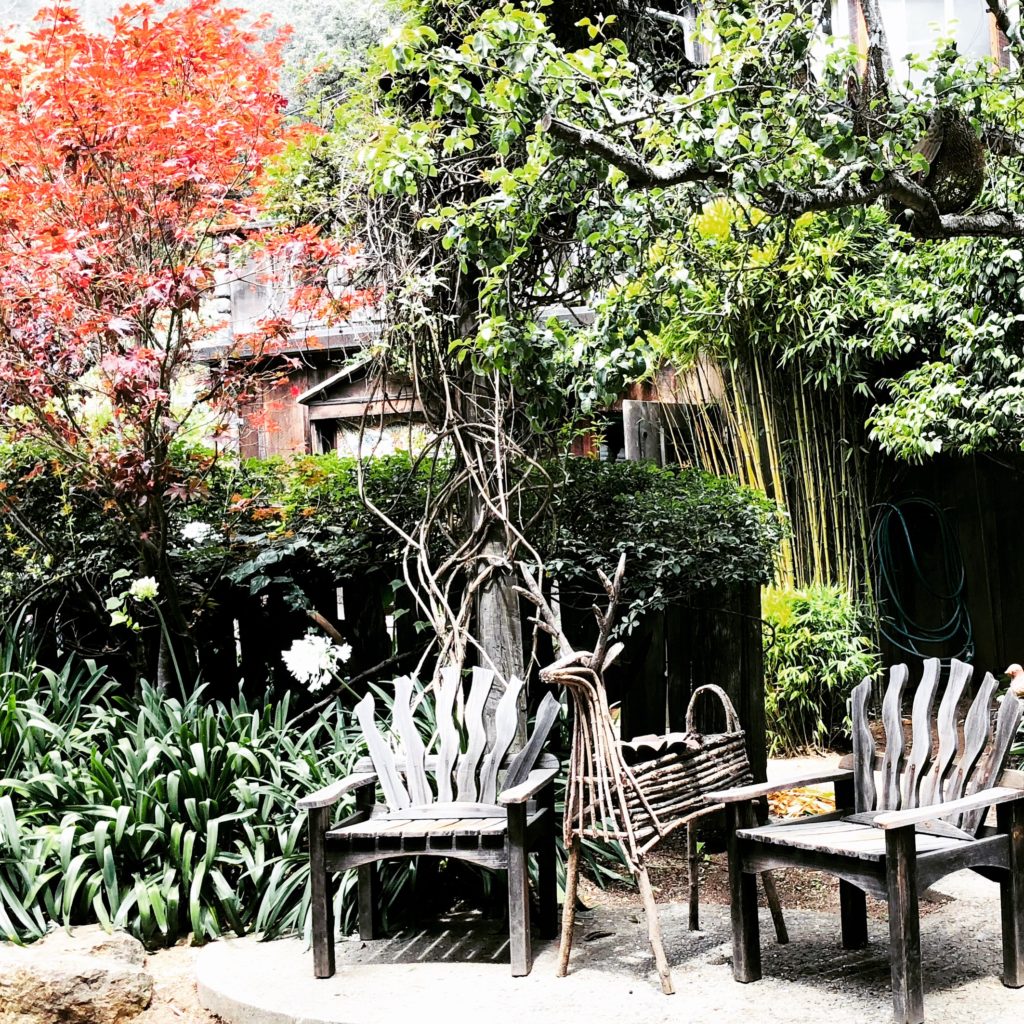
Another beautiful garden at Deetjen’s Location
Deetjen’s is located at 48865 Highway 1, Big Sur, CA, just south of the Henry Miller Library. For reservations or information, call 831-667-2377 or see Deetjens
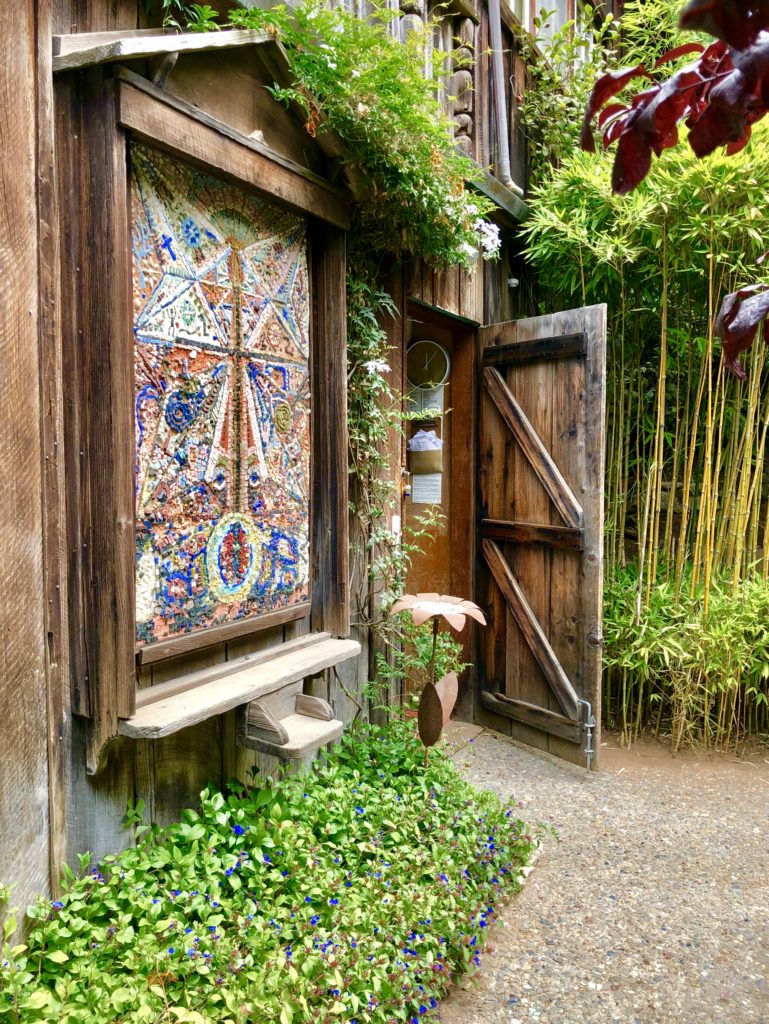
An exquisite hand-made mosaic adds to the creativity of the garden Thank you for visiting my blog! Wishing you peace, love, happiness, and beautiful vistas!
-
Shark Fin Cove Beach and Sea Cave
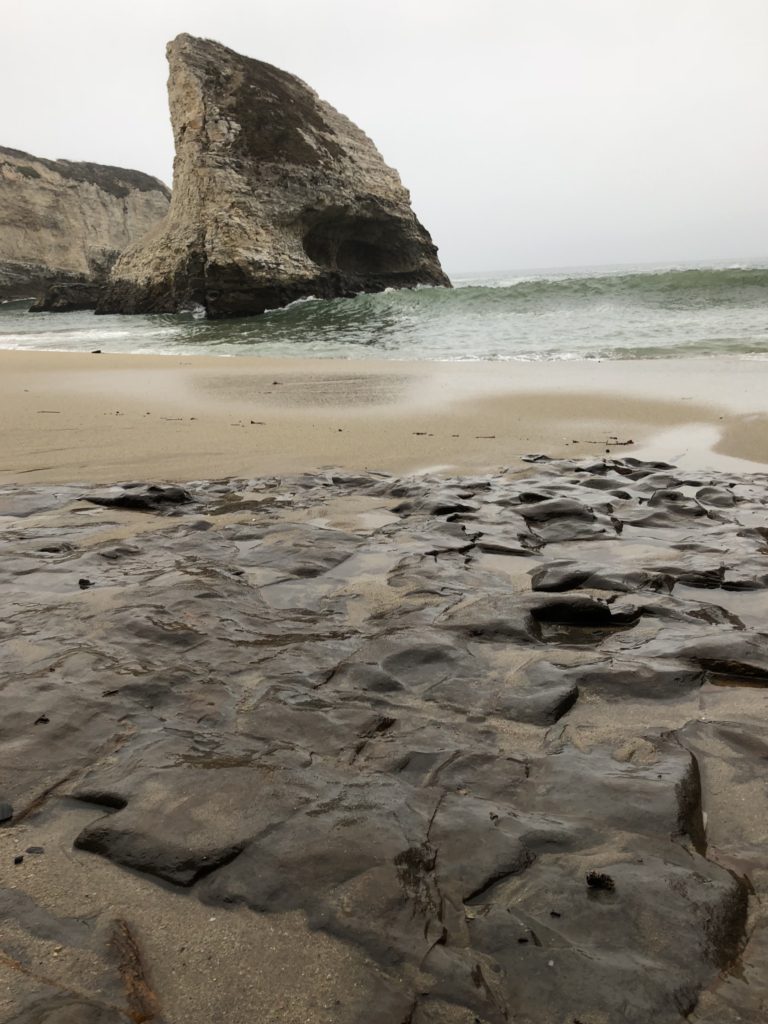
To walk in nature is to witness a thousand miracles. Shark Fin Cove, located .7 miles south of Davenport, California, is one of these miracles. Want to get away from it all and get lost in a beautiful place? This hidden gem will impress you with a stunning walk-through sea cave and an island shaped like a shark’s fin, the result of hundreds, perhaps thousands of years worth of sand being pummeled by the sea’s incessant waves.
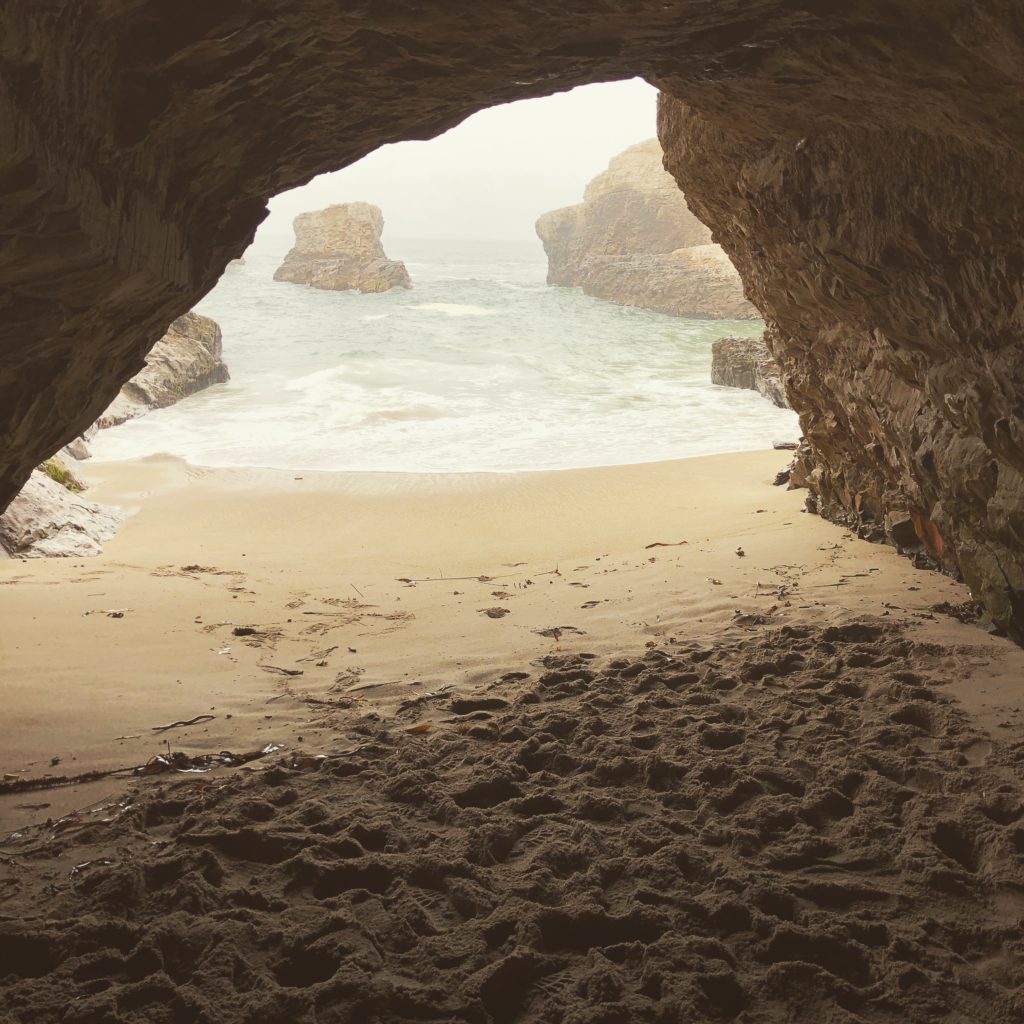
Shark Fin Cove & Beach were previously owned by Coast Dairies. In 2006, 407 acres of coastland and beaches were donated to California State Parks. Shark Fin Cove & Beach are a small part of this donation and are part of the much larger Coast Dairies State Park. Currently, the Coast Dairies State Park spans about a six-mile segment west of Hwy 1 North in Santa Cruz County, just south of the small town of Davenport and includes Bonny Doon, Laguna Creek, Panther, Davenport Landing, and Scott Creek Beach.
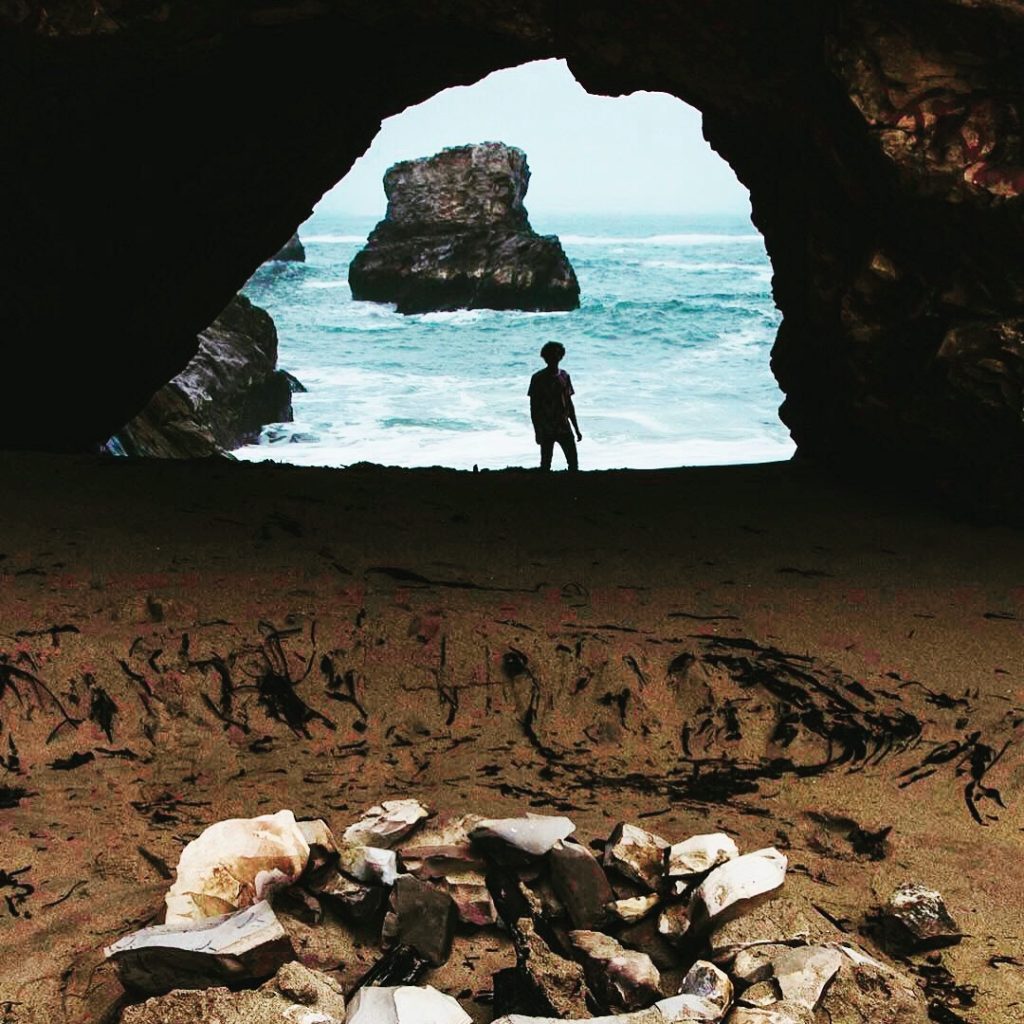
This secluded beach offers great opportunities for photographers because of the sea cave and other features, including the shark fin rock structure. There is also an old mining tunnel on the beach with a delicate waterfall trickling down that is said to be a geocaching site. In addition, there is another amazing arch that may be crossed underneath at low tide. Watching the ocean is mesmerizing but be aware that at times the powerful and dangerous waves here have the potential to sweep you out to sea.
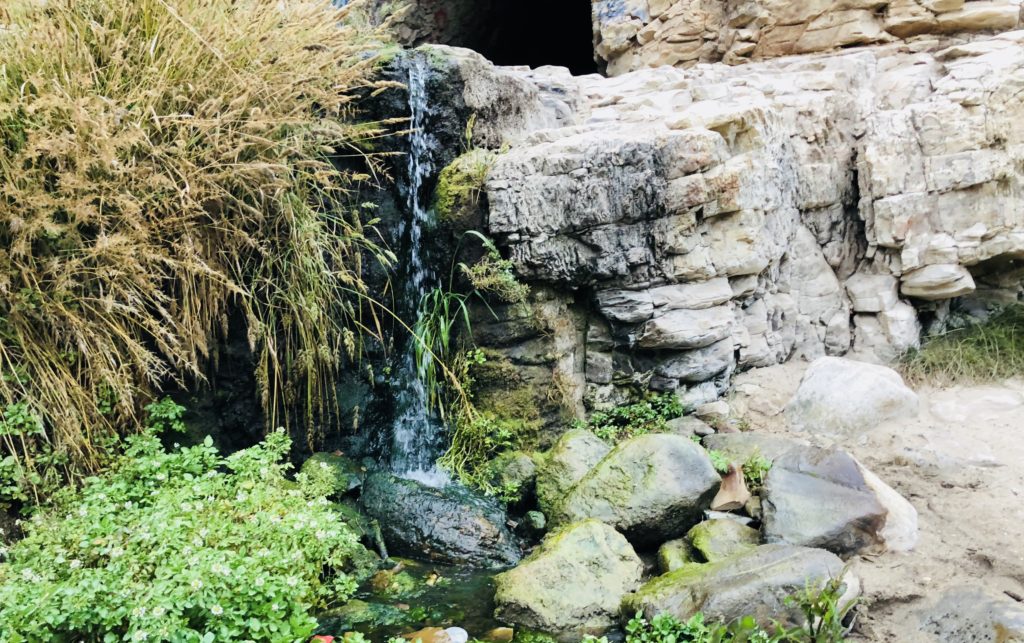
This is a beautiful, rare, and amazing place. Yet, there was another side of Shark Fin Cove Beach that made me sick. People have used spray paint to defile the natural stone with senseless graffiti. People also camp out here and leave their garbage lying on the beach instead of cleaning up after themselves and taking their trash with them. They treat this place like a landfill. It is incomprehensible and unthinkable. How can you abuse such a place of perfect beauty and tranquility? We all have a responsibility to protect areas like Shark Fin Cove and hand them down unharmed to those who come after us. “The earth gets tired of being exploited. A country was made to be as we found it”–Ernest Hemingway
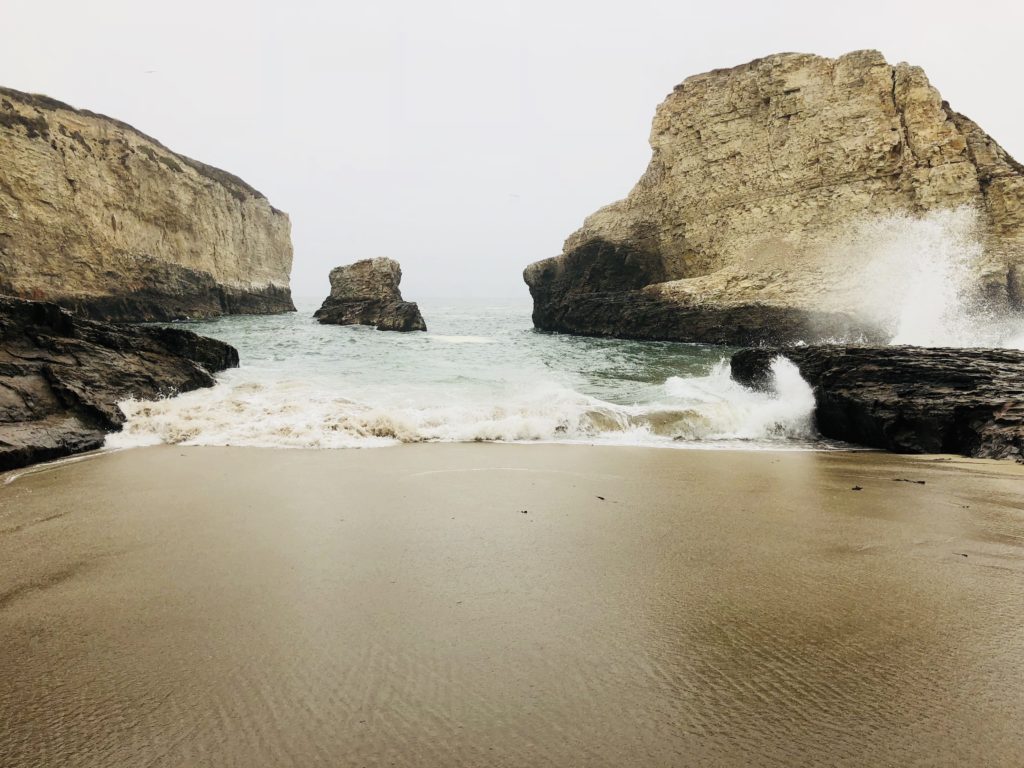
How to get there? From Santa Cruz, follow Hwy 1 north approximately 10 miles. Just north of parking for Bonny Doon Beach, you will see a dirt pullout. You will be able to see railroad tracks west of the parking area. Take the trail over the railroad tracks and you will see a sign and behind it a trail leading down under a large pipe. Follow the steep trail down under the pipe (try not to bump your head like I did!), and when you get to the bottom the sea cave is to the far left. Straight ahead you will see the rock formation shaped like a shark fin. The old mining tunnel with the trickling waterfall is to the right, just at the foot of the trail.
From the parking area, it is approximately .3 miles to the beach. There are other trails leading to cliffs above the beach that allow beautiful overlooks of the area and lend themselves to great photo ops. This is a great place to watch the sunset, beachcomb, or have a picnic. Again, respect our seashore and leave no trace!
Wishing you peace, love, happiness, and beautiful vistas!
-
Picturesque Pigeon Point Lighthouse
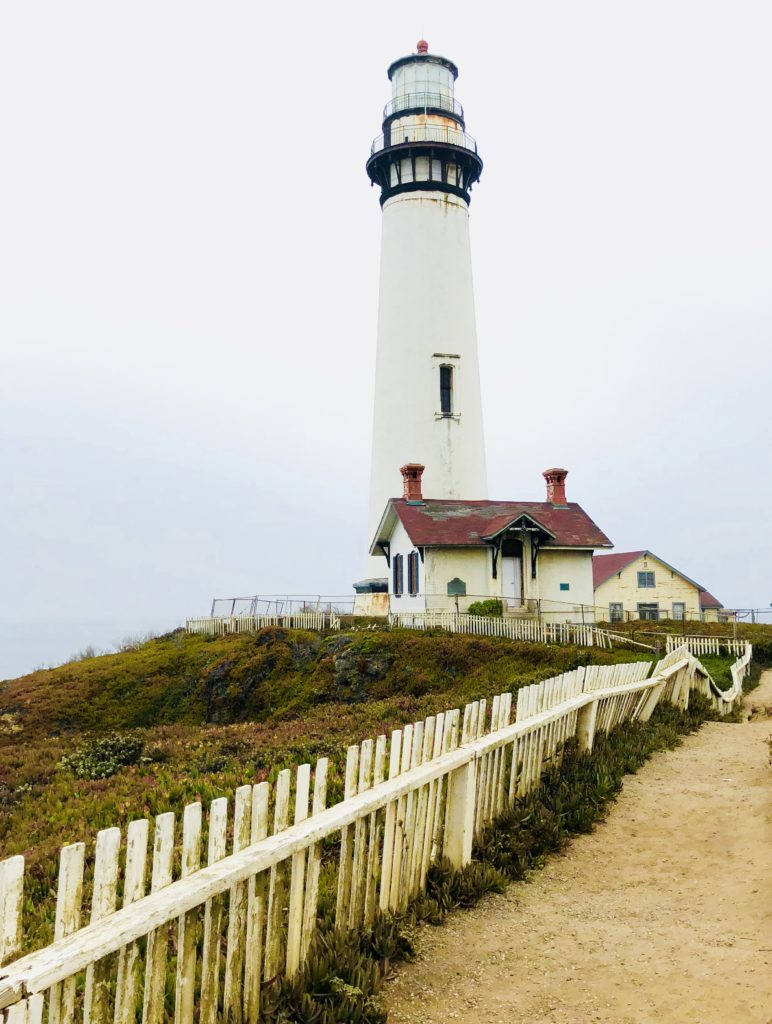
Pigeon Point is one of the most picturesque lighthouses to grace the Pacific Coast. It is also one of the tallest lighthouses in California, standing 115 feet high (it ties for this honor with Point Arena Light north of San Francisco). It was built in 1871. It is named for the clipper ship Carrier Pigeon which ran aground near Whale Point, which was renamed Pigeon Point in memory of the shipwreck. Rock-strewn and foggy, the ocean here is treacherous. Submerged rocks, swirling currents, and eddies presented a challenge even for the most experienced sailors. Due to persistent thick fog, navigational readings were unreliable. Signals from fog horns and other ships were also easily misinterpreted. After three more shipwrecks occurred in the area, Congress approved the construction of a lighthouse at a cost of $90,000, which would be over two million dollars today.
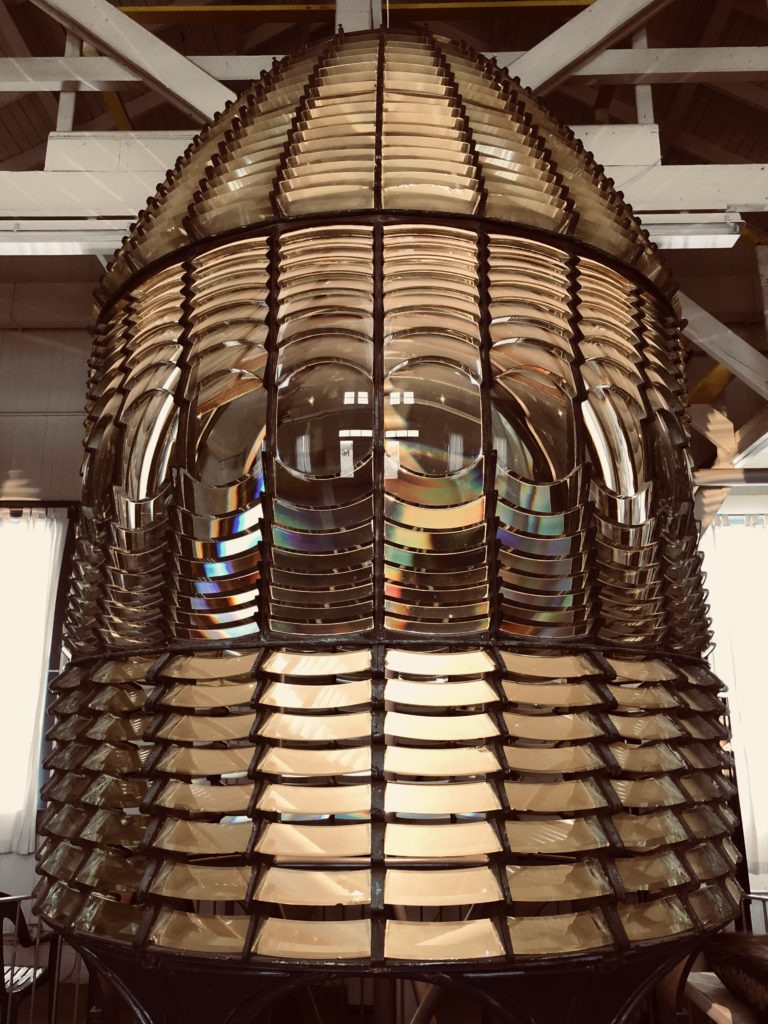
The Fresnel “beehive” design used glass prisms to bend and refract the light within to create a powerful beam. The lighthouse originally used a first-order Fresnel lens but now uses an automated one to aid navigation. Pigeon Point’s original first order lens was the largest size made. It is nearly eight feet tall, weighs 2,000 pounds, and is the biggest and strongest lens size. The lens was invented by Augustine Fresnel and consists of 1008 glass prisms. These prisms concentrate a light source within to project a strong beam over a great distance. The original Fresnel lens is now housed in the on-site museum. Pigeon Point Lighthouse had a specific pattern of a flash of light every 10 seconds to help ships identify their location. Pigeon Point also had a steam generated foghorn installed in 1899.

In 2001, brickwork supporting outside walkways on the top of the structure collapsed, and the lighthouse was closed to tours. Although you cannot tour Pigeon Point Lighthouse due to structural instability, you may explore the grounds on your own or follow a docent lead tour. It is sad to see such an amazing part of California history crumbling and deteriorating due to lack of funds to repair it. There currently are efforts by the California State Parks Foundation and the Coastside State Parks Association to raise private funds to restore the lighthouse and grounds. I hope they are successful!
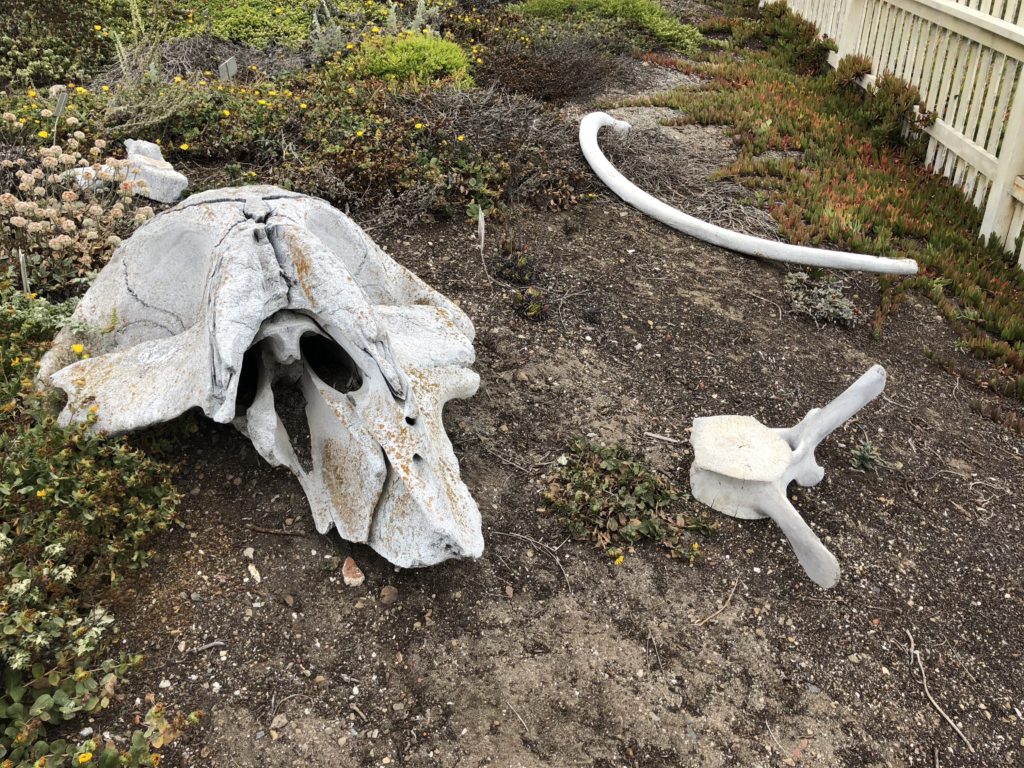
The skeletal remains of a whale are displayed on the grounds. Pigeon Point is a great place to view native wildlife, including humpback and gray whales, pelicans, cormorants, sea lions and harbor seals. You can also see a rocky island in Whaler’s Cove called Prisoner Rock because local fishermen were often trapped there during high tides. You may also enjoy seeing the remains of the Point Arena, a ship that was loading tanbark at Pigeon Point in 1913 when rough seas forced her onto the rocks, tearing a hole in her hull. You can still make out the ship’s name in the weatherbeaten wood.
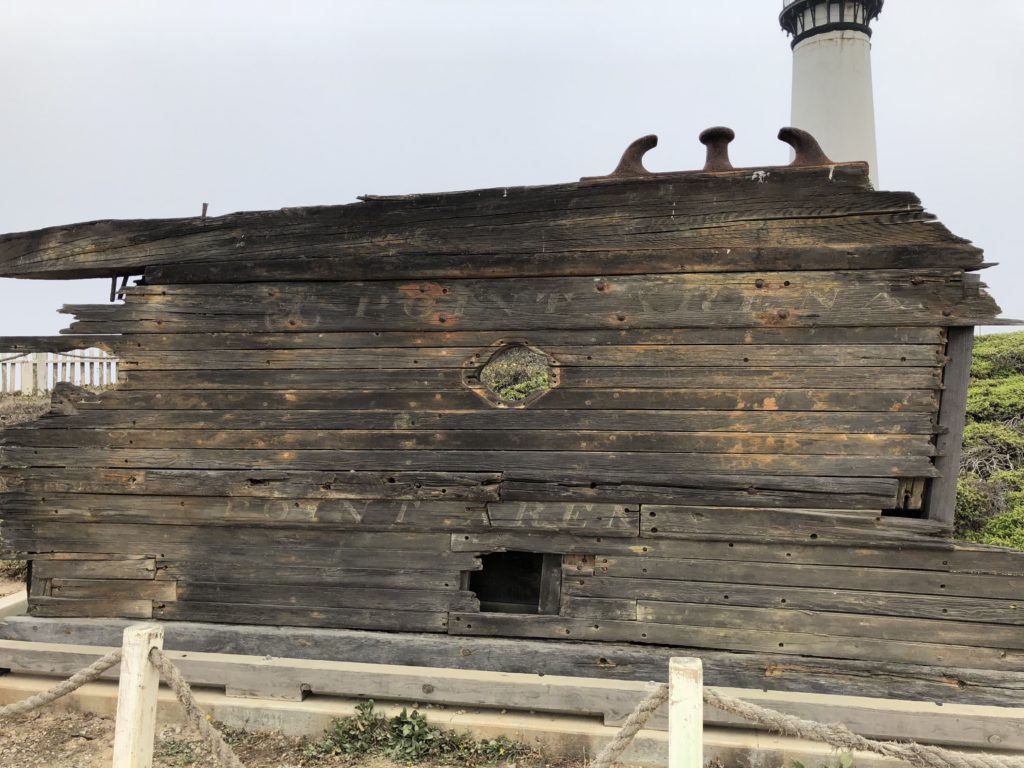
There are many meandering pathways and trails on the property to follow for great views of Whaler’s Cove. There is also a huge piece of driftwood which provides opportunities for photo ops!

Pigeon Point is a State Historic Landmark and is owned by California State Parks.
- Location: 210 Pigeon Point Road, Hwy 1, Pescadero, CA. It is 50 miles south of San Francisco and lies between Santa Cruz and Half Moon Bay.
- The phone number is 650-879-2120.
- Hours: 8 am to sunset.
- Admission is free.
- Half hour guided tours are available daily at 1 p.m.
- A museum and gift shop are open
- Pit toilets are available.
- Hostelling International rents cottages on site, see California Hostel
- Dogs, drones, and smoking are not allowed on the premises.
For more information on Pigeon Point Lighthouse, see Lighthouse and for more interesting history regarding this lighthouse see Lighthouse History
Thank you for visiting my blog! Wishing you peace, love, happiness, & beautiful vistas!
-
Delicious Places to Eat in Monterey on a Budget
Monterey is not only a beautiful coastal city but is also called the language capital of the world. Monterey’s ethnic and cultural diversity is reflected in the wide variety of food available here. Many restaurants in this area tend to be on the pricier end of the spectrum. But do not fear, there are tons of places here where you can find delicious food without emptying your wallet, if only you know where to look! If you are hoping to find some great, budget-friendly, delicious places to eat you have come to the right place!
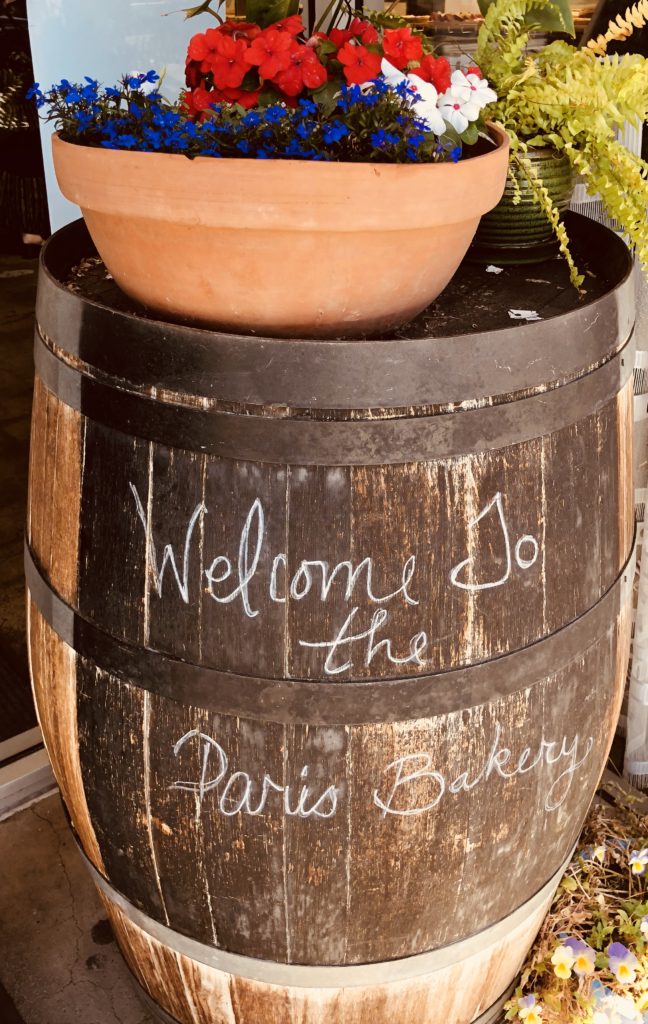
The Paris Bakery
- Open 7 days a week, this local favorite offers a fresh selection of pastries, soups, salads, fresh fruit, and sandwiches. The Paris Bakery is operated by the Jegat family from France 🇫🇷 who originally owned a bakery in, you guessed it—Paris!
- Cuisine: French
- Where: 271 Bonifacio Place, Monterey, CA 93940
- Hours: 6:00 am – 6:00 pm, Monday through Saturday, 6:30 am – 4:30 pm. Sunday.
- What to order: At lunch pick up a spinach, tuna tomato, or onion rosemary quiche for $4.50, or a croque monsieur, a delicious blend of ham, Bechamel sauce, and gooey Swiss Cheese on French bread. This is a large sandwich and you can easily split it between two people for only $6.00. Then, c’est magnifique! You will still have $$ left for espresso or dessert!
- Note: There are two locations, one in Seaside and one in old Monterey. I recommend the Monterey location because it is within easy walking distance to all the downtown shops and museums and is just a few blocks from Old Fisherman’s Wharf.
- Hot Tip: There is a huge parking garage two blocks west of the bakery in Monterey if you plan on heading out for shopping or sight-seeing after lunch.
- Helpful Links: Paris Bakery
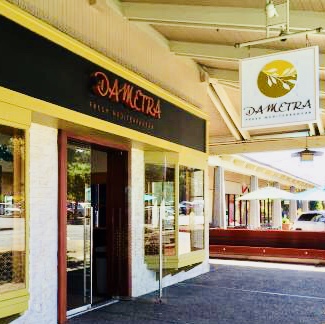
Dametra
- Dametra, at Del Monte Mall in Monterey, CA is the much cheaper, more casual sister restaurant to the more expensive but amazing Dametra Cafe in Carmel-by-the-Sea. While you won’t see belly dancers or listen to the kitchen staff crooning Greek songs tableside here, the food is just as delicious and very affordable.
- Cuisine: Mediterranean/Middle Eastern
- Where: 630 Del Monte Center, Monterey, CA 93940
- Hours: Open daily from 11:00am – 9:00pm
- What to order: Gyros, kabobs, chicken shawarma, falafel, dolmas, salads, baba ghanoush, and spanakopita. They also have Moroccan mint tea, Turkish coffee, beer, and wine. The most expensive item on the menu is the “plate” selection which includes your choice of meat or falafel, rice, and two sides (I usually pick a salad and spanakopita). You also receive freshly baked white or wheat pita bread. All for $9.95. The portions are huge, so bring your appetite.
- Note: There is seating both inside and outside. I usually prefer to sit at the window bar and people watch.
- Hot Tip: Spring $2.50 for the baklava, thin layers of phyllo dough filled with walnuts, pistachios & honey. You will not be disappointed.
- Helpful Links: Dametra
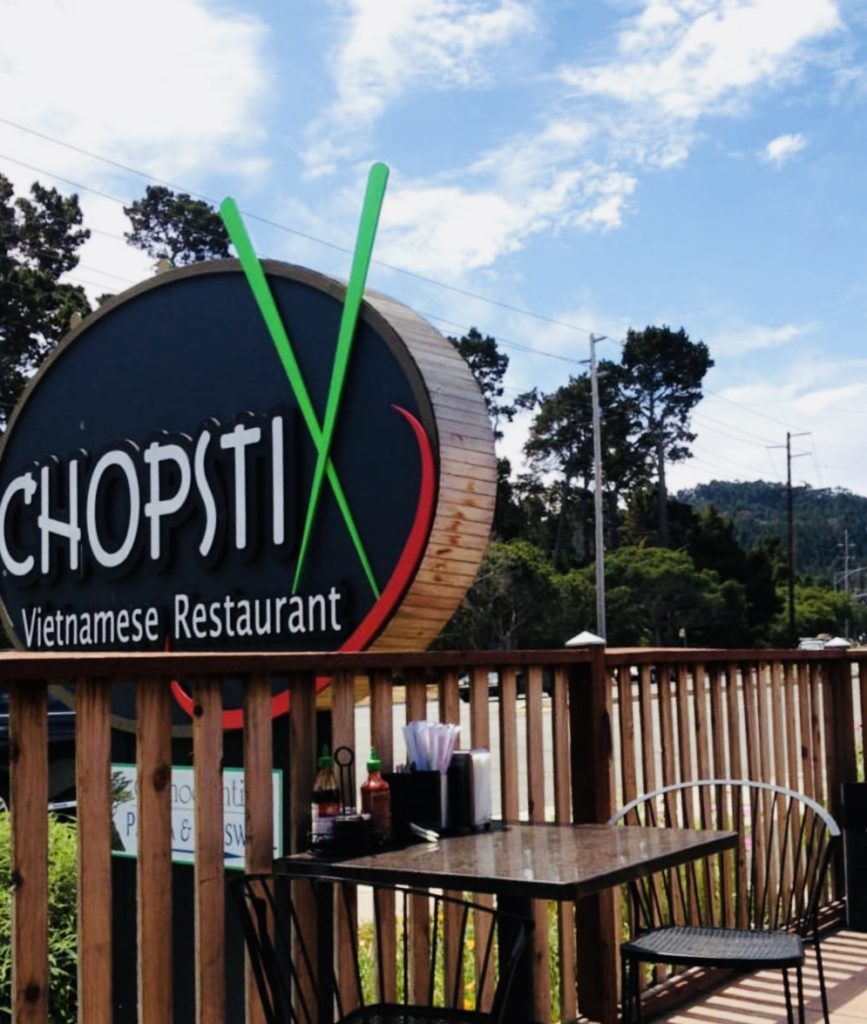
Chopstix
- You can’t beat the value you get for quality Vietnamese food here. Everything on the menu is less than $7.99.
- Cuisine: Vietnamese
- Where: 1244 Munras Ave., Monterey, CA 93940
- Hours: Open daily from 11:00 am-8:30 pm
- What to Order: Favorites include Vietnamese Egg Rolls, Pho Gà Chicken Noodle Soup, Lemon Grass Beef, Vegetarian Glass Noodles with Tofu, Mandarin Chicken Wings, and Vietnamese BBQ Pork Chops.
- Note: The restaurant is fairly small and may fill up quickly during peak meal times, I recommend making reservations, OR order take out and head to Del Monte Beach for a picnic.
- Hot Tip: Try their Vietnamese coffee or choose from their dozens of flavors of milk tea and Boba!
- Helpful Links: Chopstix
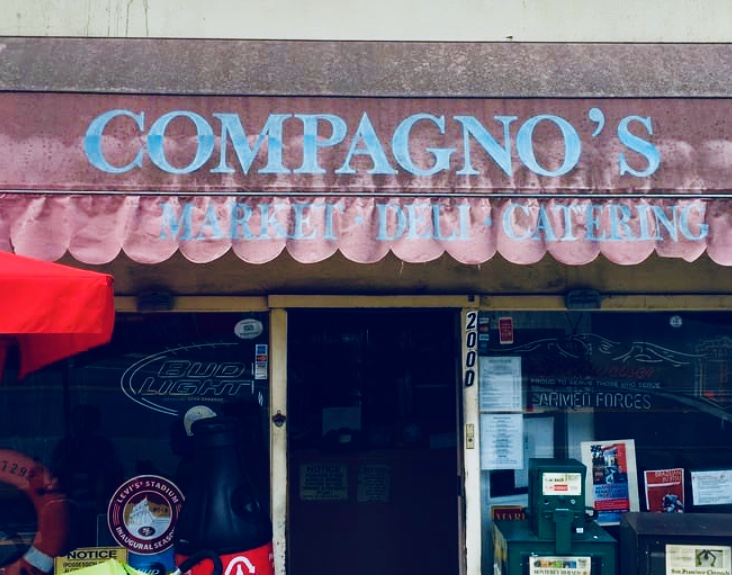
Compagno’s Market & Deli
- This beloved Monterey market has been keeping Defense Language Institute students and Monterey regulars well fed for over forty years. They were voted best deli sandwich in Monterey and it is easy to see why! The sight of these ginormous subs with their super fresh and tasty fillings will astonish you.Cuisine: Italian-American
- Where: 2000 Prescott Ave. Monterey, CA 93940
- Hours: Open daily 9:00 am-4:00 pm
- What to order: I recommend the Hoagie with salami and mortadella or the chicken salad with almonds on either the soft baked or Dutch crunch bread. Order a half size sub for $8.99-$9.99 and it is still big enough give you two meals. For two people order a full size for $11.50-$12.50 and save even more. If you are vegan, no worries, they offer a delicious no-meat sub with sprouts, mushrooms, avocado, cucumber, and bell peppers.
- Note: This place is somewhat off the main drag in the middle of a residential neighborhood and has a teeny tiny parking area on the west side that rapidly fills during peak lunch time, it is best to arrive early.
- Hot Tip: Take your subs down the hill to San Carlos Beach, which marks the end of Cannery Row, at the intersection of Cannery Row and Reeside Avenue and watch the scuba divers at this popular dive area.
- Helpful Links: Compagnos
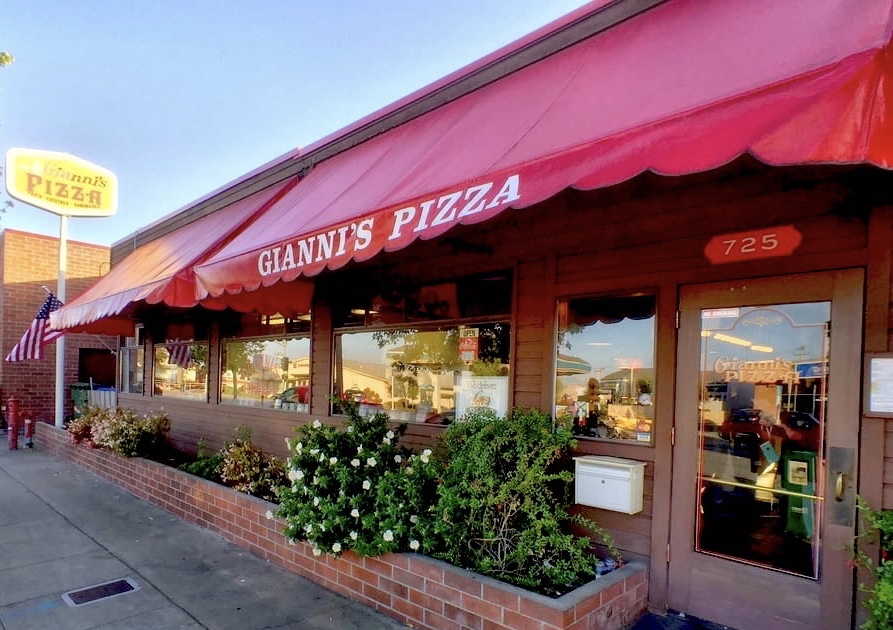
Gianni’s
- This well-known pizza joint has not only great pizza but also sandwiches, pasta, and calzones. Pizzerias come and go, but this one stands the test of time, and for good reason.
- Cuisine: Italian
- Where: 725 Lighthouse Ave., Monterey, CA 93940
- Hours: Monday-Thursday 3:30 pm-9:30 pm, Friday-Saturday 11:00 am-10:30 pm, Sunday 11:00 am- 9:30 pm
- What to order: Try the mouthwatering meatball sandwich for $8.37 or the linguine & clams marinara for $10.94.
- Note: The parking lot fills up quickly during peak times, you may want to make reservations and arrive a bit early if you want to be seated on time
- Hot Tip: This is within walking distance of the world-famous Monterey Bay Aquarium.
- Helpful Links: Giannis
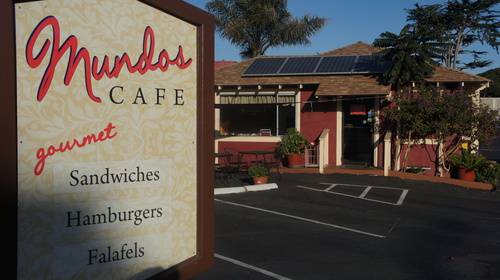
Mundo’s
- Mundo’s is close to downtown Monterey and has great food for great prices. They are fur baby friendly, so you can take Fido with you!
- Cuisine: American
- Where: 170 Webster St., Monterey, CA 93940
- Hours: Monday-Friday 10:00 am-7:00 pm, Saturday-Sunday 10:00 am-5:00 pm
- What to order: Try the spicy tuna melt for $9.29 or the grilled eggplant sandwich for $7.99. They also offer Curry Chicken Salad with Ciabatta or Tortilla Wrap for $6.99. The ciabatta bread is what makes the cake: it’s done perfectly–lightly crunchy on the outside and soft on the inside.
- Note: They do not take reservations or deliver
- Helpful Links: Mundos

Monterey’s Fish House
- It is Monterey, so you have to try seafood, right? I recommend Monterey’s Fish House. There are always long lines here, night after night, and for good reason!
- Cuisine: Seafood
- Where: 2114 Del Monte Ave., Monterey, CA 93940
- Hours: Lunch: Monday-Friday 11:30 am – 2:30 pm, Dinner: Monday-Sunday 5-9:30 pm
- What to order: Try a bowl of their delicious clam chowder for $6.95 or split an entree; the portions are very large. I recommend it ALL. There are no bad choices here!
- Hot Tip: Make reservations or you may end up waiting in line for an hour or more
- Helpful Links: Monterey’s Fish House
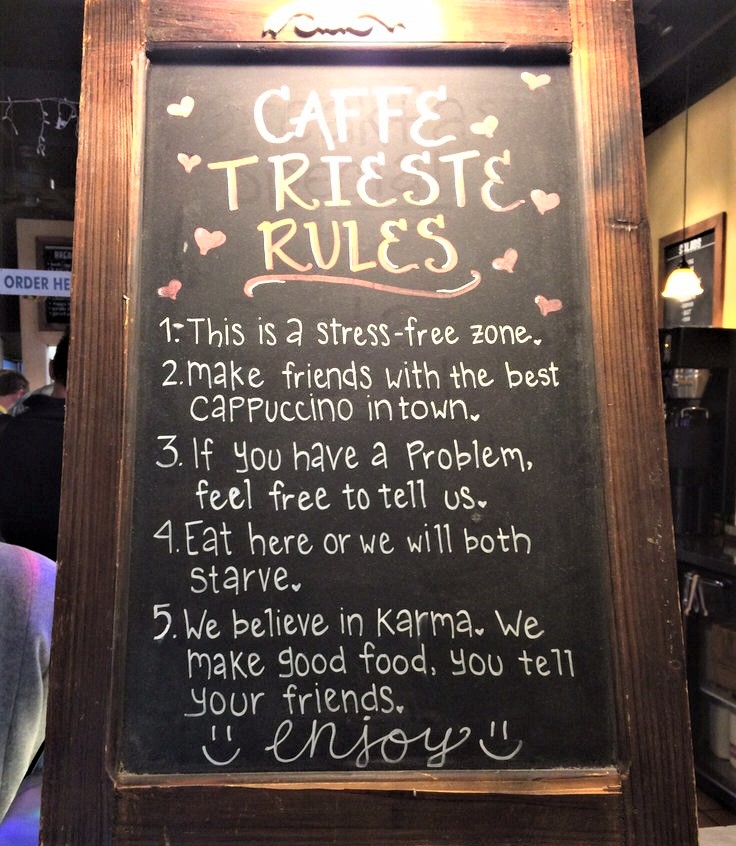
Caffe Trieste
- Located in downtown Monterey, close to shopping & the wharf.
- Cuisine: Italian
- Where: 409 Alvarado Street, Monterey, CA 93940
- Hours: Open daily from 7:00 am -10:00 pm
- What to order: Try the Tonno Melt or Veggie Panini for $9.99
- Hot Tip: Sit outside and enjoy the fresh air and Monterey vibes. On Friday and Saturday nights, there is great live music!
- Helpful Links: Caffe Trieste
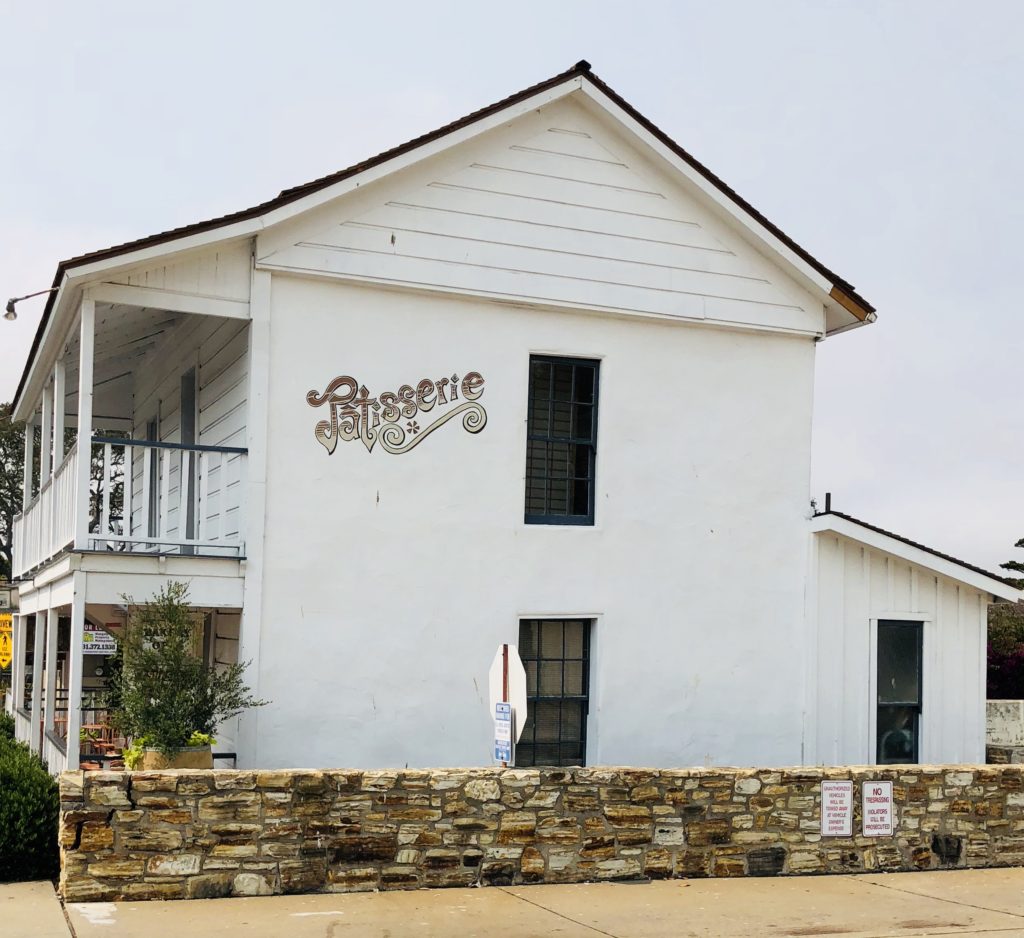
Parker-Lusseau Pastries
- Housed in the historic Fremont Adobe building and close to downtown shops and Colton Hall Museum
- Cuisine: French
- Where: Three locations, but my favorite is 539 Hartnell St., Monterey, CA 93940
- Hours: Monday-Friday, 7:00 am -5:30 pm, and Saturday 7:30 am- 4:30 pm
- What to order: Favorites include the turkey with honey dijon on a Croissant for $7.25, Portabella & Leek Quiche for $6.50 and the daily cup of soup for $4.75. If you want to go straight for dessert, the Almond Croissant is to die for, $5.50
- Hot Tip: Sit outside at the tangerine colored tables and people watch
- Helpful Links: Parker Lusseau
-
Sand Dollar Beach & Jade Cove in Big Sur
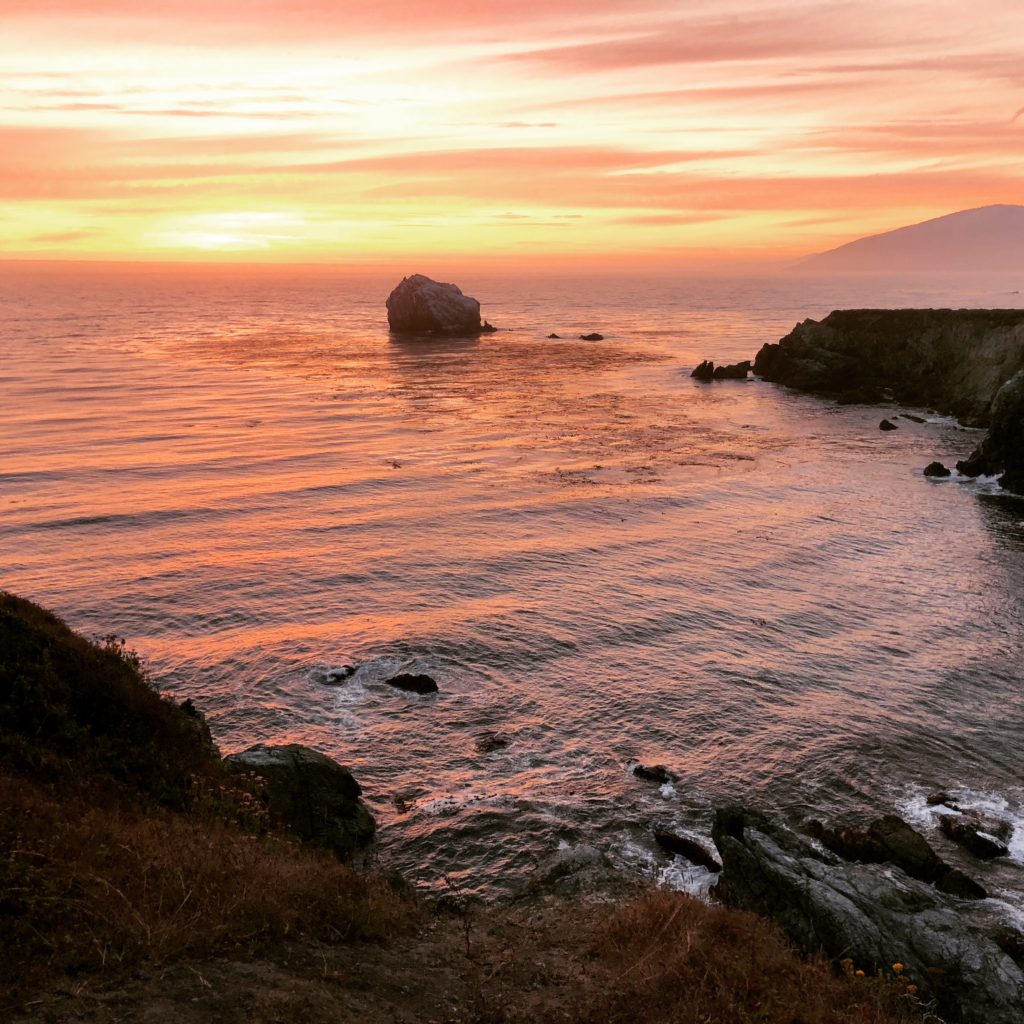
Sunset at Jade Cove in Big Sur We are heading south on Hwy 1 on a jade mission. An hour and 45 minutes after leaving Carmel, we spot it. The rinky-dink parking lot across from the Plaskett Creek Campground. Sand Dollar Beach awaits!
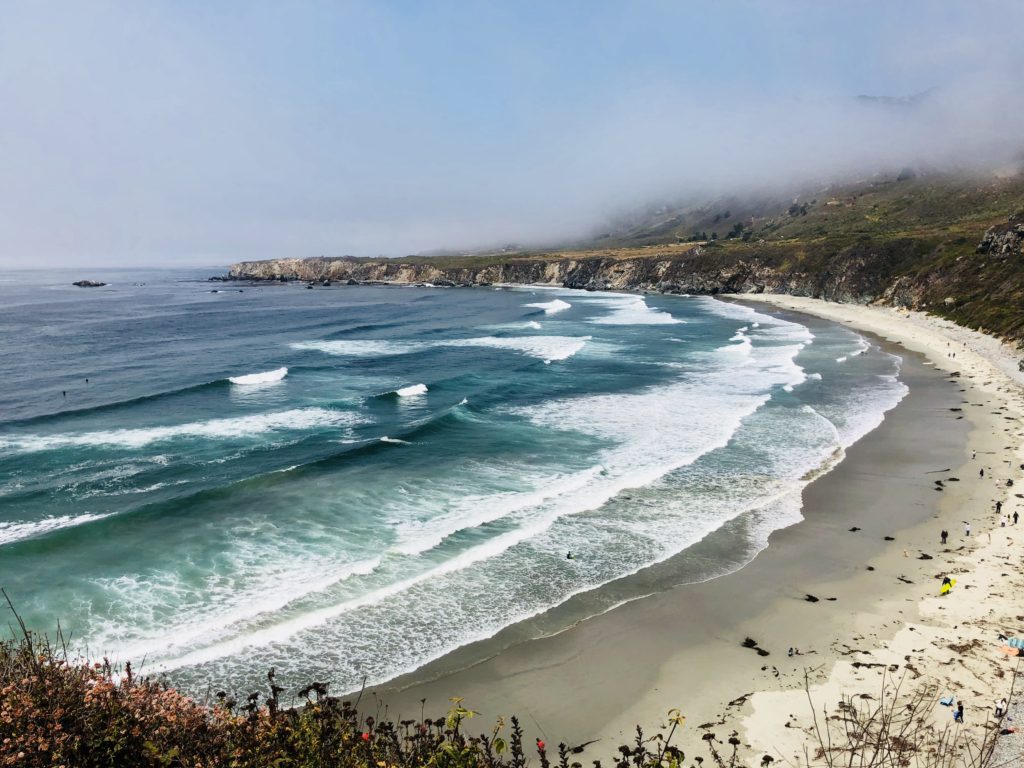
Sand Dollar Beach is the Largest Beach in the Area To get to Sand Dollar Beach, take the wide dirt path running parallel to the parking lot. The hike is .5 miles round trip. Start at the northwest corner of the parking lot and follow the trail for until you reach the steps leading 40 feet down to Sand Dollar Beach. It is extremely isolated and quiet here. There is no cell service, it vanishes shortly after you exit the south end of Carmel. No sound but the ponderous crash of waves as they break onto the beach and the whispering of the wind through the foxtails. Jagged cliffs plunge recklessly below to the sea. The rolling prairie above the beach is punctuated by several meandering trails. Many of these end abruptly and are surrounded by poison oak, however, some lead to breathtaking cliff top views of the beach.
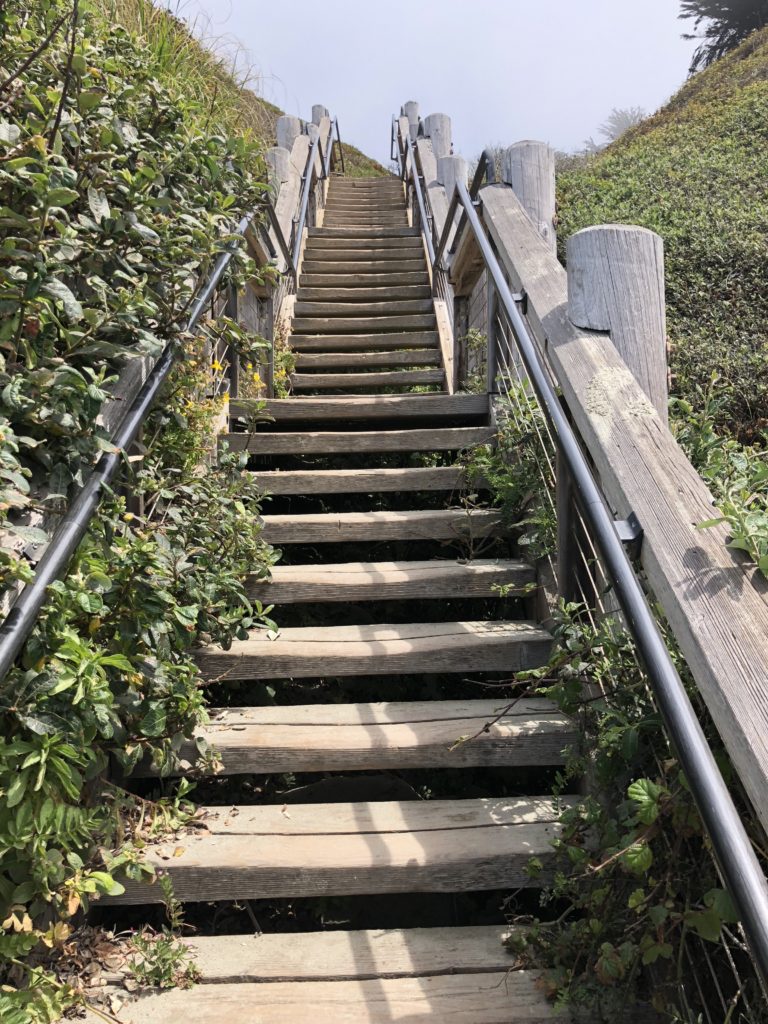
The Stairs Leading to Sand Dollar Beach There are many fun activities here including hiking, fishing, picnicking, and sunbathing. The beach is the largest in the area, a crescent-shaped arc of soft, white sand stretching for over half a mile. Surfing is also big here. Sand Dollar Beach is rated as one of the best surfing spots along this section of the coast. In addition, the level bluffs above the area are a designated hang glider and paraglider landing area. You may also see gray whales, elephant seals, sea otters, or shorebirds such as cormorants, brown pelicans, plovers, and gulls.
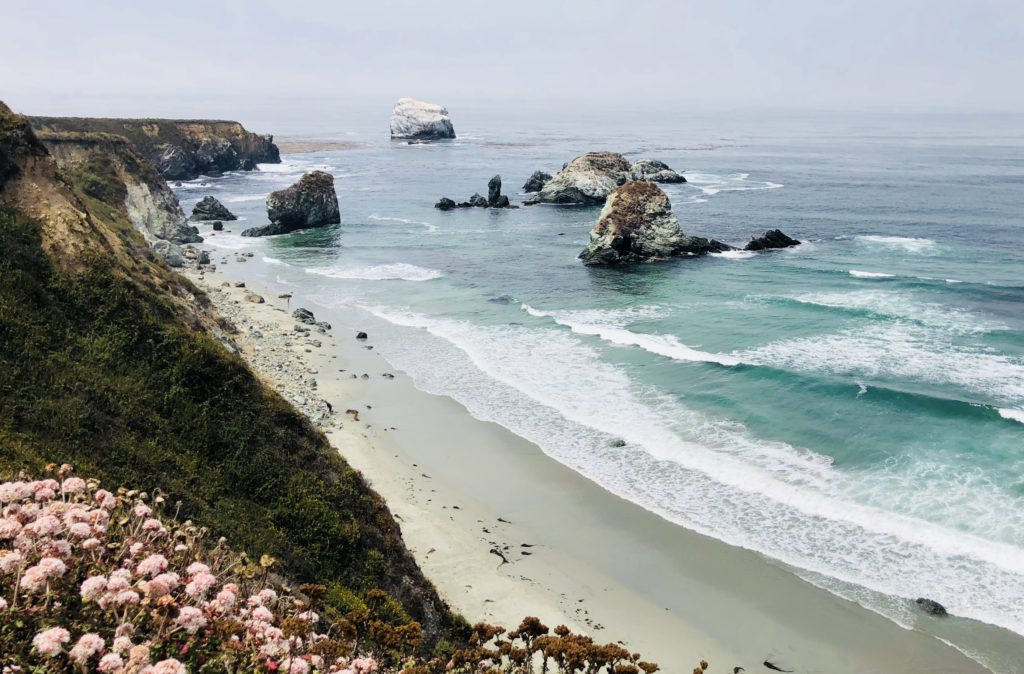
After you are done at Sand Dollar Beach, hike back to where you are parked and head further south for about 1/2 mile until you see a small pullout on the right side of Hwy 1. The trailhead to Jade Cove is unmarked, ostensibly to protect the area from overly ambitious jade seekers. Follow this trail straight back. Large jade boulders extend into the ocean and offshore you can see the picturesque 100-foot high Cave Rock, whose walls of jade are continuously pummeled by the crashing waves. As you near the ocean, follow the trail to the left through coastal grasses and wildflowers. You will pass three more boulders and then, when you see a pine tree, you are near the trail’s final descent to Jade Cove. The round trip hike is 1.5 miles.
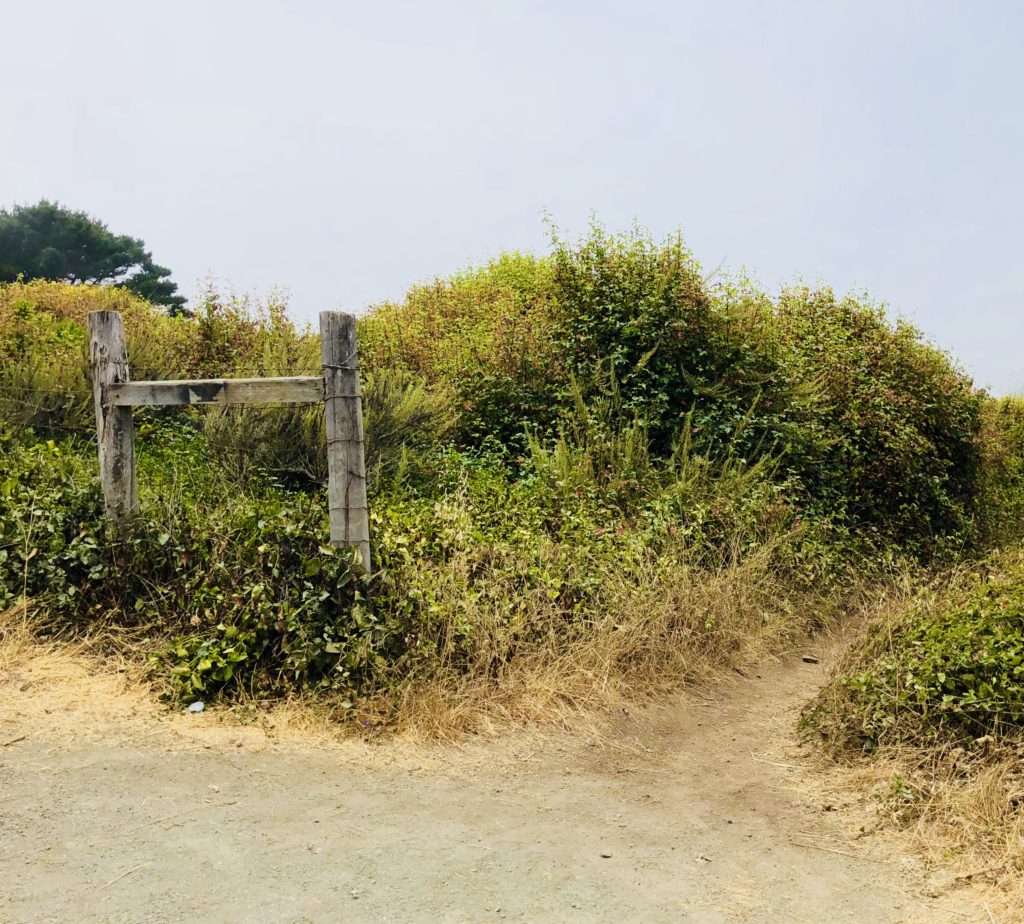
The Unmarked Trailhead to Jade Cove Jade has been prized for thousands of years and was considered the “imperial gem” in China. It has been used throughout history for tools, weapons, jewelry and religious objects. It has even been used for its metaphysical properties; some people use it for a talisman, for feng shui, or practice “jade rolling” which is said to draw out negative energy and balance your chi. Jade Cove in Big Sur is the hang out for jade-a-holics who diligently search along the beach or even perform meticulous dives off the coast in search of the beautiful mineral. There is even an annual Big Sur Jade Festival held nearby. People come from all over the world to the three-day fall event to sell and showcase their work, ranging from tiny, delicate pieces of jewelry to huge slabs of stone harvested from the sea.
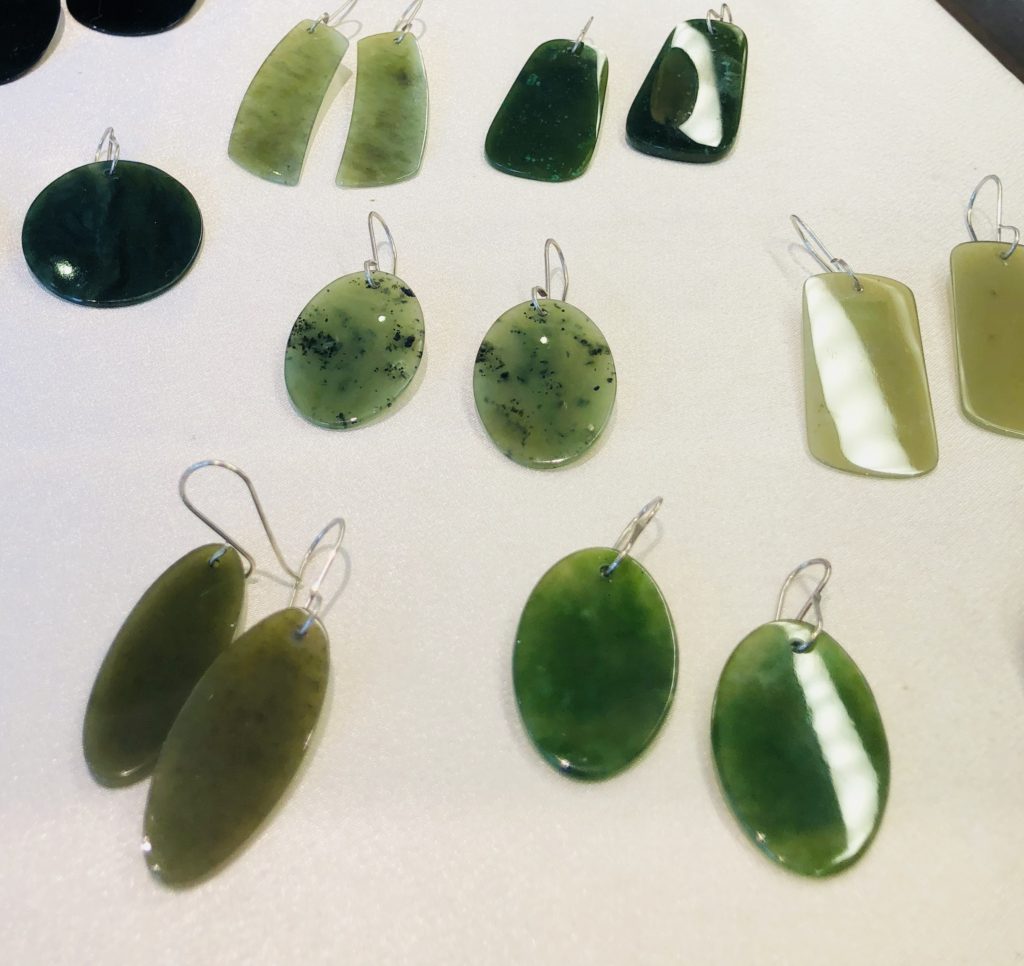
Jewelry made from Big Sur Jade; available at Nepenthe I recently met a girl running on the path to Jade Cove named Joy, who said she often finds jade there and makes it into jewelry which she occasionally sells at her mother’s shop in Pacific Grove, the Rabbit Hole. She kindly showed me what real Big Sur Jade looks like and when I returned home, I did additional research online for information that can help identify it. Apparently, the most problematic look-alike in the area is serpentine. The difference between serpentine and jade is that jade is much, much harder. How hard? If you scrape it with a pocket knife or can opener, serpentine will easily scratch, but jade will not. There are other tips offered including spitting on the stones, licking the salt off them, etc. I cannot vouch for any of these techniques.
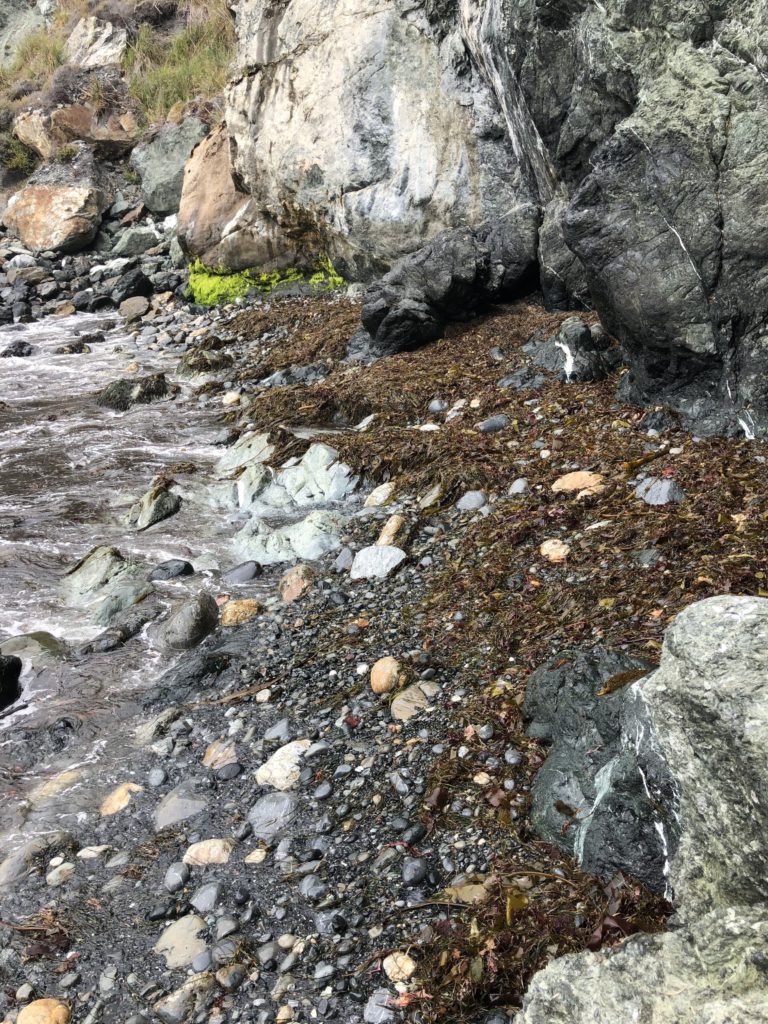
Who knows what the tide will bring in at Jade Cove! It is always a treasure hunt here. Be aware that there are regulations regarding removing jade from the area. 1. Only loose jade from submerged lands may be collected, from below the mean tide level. 2. No tools may be used except a hand tool to maneuver and lift the jade or scratch its surface to determine its authenticity. 3. Divers may use lift bags with a combined capacity of not more than 200 pounds. For more information on regulations see: montereybay.noaa.gov
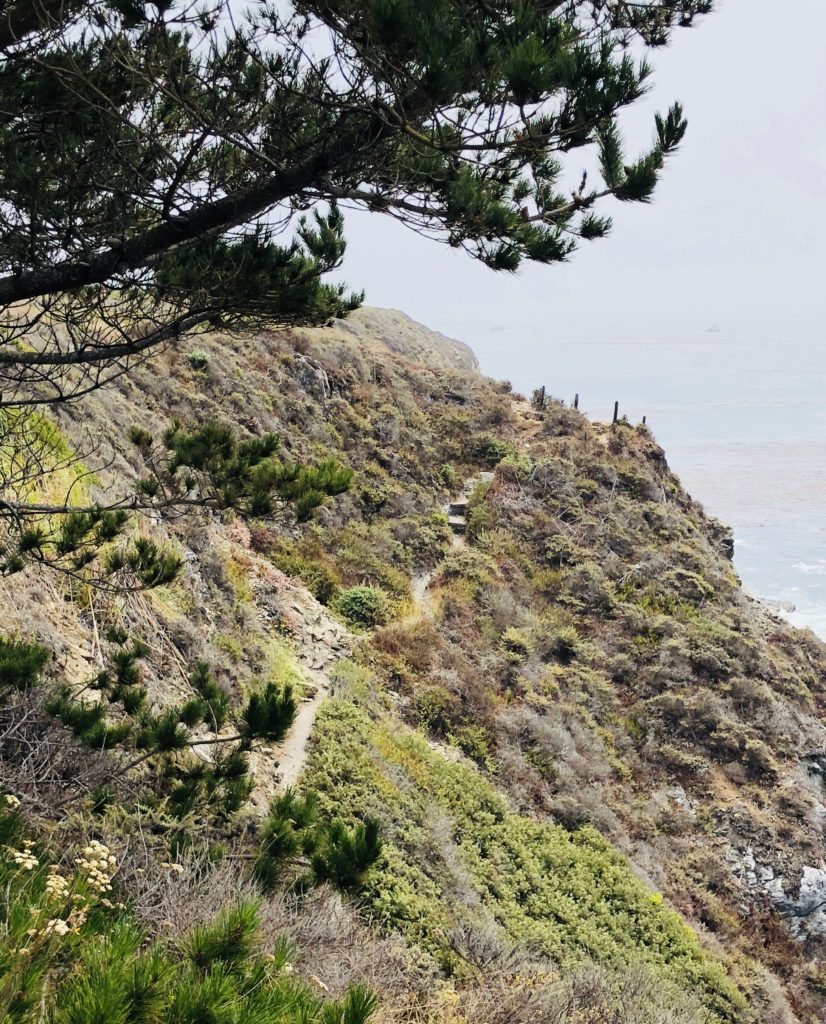
The Rambling Trail to Jade Cove Despite their rugged beauty, Jade Cove and Sand Dollar Beach can also be quite dangerous. Swimming and wading are not recommended due to dangerous rogue waves and strong rip currents. Hiking down the steep and at times slippery and ambiguous path to Jade Cove can also be a bit challenging and is not recommended for inexperienced hikers. There is a rope to hold onto at the bottom of the trail to facilitate a safe descent. Be sure to wear long sleeves, head covering and tick repellent if you will be hiking through the brush. The area is known for harboring ticks and people often leave with unintended guests, much to their chagrin.
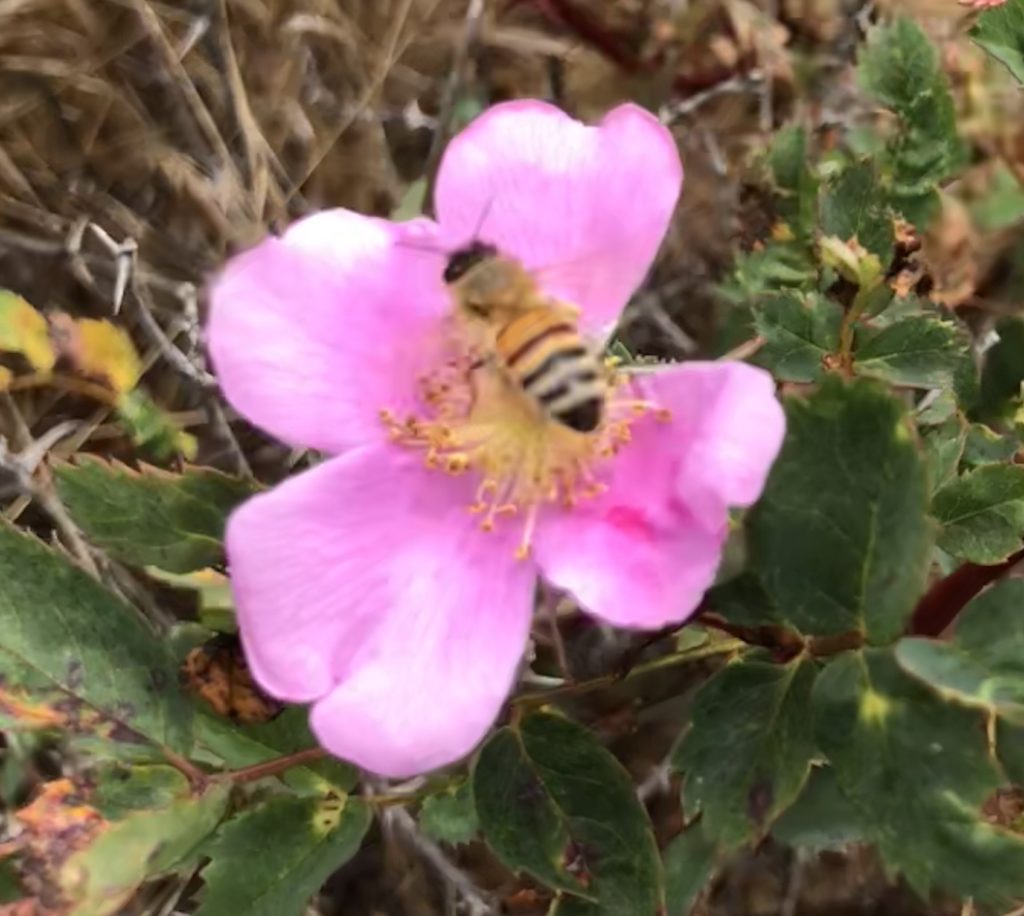
Wild Roses Growing Along the Jade Cove Trail To reach Sand Dollar Beach and Jade Cove, travel south approximately 60 miles from Rio Road in Carmel on Hwy 1 or 30 miles north of San Simeon. No camping is permitted except at Plaskett Creek Campground, located directly across Hwy 1 from the parking lot and also at nearby Kirk Creek Campground. A parking lot, picnic tables, and restrooms are available at Sand Dollar Beach, but there is a 10.00 fee to park there. If you camp at Kirk Creek or Plaskett Creek Campgrounds you can use the Sand Dollar Beach Day Use Area without paying the fee. There are also numerous turnouts nearby along Hwy 1 where you can park for free. Sand Dollar Beach and Jade Cove are open daily from sunrise-sunset and are day use only. Dogs on leashes are allowed. No bonfires are allowed on the beach.
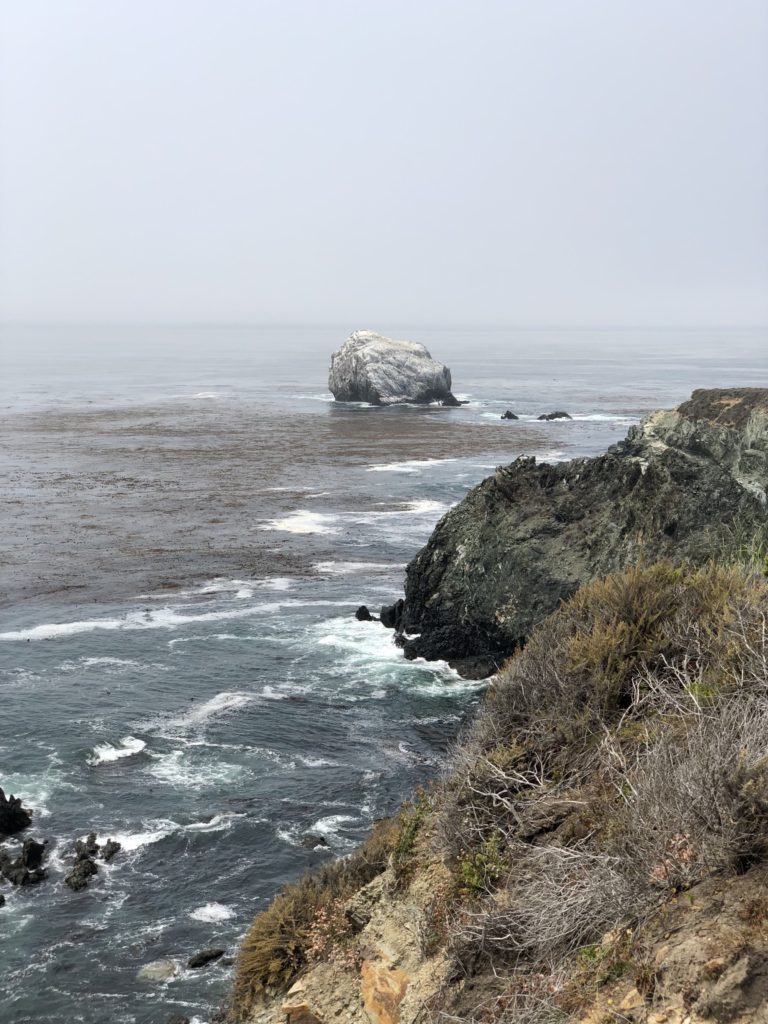
Thank you for visiting my Blog! Wishing you peace, love, happiness & beautiful vistas!
-
The Garden Gate Story: Inspiration from Carmel-by-the-Sea
Every garden has a story to tell. The beginning of that story is your garden gate entrance. Your garden reflects who you are and what is important to you. Let these gorgeous garden gates in Carmel-by-the-Sea provide inspiration for your own unique and special garden.
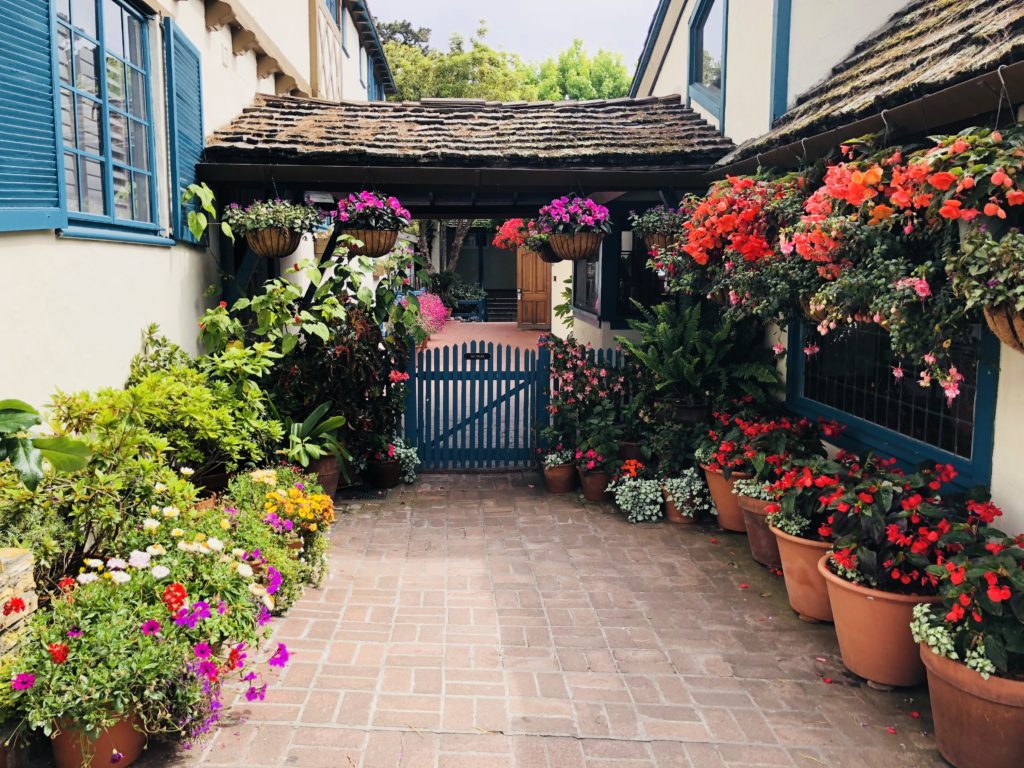 Gardens evolve and grow, and with them, your story grows. What glimpse of your life do you want friends and family to have? Your gate sets the tone for the beginning of the story. Your gate lets everyone know the intention of your story. Is your gate inviting? Does it have bright colors or entice with warmth? Is it more private, implying mystery and intrigue? Whatever it is, your story begins with your gate. It should suggest what we may expect to see once we enter your garden.
Gardens evolve and grow, and with them, your story grows. What glimpse of your life do you want friends and family to have? Your gate sets the tone for the beginning of the story. Your gate lets everyone know the intention of your story. Is your gate inviting? Does it have bright colors or entice with warmth? Is it more private, implying mystery and intrigue? Whatever it is, your story begins with your gate. It should suggest what we may expect to see once we enter your garden.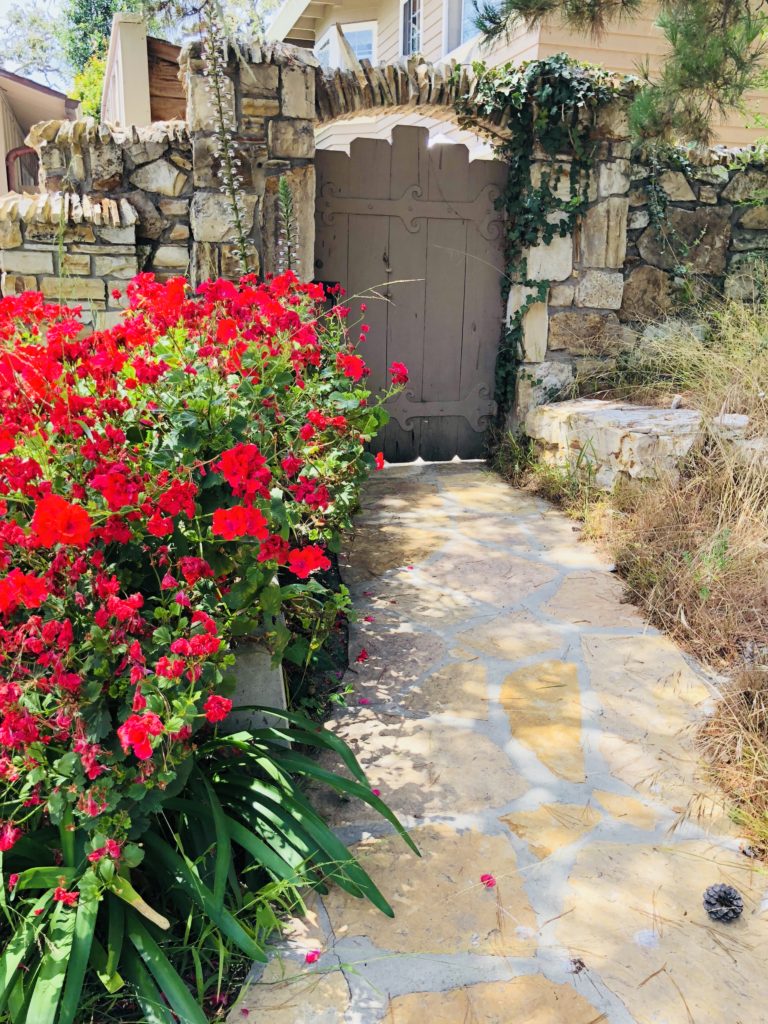
Show me your garden and I shall tell you what you are–Alfred Austin
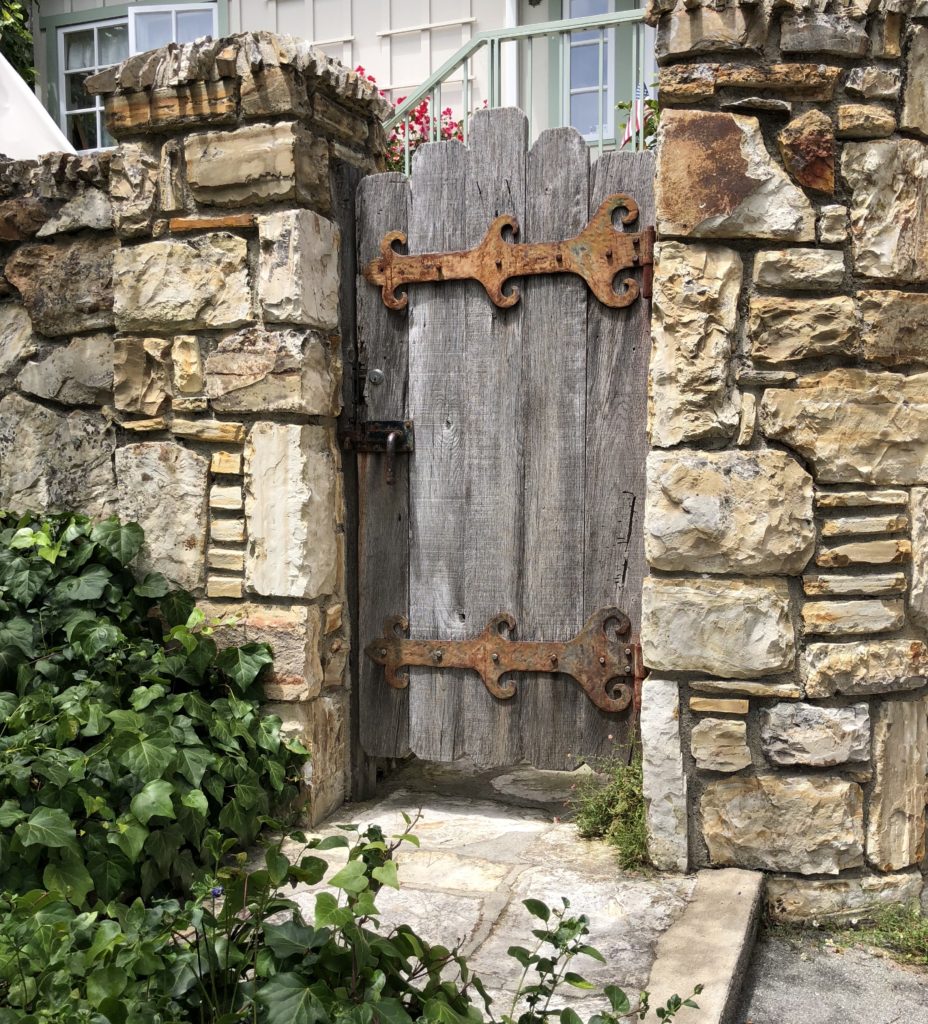
This rustic hinged wooden gate set into stone is typical of the fairy tale style homes peppered throughout Carmel-by-the-Sea.
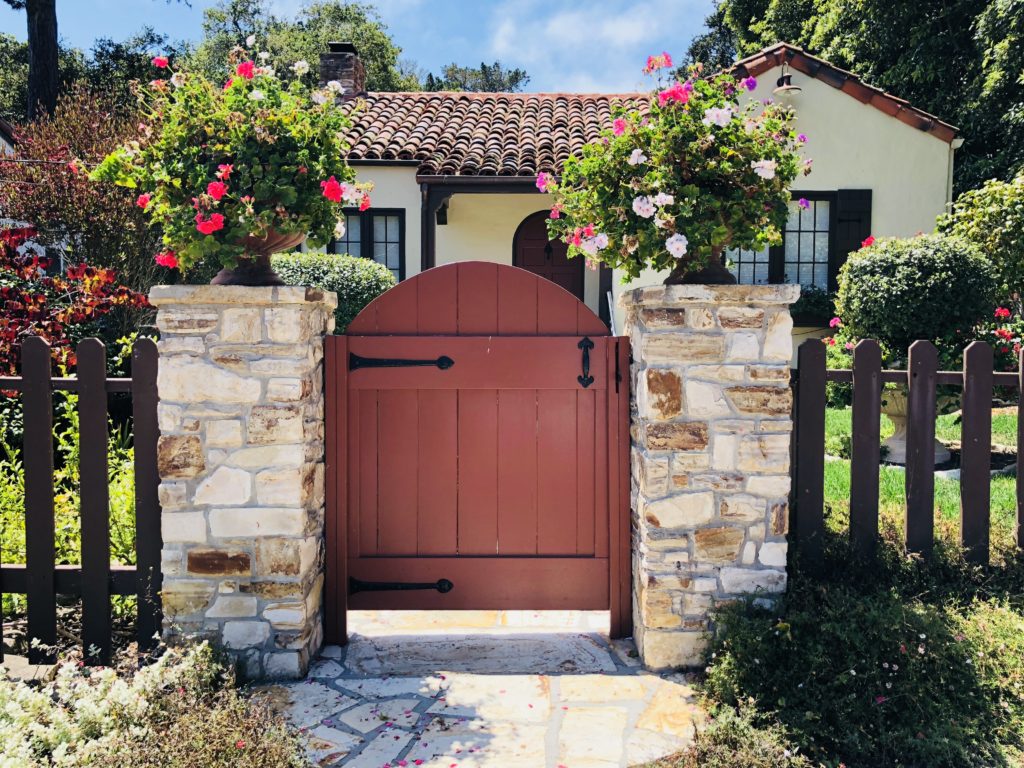
Gardening is the art that uses flowers and plants as paint and the soil and sky as canvas–Elizabeth Murray
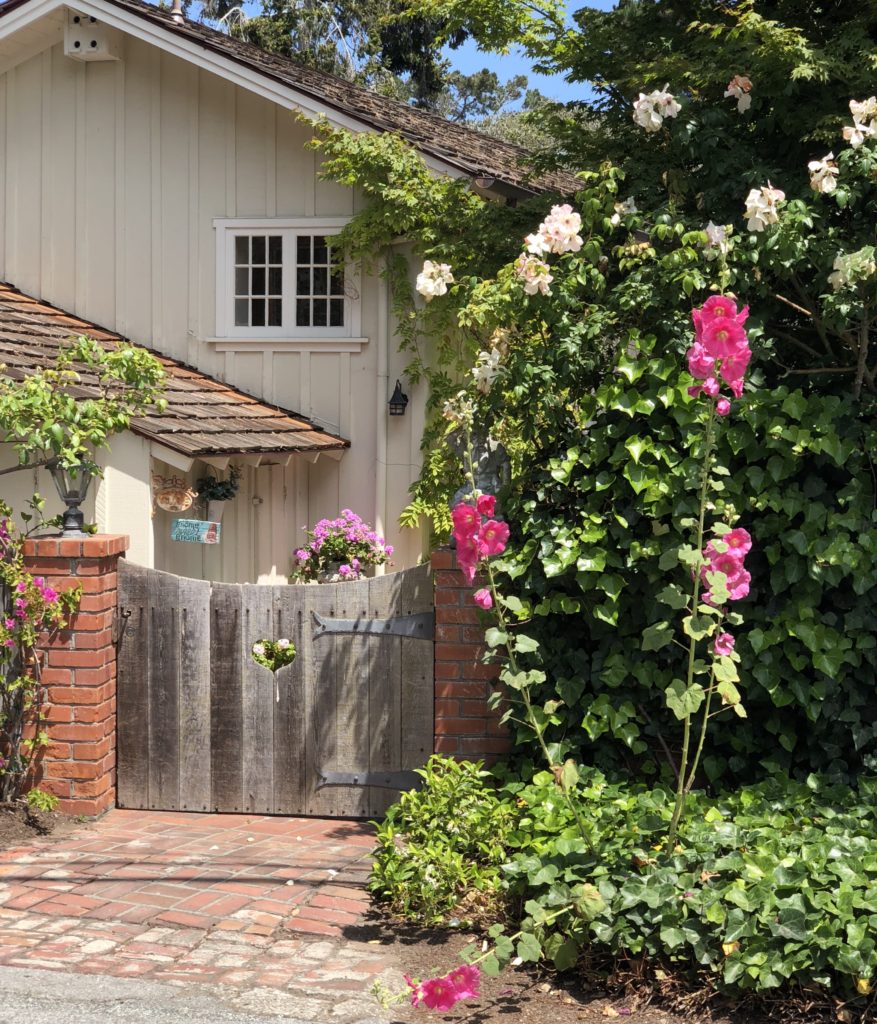
The use of a small heart cut-out in this garden gate, hollyhocks & roses, give this cottage garden depth & charm.
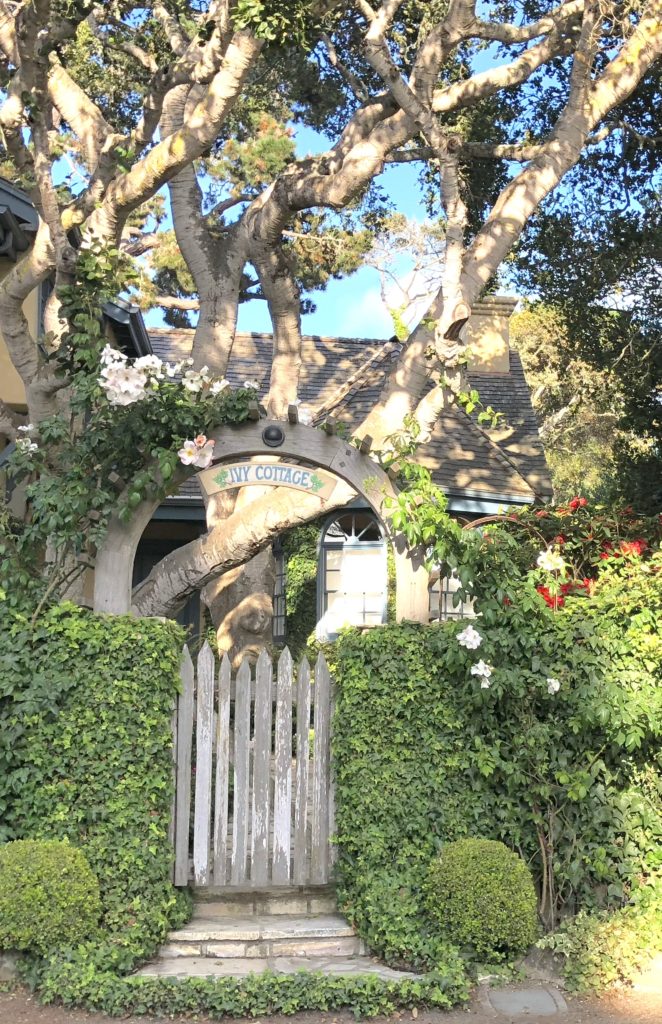
Always throw spilt salt over your left shoulder, keep rosemary by your garden gate, plant lavender for luck, and fall in love whenever you can–Alice Hoffman, “Practical Magic”
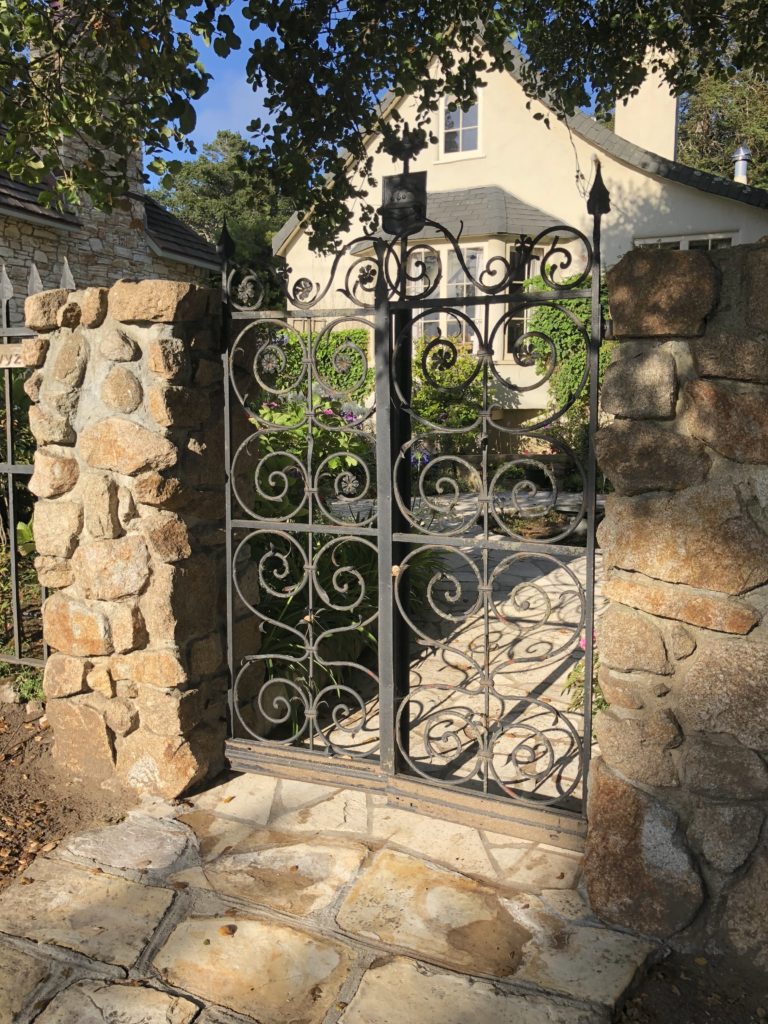
Out of the window, I can see them in the moonlight, two silhouettes saying goodnight by the garden gate–Ray Davies, “Come Dancing”
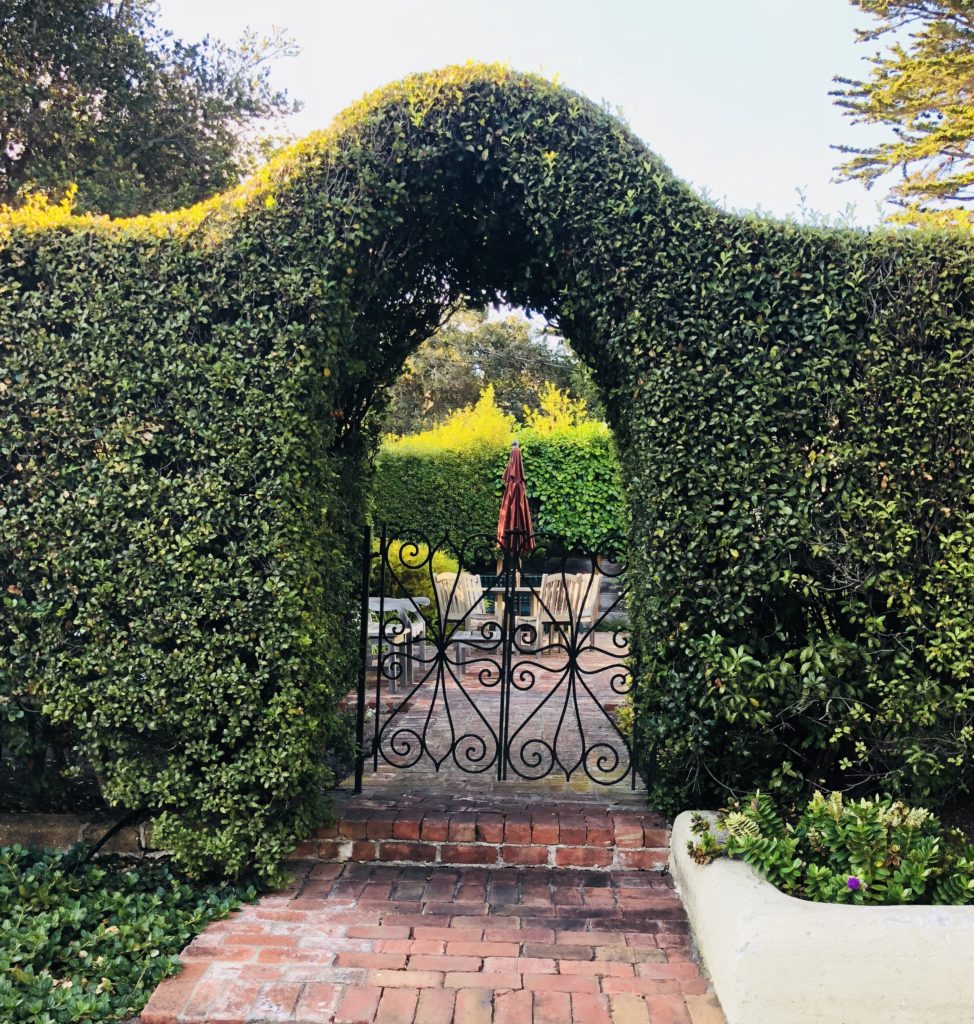
Framed by a sculpted hedge, this arched gateway leads to a secluded garden.
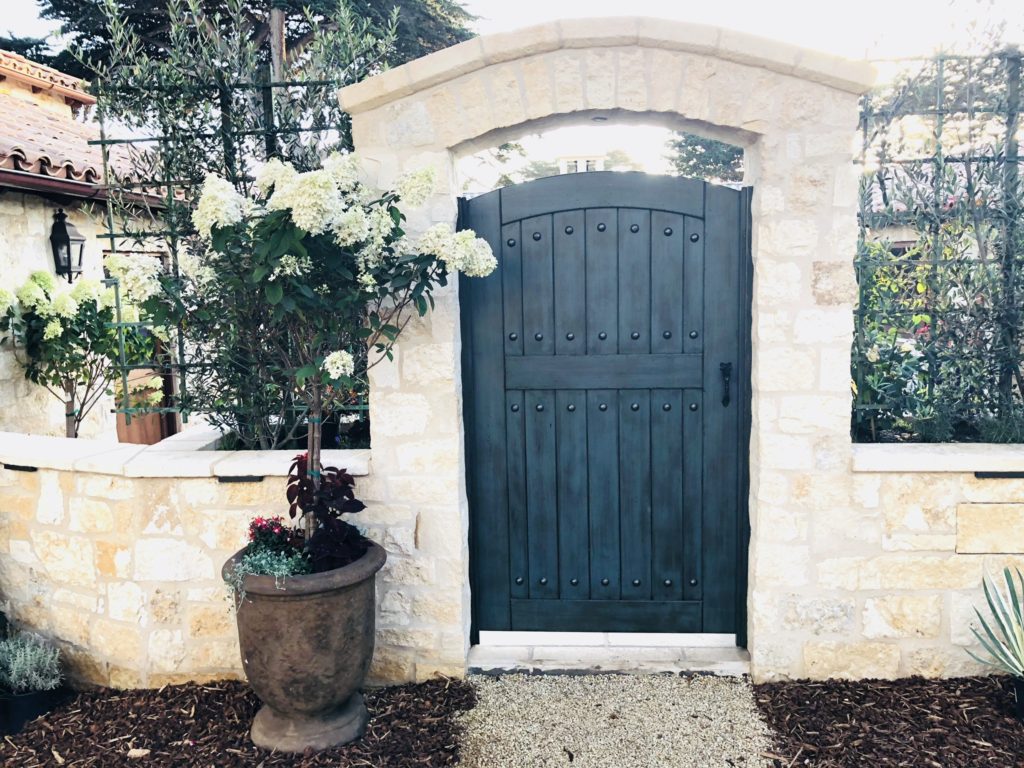
A garden must combine the poetic and the mysterious with a feeling of serenity and joy–Luis Barragan
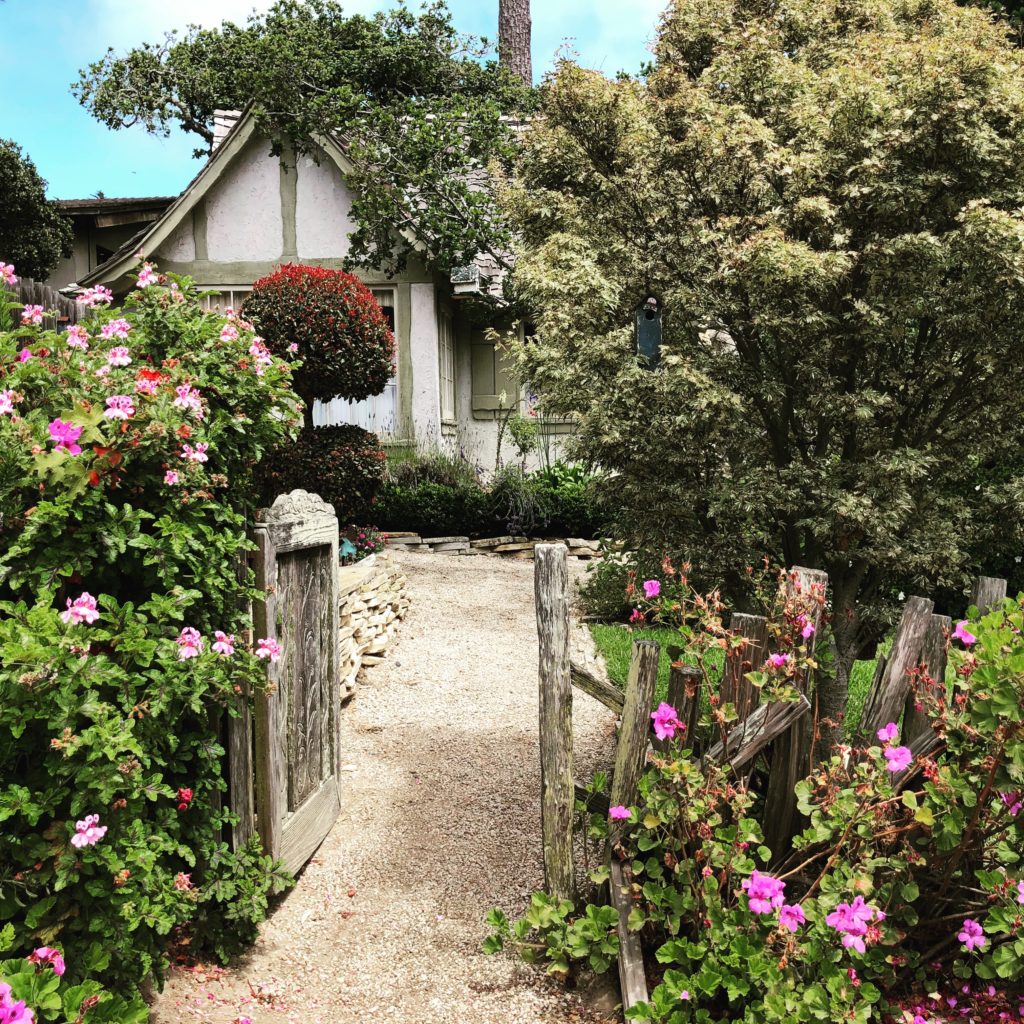
This open garden gate framed by geraniums conveys a sense of warmth and welcome, inviting guests to enter.
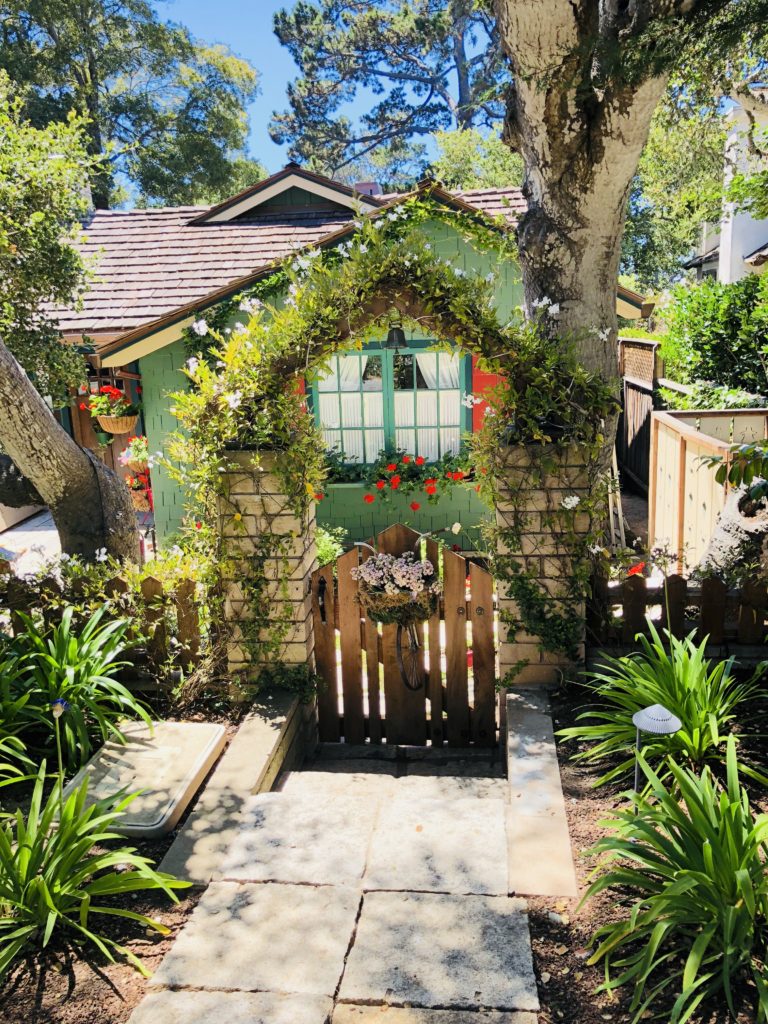
Charming and colorful green and red decor and a hanging bell set this garden gate apart. Note the unique bicycle decor also.
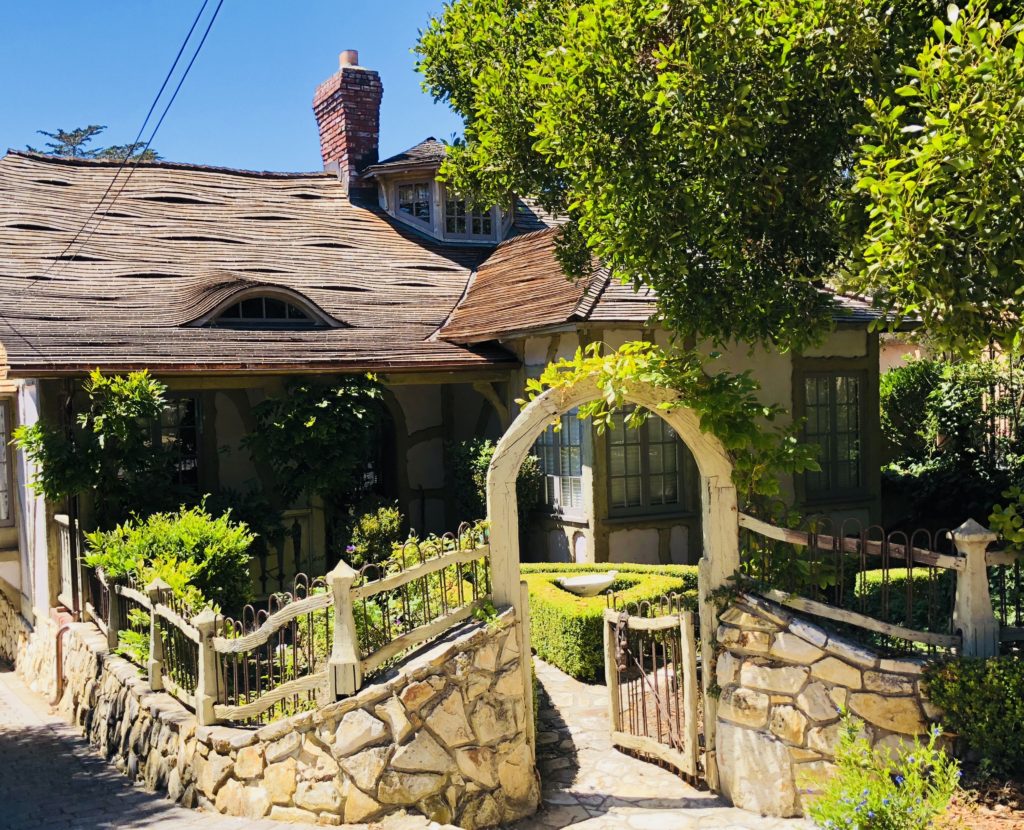
This garden gate is very symbolic of the fairy tale cottage look in Carmel-by-the-Sea.
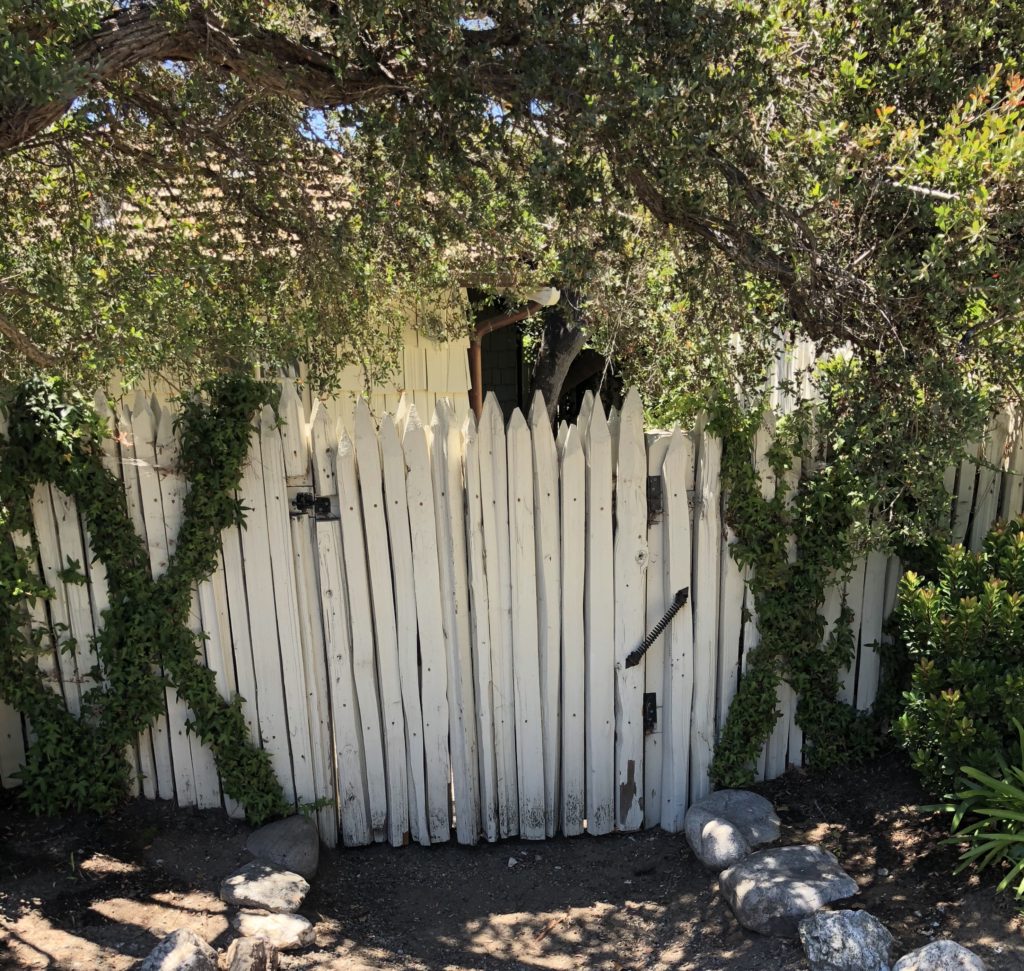
A simple and classic white garden gate is dressed up with ivy trained to form an x design.
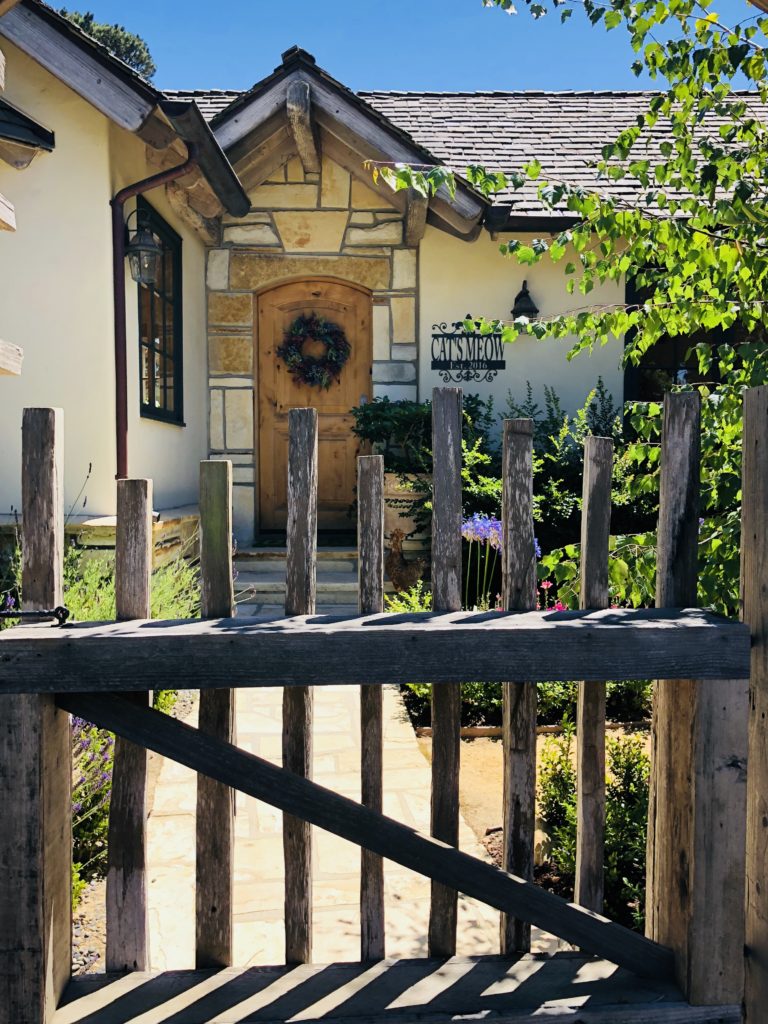
This garden gate is the cat’s meow! Literally.
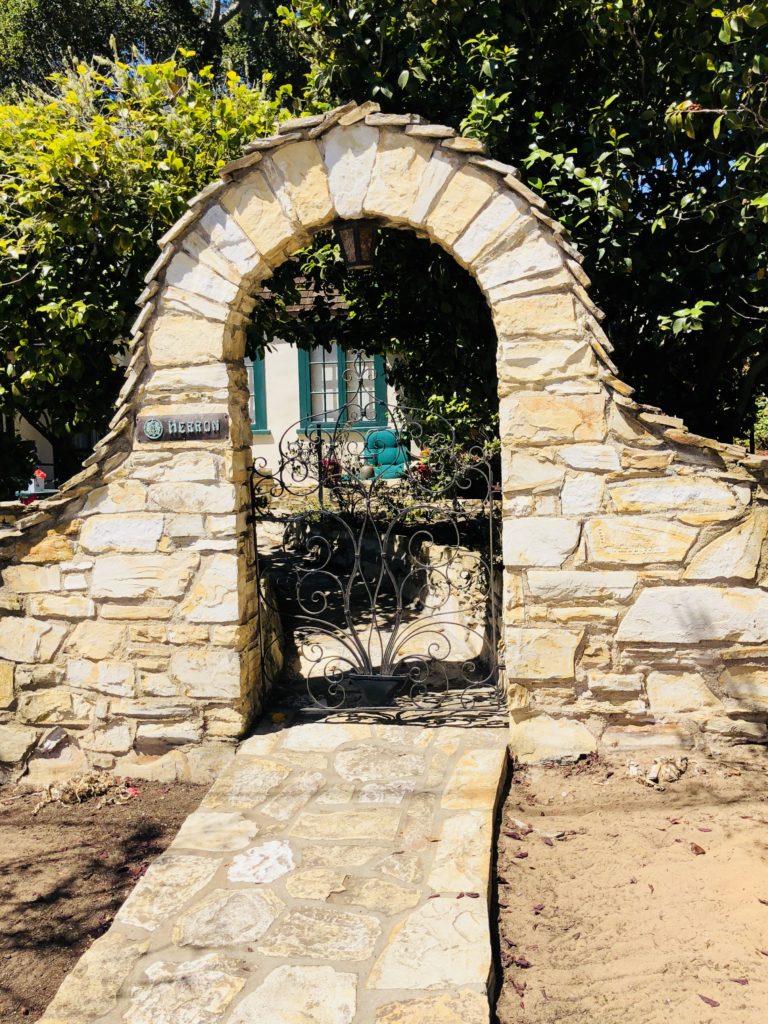
A beautiful and delicate filigree gate balances the ponderous stone arch. A topping of stacked stone “shingles” adds quaint character.
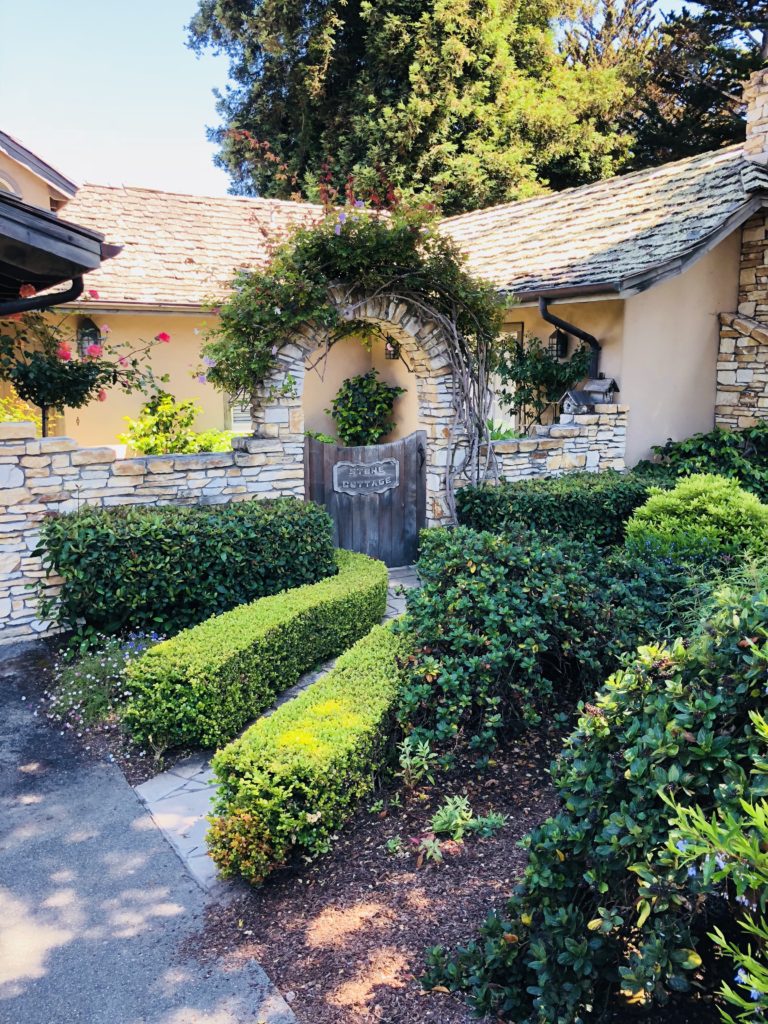
The boxwood hedges flanking the stone path and the rose covered arch provide elegance and romance to this garden gate.
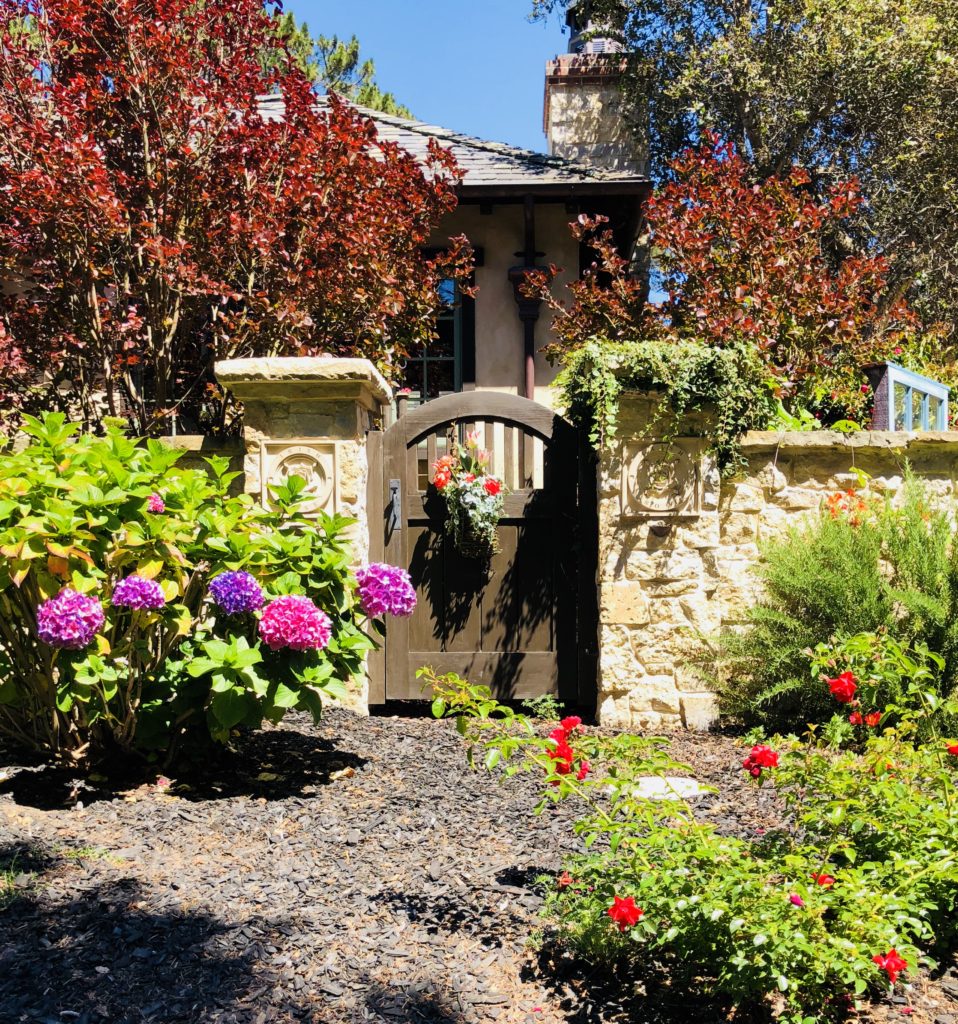
Let us be grateful to the people who make us happy; they are the charming gardeners who make our souls blossom–Marcel Proust
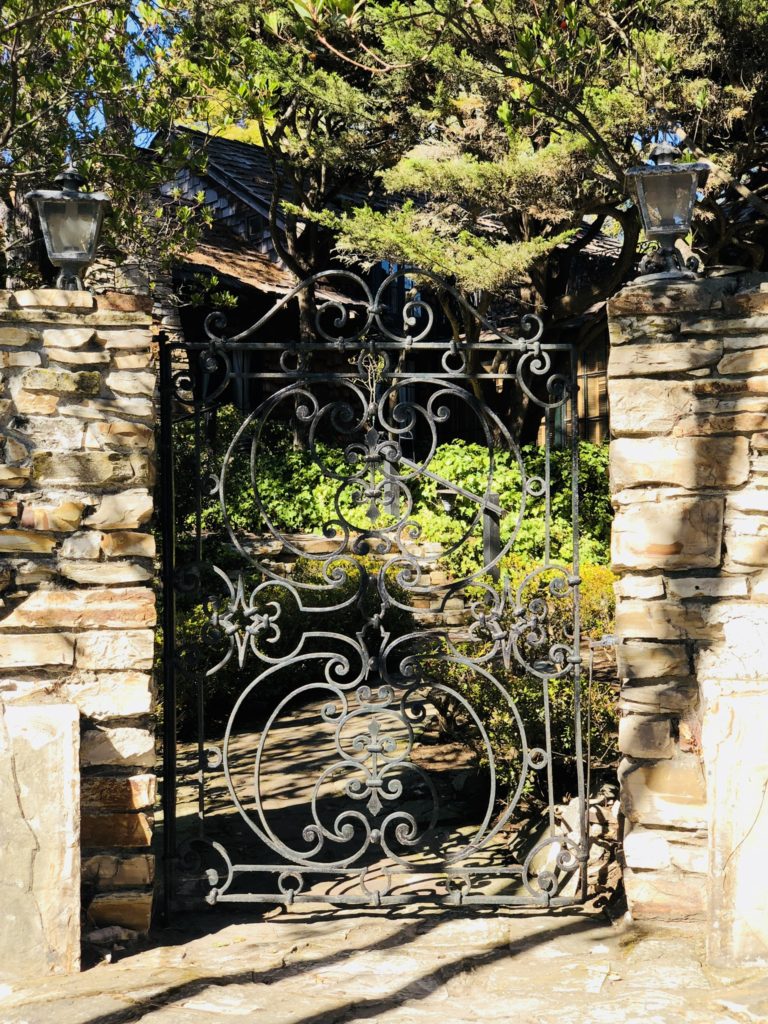
Everything that slows us down and forces patience, everything that sets us back into the slow circles of nature, is a help. Gardening is an instrument of grace–May Sarton
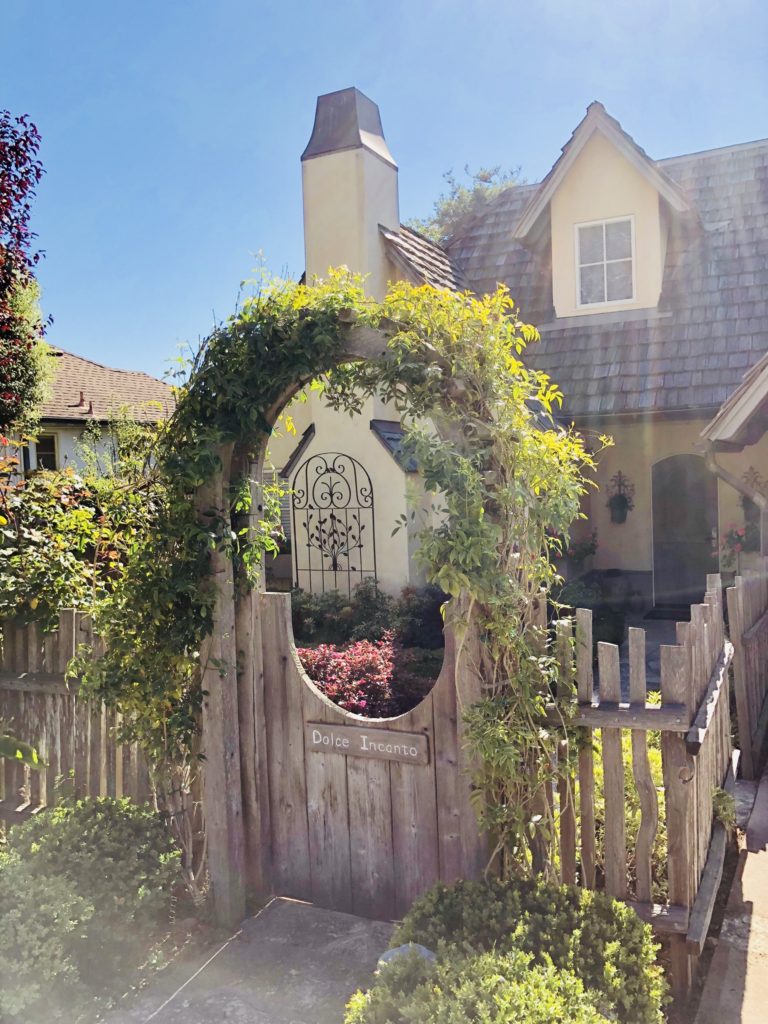
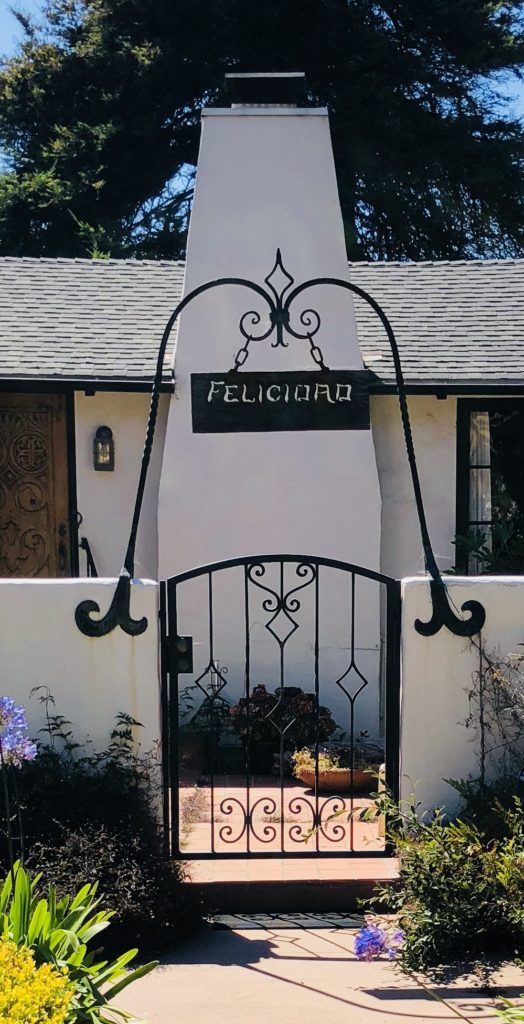
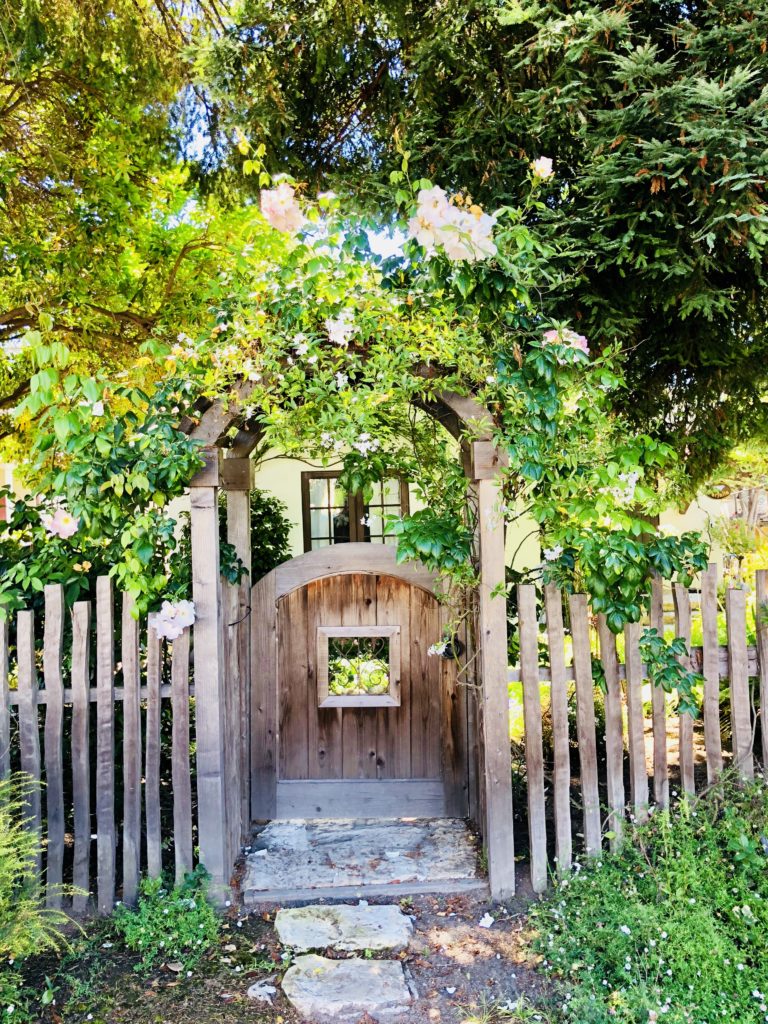
Your promises, your pleasures, your penchants, are all portrayed in your garden. A garden gate that expresses your sentiments and passions provides a warm and inviting welcome to your garden. I hope that you enjoyed and were inspired by these lovely garden gates from Carmel-by-the-Sea.
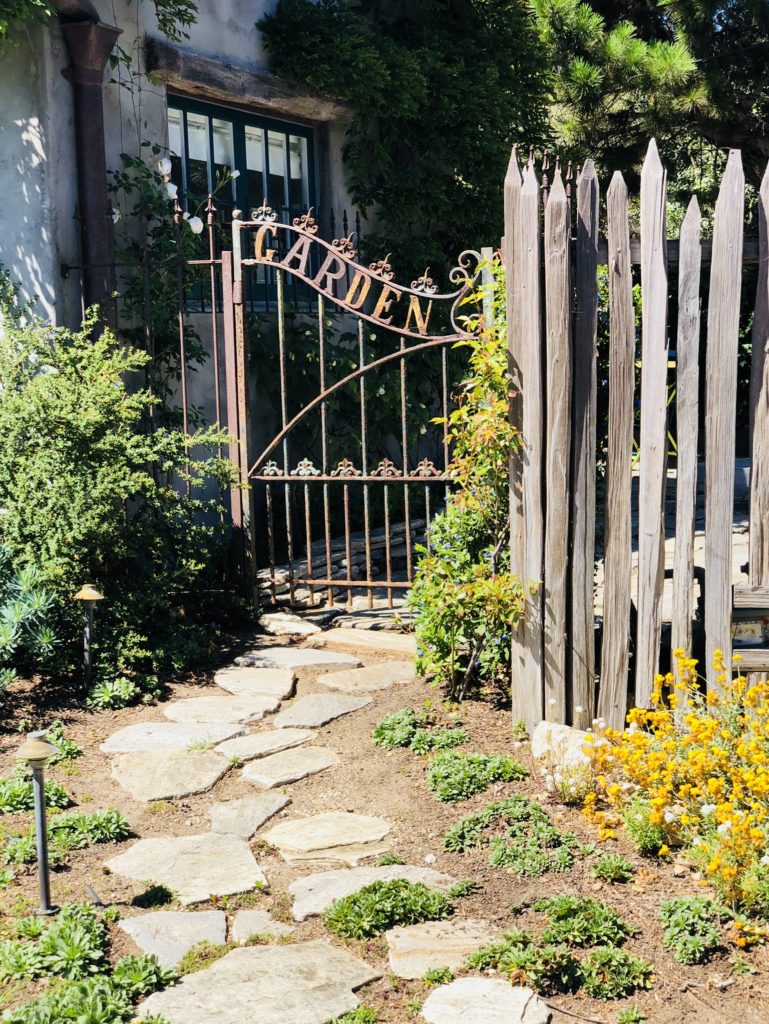
Thank you for visiting my blog! Wishing you peace, love, happiness, and beautiful vistas!
-
Fairy Tale Cottages in Carmel-by-the-Sea
Eclectic, charming, and private, Carmel-by-the-Sea was founded in 1902. It began as a haven for creative intellectuals. Designed by James Devendorf and Frank Powers of San Francisco, the village attracted famous artists, poets, musicians, and writers, including Robinson Jeffers, Sinclair Lewis, Upton Sinclair, Jack London, and Robert Louis Stevenson. Stevenson used Carmel as inspiration for his famous novel, “Treasure Island”.
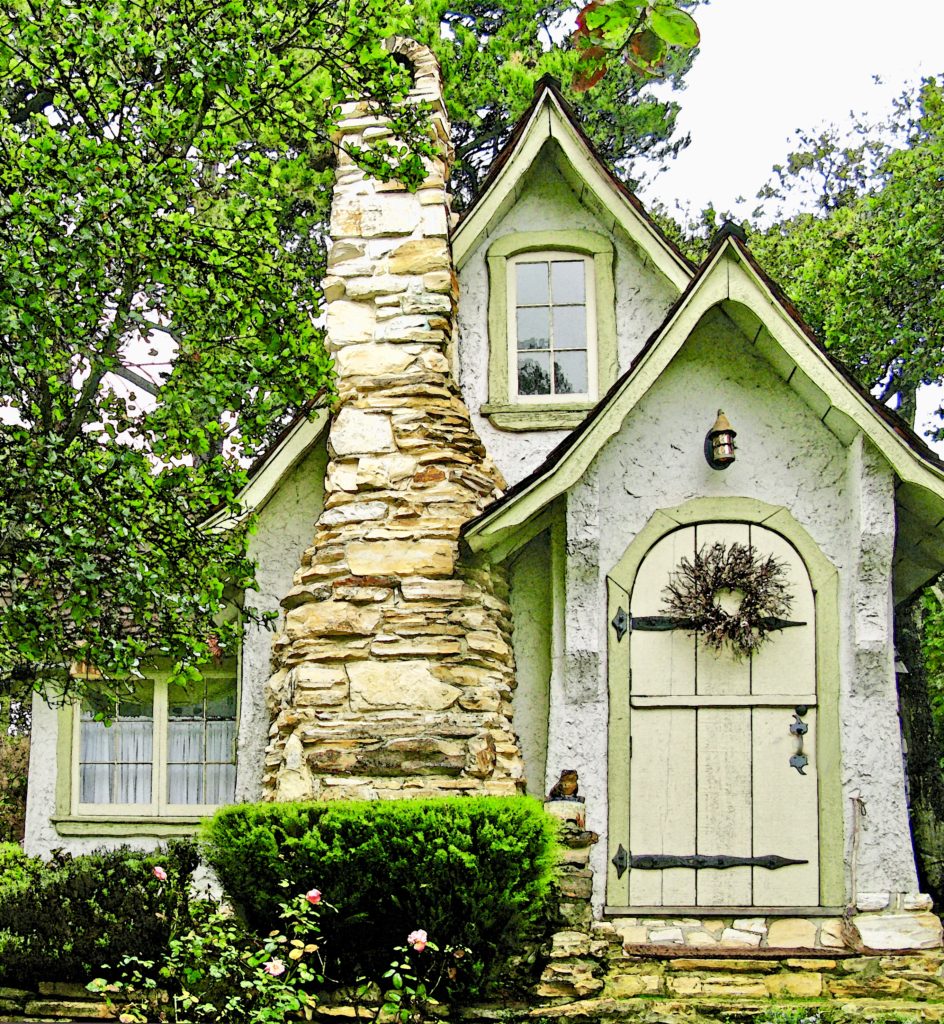 The fairy tale homes prevalent in Carmel originated with builder Hugh Comstock. Comstock built the first cottage as a studio for his wife, Mayotta, whose “Otsy-Totsy” doll business was booming. Although he had no training as a builder, he had the vision and ingenuity to create these whimsical buildings. Twenty-one of his cottages remain in the area today. Comstock is said to have been inspired by the illustrations of Arthur Rackham’s turn-of-the-century children’s books. His signature style included roofs with steep pitches, arched windows and doors, and rustic Carmel stone chimneys. As you wend and weave through the courtyards and quiet side streets of Carmel-by-the-Sea you will see many of these historical homes.
The fairy tale homes prevalent in Carmel originated with builder Hugh Comstock. Comstock built the first cottage as a studio for his wife, Mayotta, whose “Otsy-Totsy” doll business was booming. Although he had no training as a builder, he had the vision and ingenuity to create these whimsical buildings. Twenty-one of his cottages remain in the area today. Comstock is said to have been inspired by the illustrations of Arthur Rackham’s turn-of-the-century children’s books. His signature style included roofs with steep pitches, arched windows and doors, and rustic Carmel stone chimneys. As you wend and weave through the courtyards and quiet side streets of Carmel-by-the-Sea you will see many of these historical homes.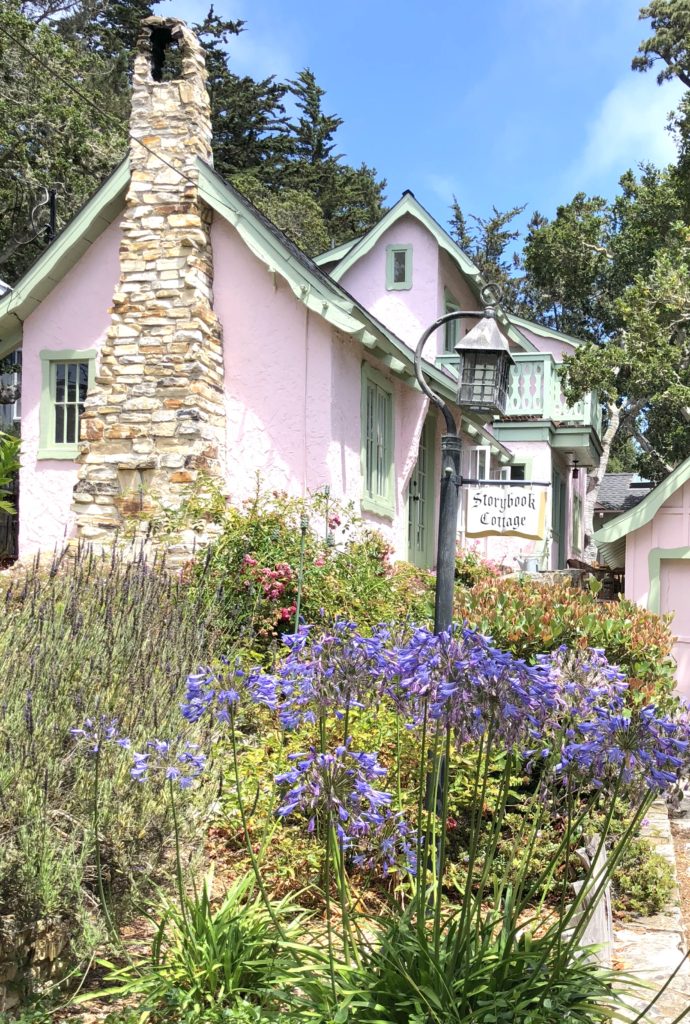
This Comstock home was built in 1927 as his studio, and later, as a home for his wife.
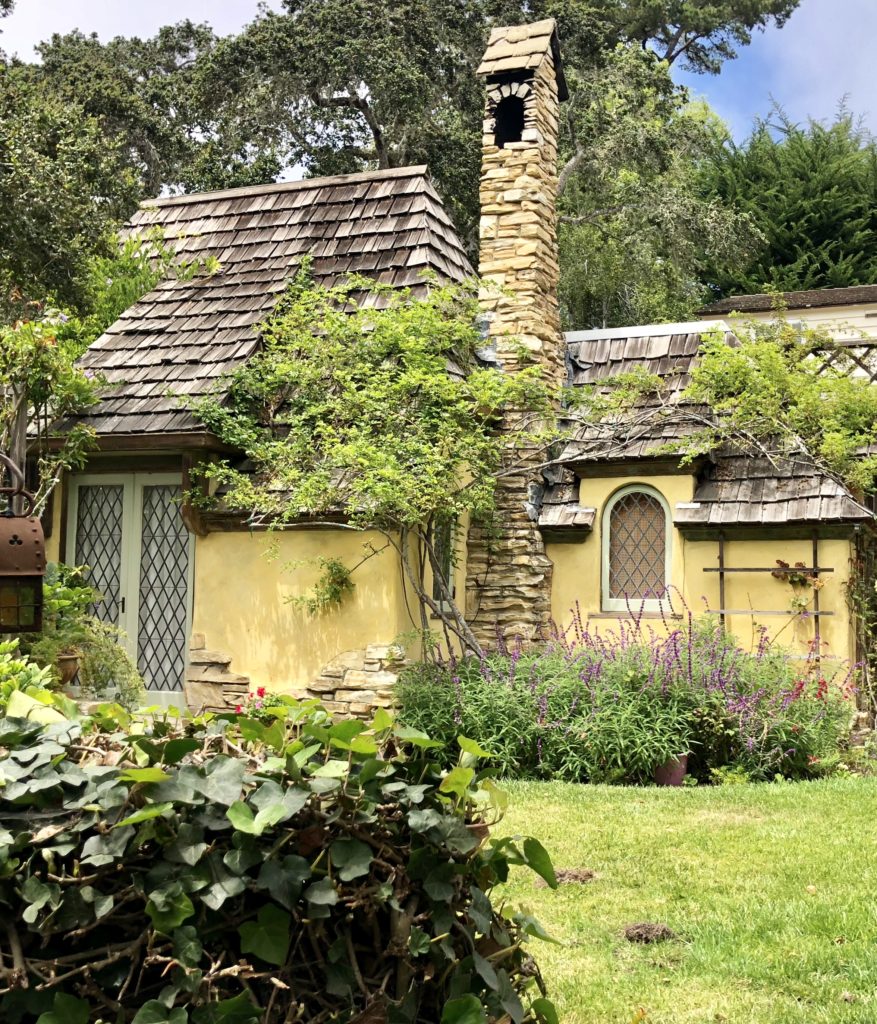
The “Marchen-Haus”, built in 1928, was Comstock’s largest cottage.
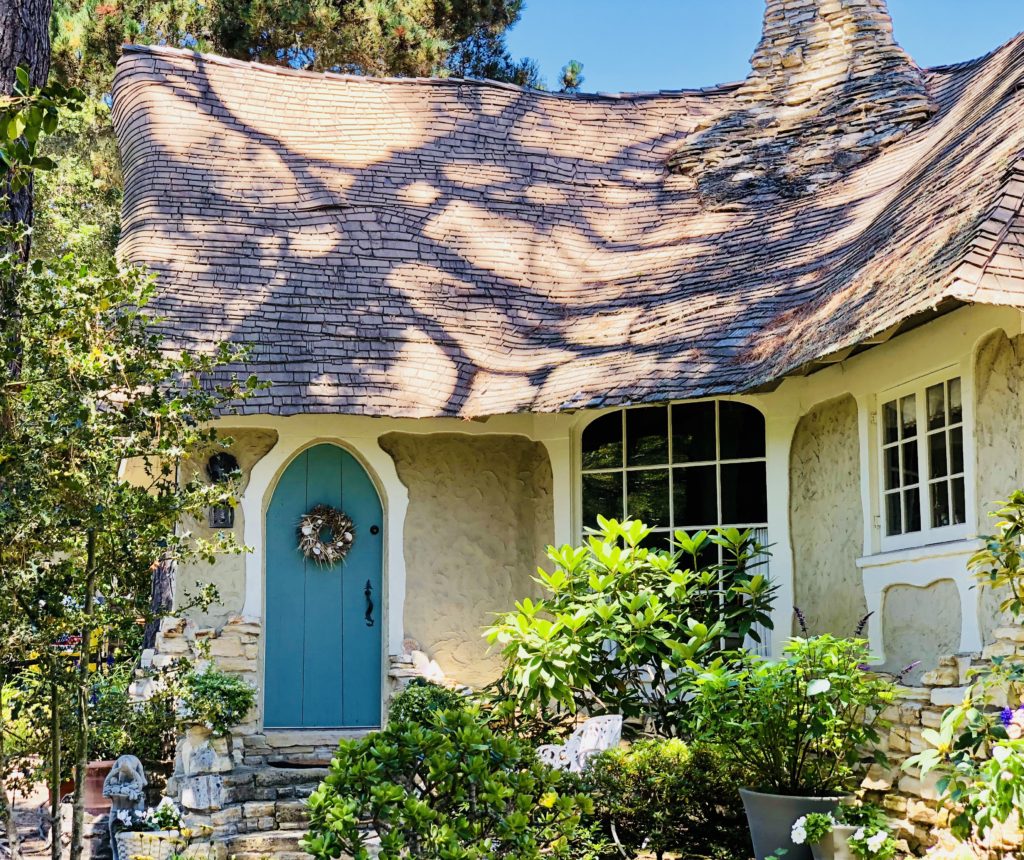
The Tuck Box was the only property Comstock built for commercial use. It is now used as a tea room; see The Tuck Box: A Fairy Tale Tea Room in Carmel-by-the-Sea
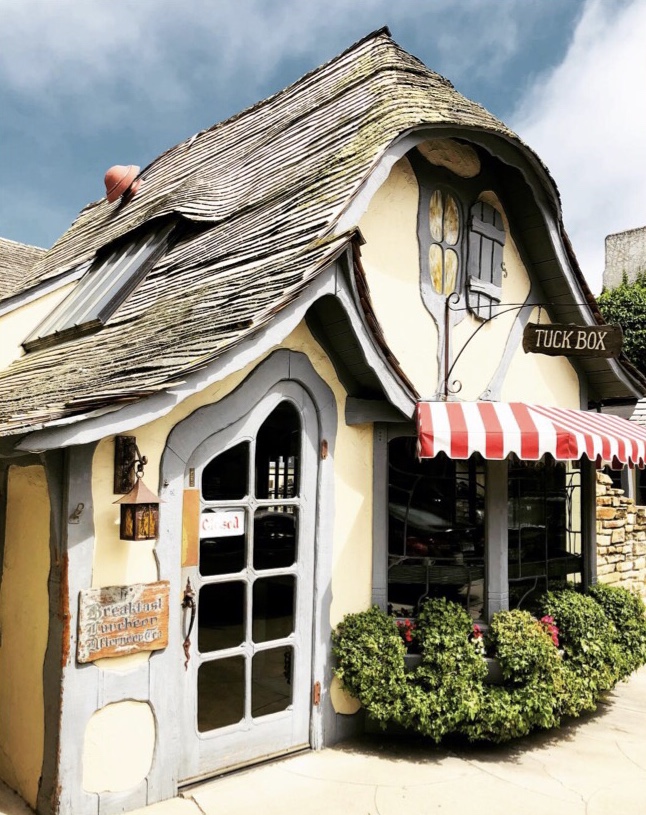
Comstock’s cottages became the local rage, and other builders soon followed suit. The Cottage of Sweets was built in 1922 and served as a weaving shop, ticket booth for theatres, a dress shop, and finally, a candy store. The pink cottage next to it was based on illustrations from a Swedish folktale book and included miniature turrets and stucco tiles above the windows.

This Tudor style cottage was built in 1925, and stands just east of the Candy Cottage.
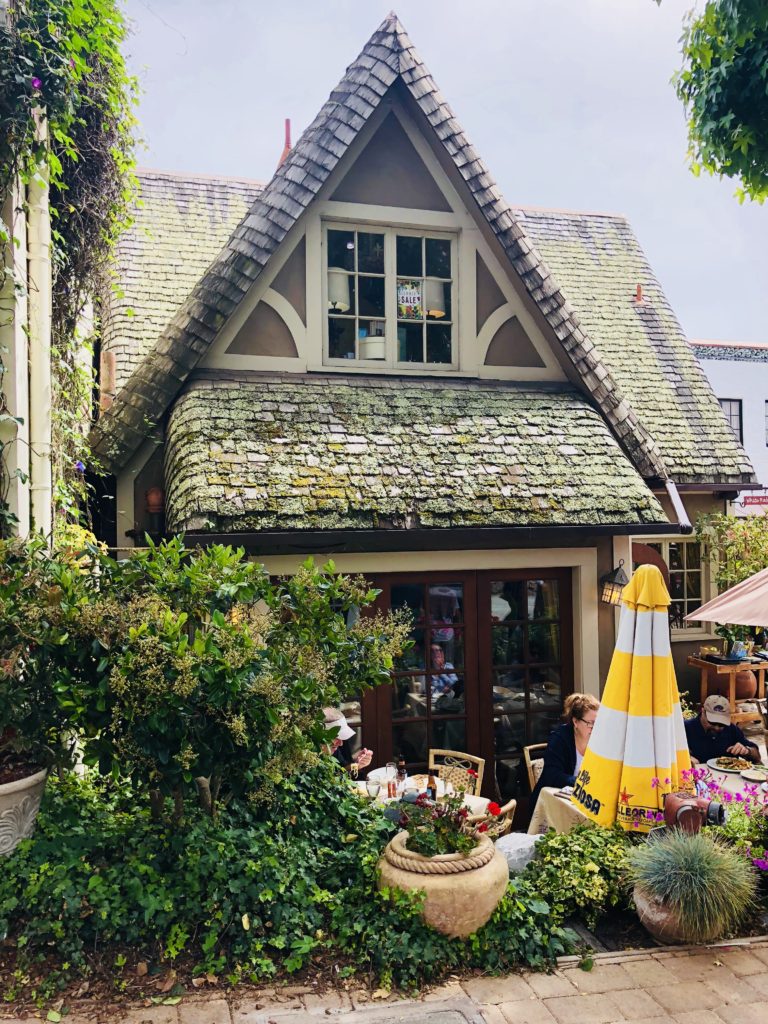
The French Country style Normandy Inn was built by architect Robert Stanton in 1924, and features a shake roof and half-timbering.
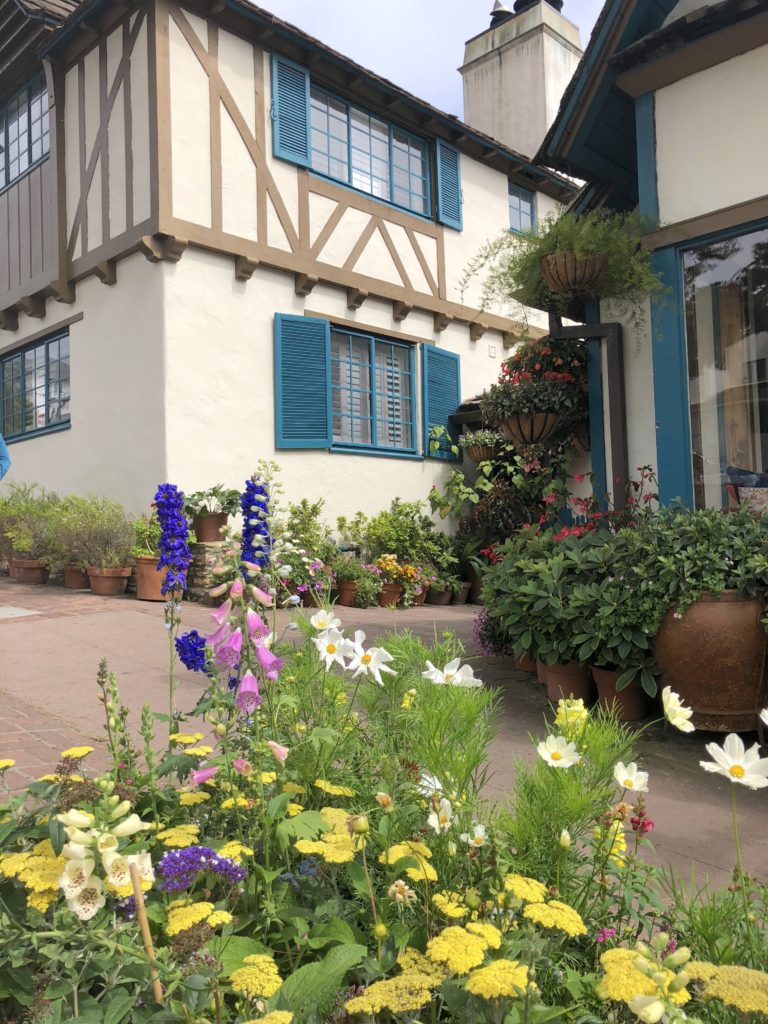
The original bohemian owners of many of these fairy tale homes may be gone, but their spirit of creativity, individualism, and beauty remains.
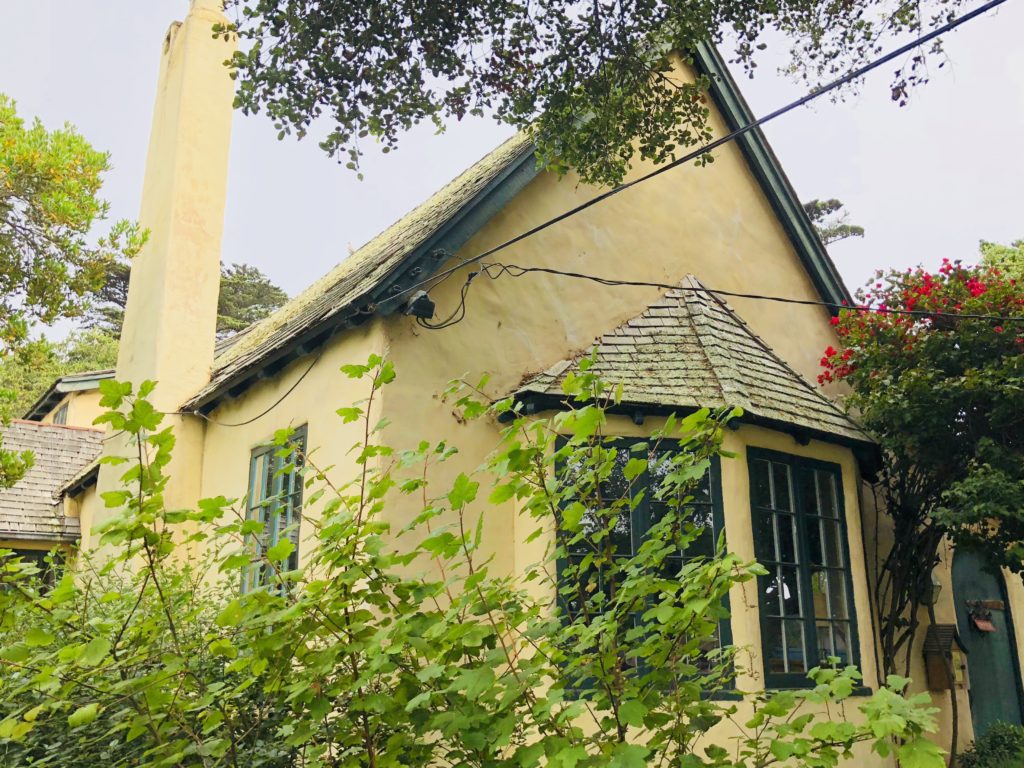
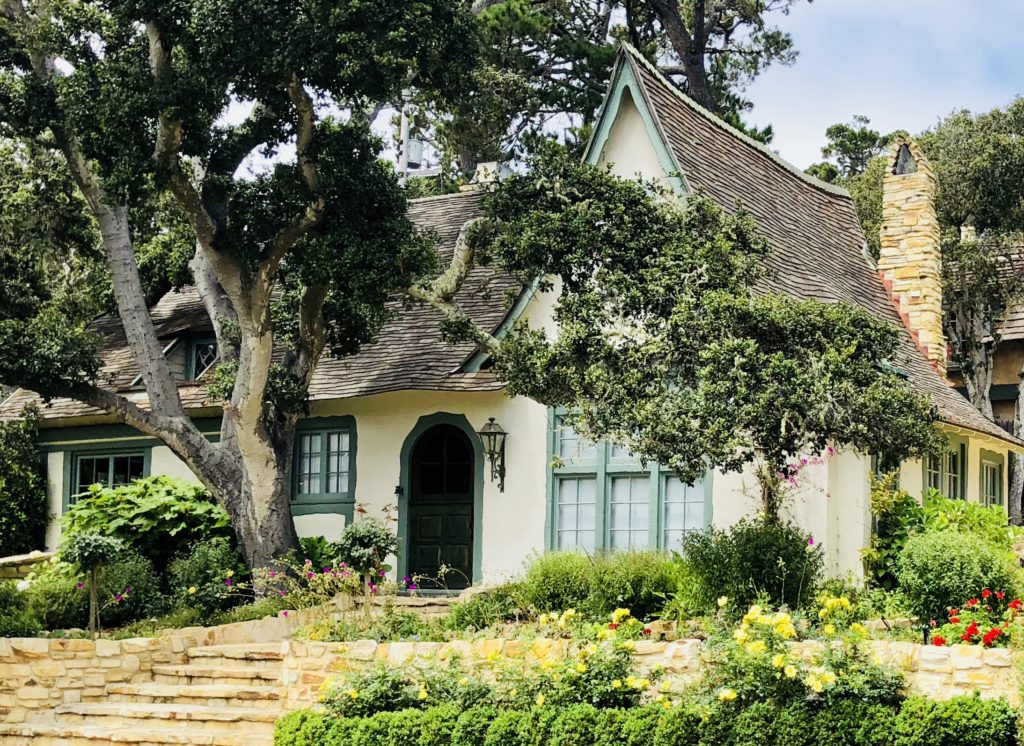
Carmel-by-the-Sea began as a refuge for dreamers, artists, and story-tellers. Houses here do not have numbers, but rather, names, in order to support a sense of community and personal identity.
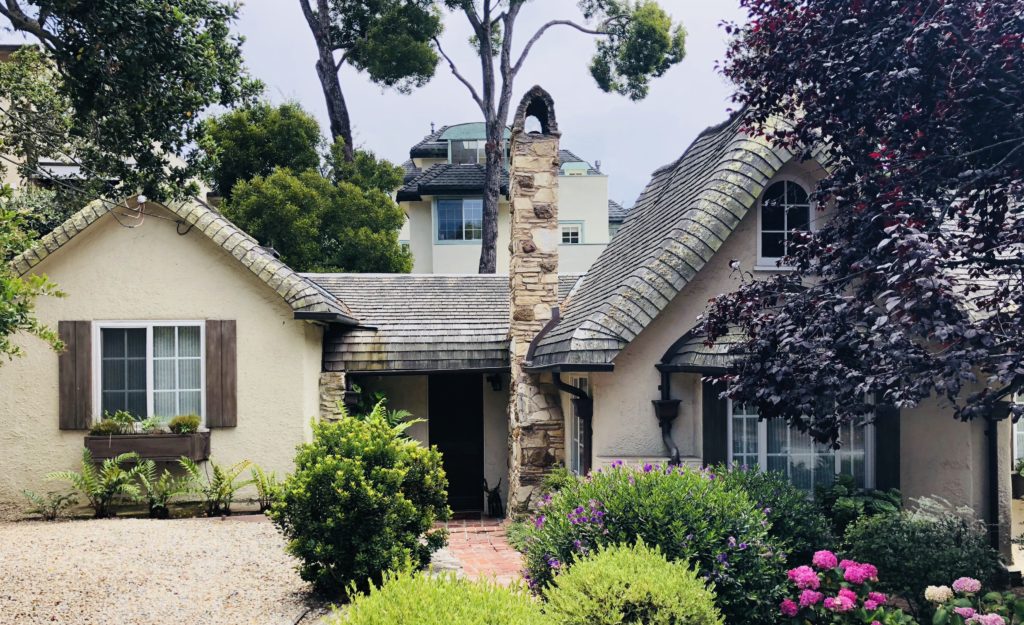
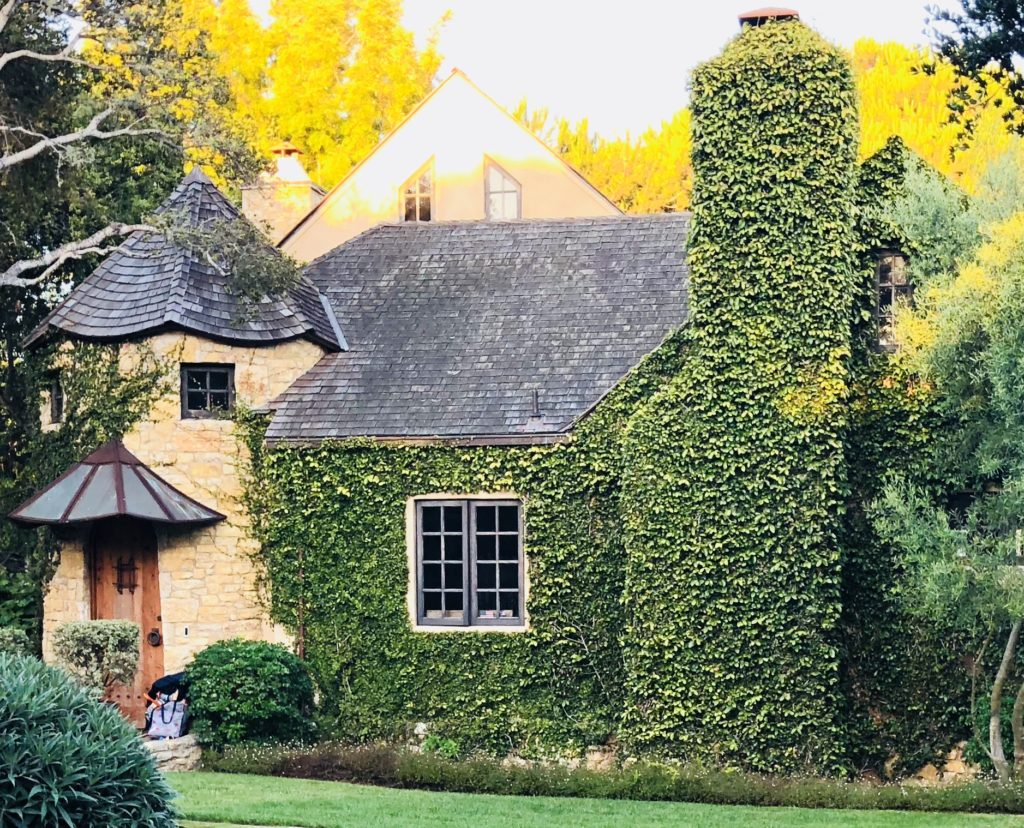
Crafted from local materials, and with lovely imperfections, the homes here look like something from Grimm’s Fairy Tales. You almost expect Snow White & The Seven Dwarves to appear in the cottage below, or Rapunzel to let down her hair from the stone tower in the cottage above.
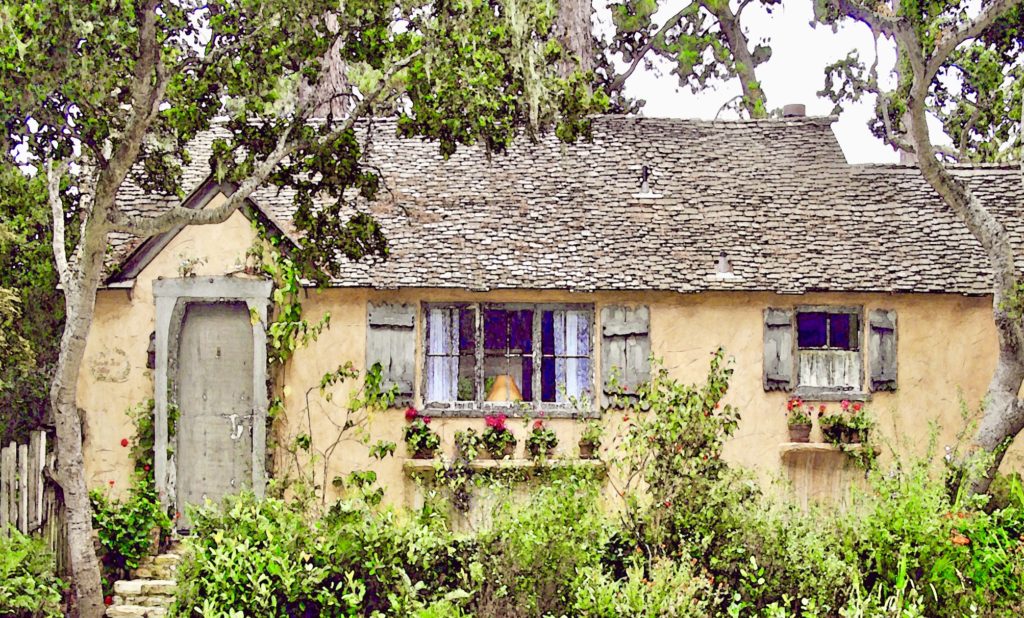
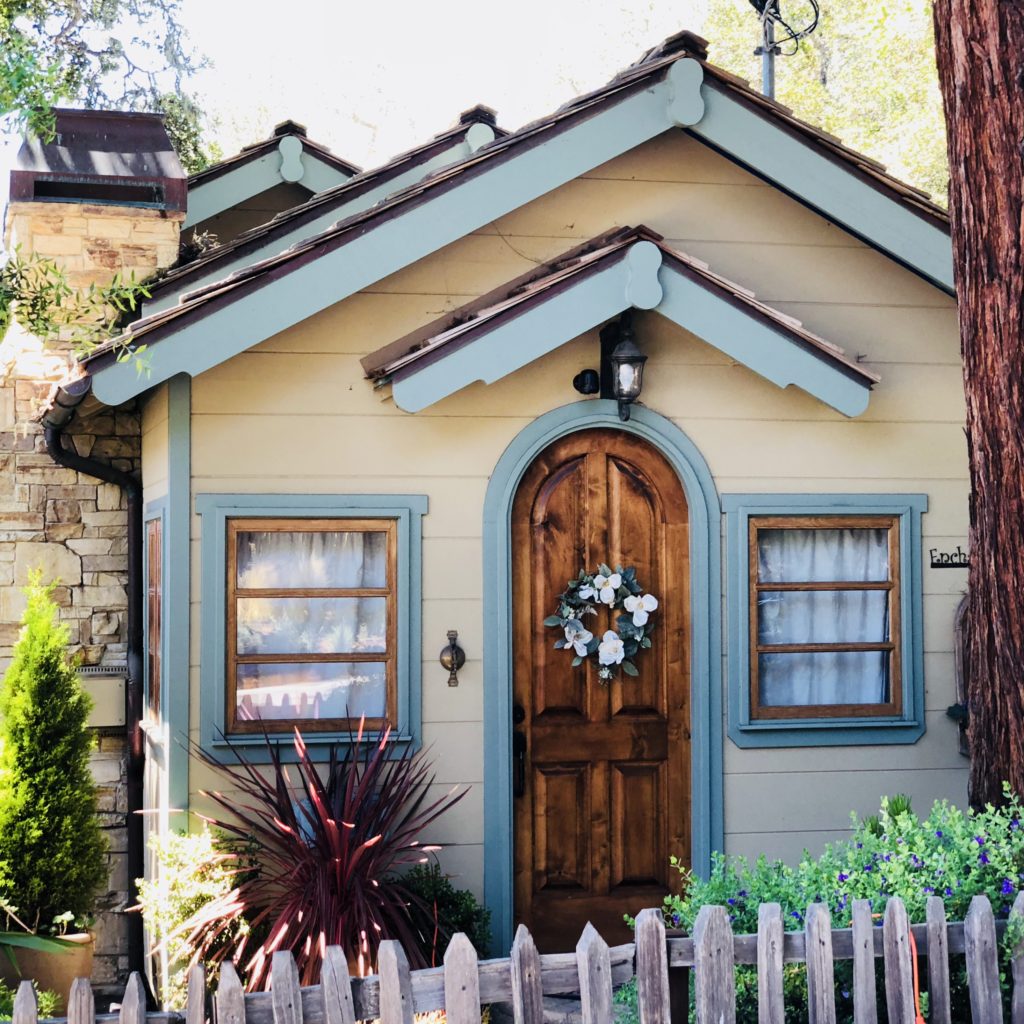
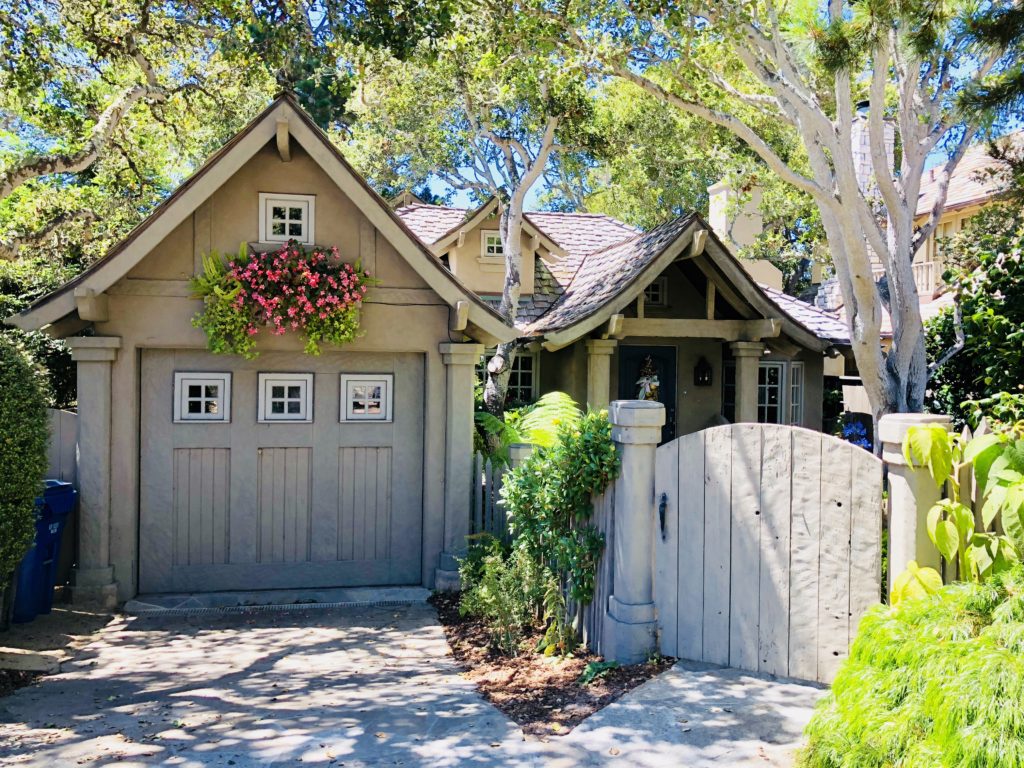
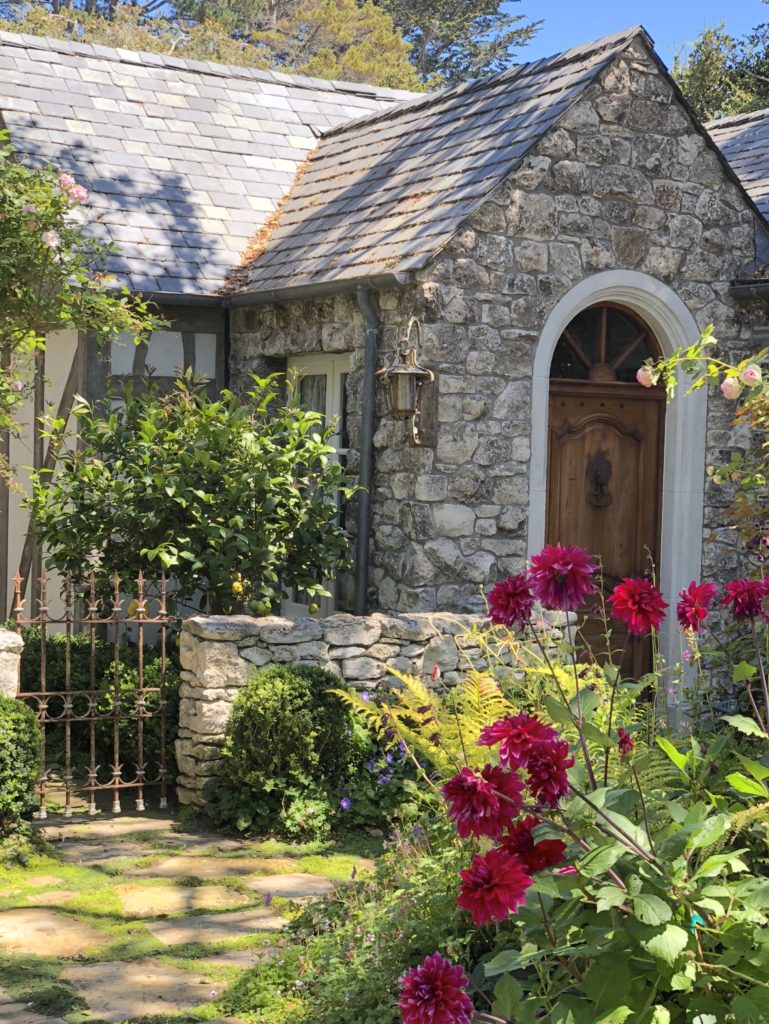
If you visit Carmel-by-the-Sea, I highly recommend that, in addition to visiting the beach and local shops, you take time to slowly meander along the byroads and quiet side streets. You never know where your explorations will lead and what you will find, but most certainly, your fairytale adventures in Carmel-by-the-Sea will have a happy ending.
Thank you for visiting my blog! Wishing you peace, love, happiness, and beautiful vistas!
-
Magical & Enchanting Gardens of Carmel-by-the-Sea
“A garden should make you feel you’ve entered privileged space — a place not just set apart but reverberant — and it seems to me that, to achieve this, the gardener must put some kind of twist on the existing landscape, turn its prose into something nearer poetry.”__Michael Pollan, Second Nature: A Gardener’s Education
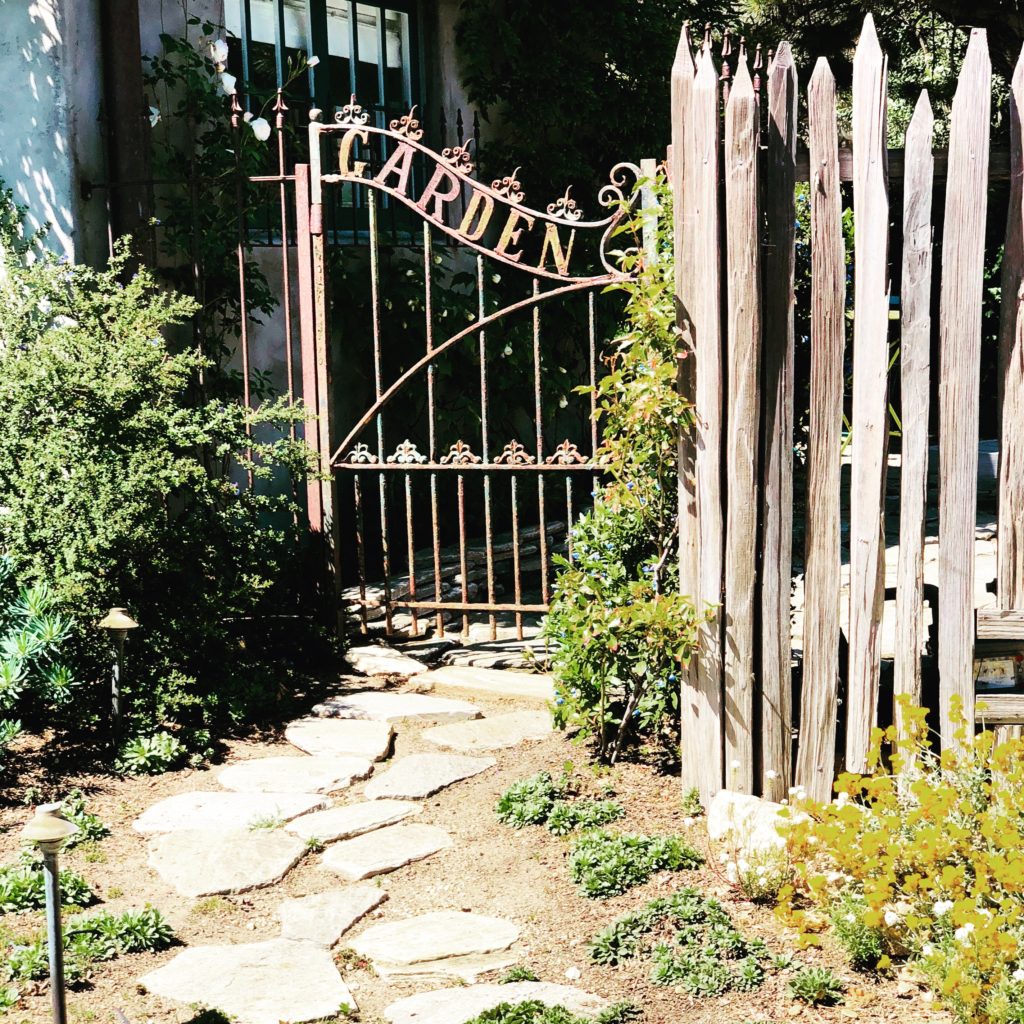 As a little girl, I grew up watching my mother & father tend to our garden. It was an important part of our lives. Each year, my father would diligently work in the garden, turning over the soil. He would sow green onions, radishes, green beans, tomatoes, and cucumbers. I would help my mother plant zinnias, morning glories, sweet william, and black-eyed Susans. I would help cut bouquets of fat pink peonies and pale violet lilacs and pull weeds straggling between the flowers. I loved watching things grow and thrive with only minimal care, water, and sunshine. I played with snapdragons, made daisy chains, and helped gather fresh vegetables. I appreciated the beauty and bounty provided by nature.
As a little girl, I grew up watching my mother & father tend to our garden. It was an important part of our lives. Each year, my father would diligently work in the garden, turning over the soil. He would sow green onions, radishes, green beans, tomatoes, and cucumbers. I would help my mother plant zinnias, morning glories, sweet william, and black-eyed Susans. I would help cut bouquets of fat pink peonies and pale violet lilacs and pull weeds straggling between the flowers. I loved watching things grow and thrive with only minimal care, water, and sunshine. I played with snapdragons, made daisy chains, and helped gather fresh vegetables. I appreciated the beauty and bounty provided by nature.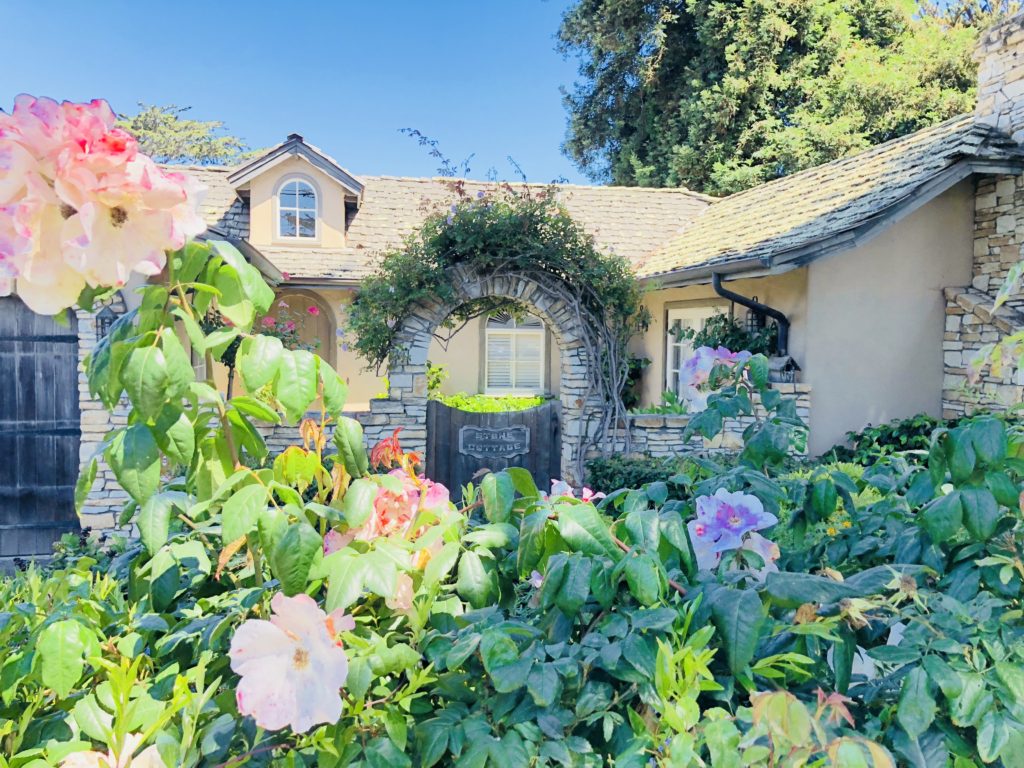 It is no surprise that as an adult, nothing is more peaceful and relaxing to me, than working in my garden. I also love to see other gardens. I believe that gardening nurtures the heart and soul.
It is no surprise that as an adult, nothing is more peaceful and relaxing to me, than working in my garden. I also love to see other gardens. I believe that gardening nurtures the heart and soul.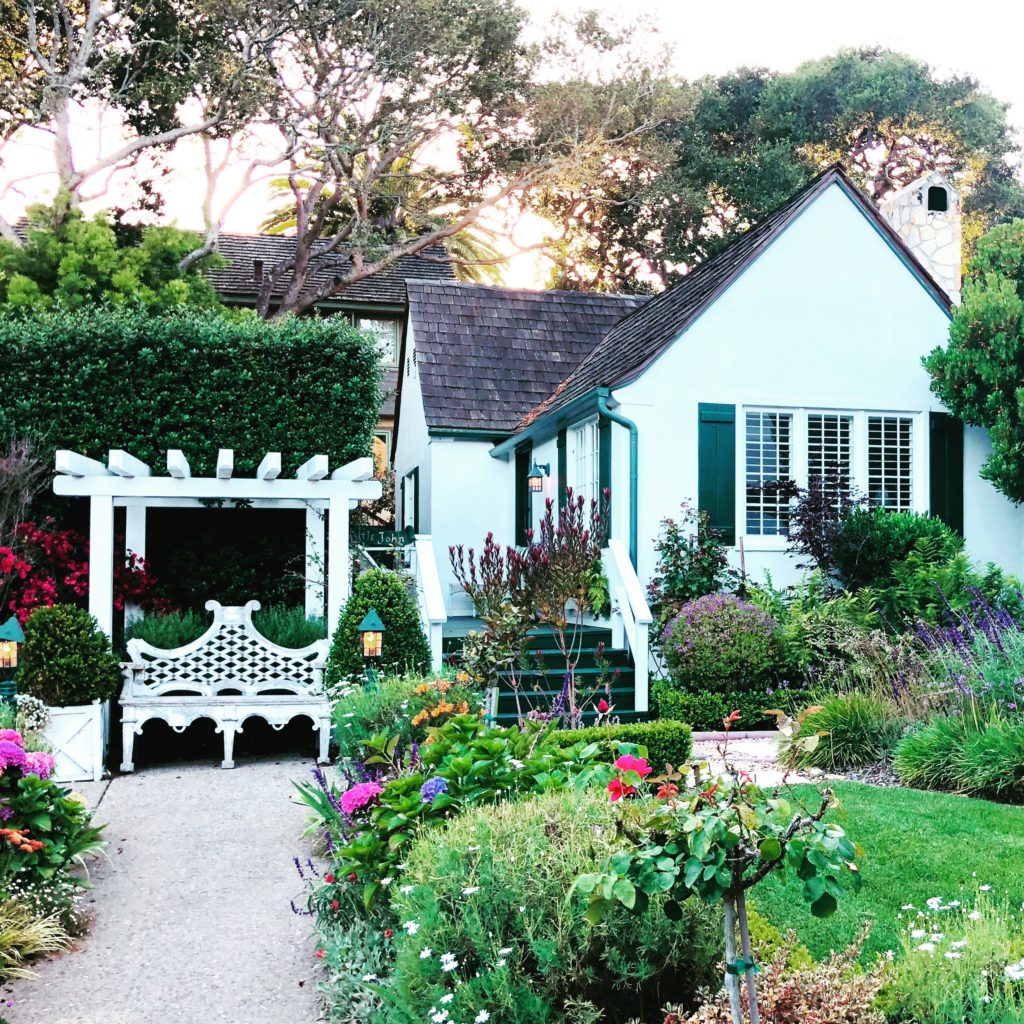 One of my favorite places to view beautiful gardens is Carmel-by-the-Sea. There, quaint seaside cottages abound, with darling garden gates and arbors, climbing roses, and picket fences. I love to wander along the streets with names like Court of the Golden Bough, Casanova, and Inspiration Avenue, and take in all the lovely views.
One of my favorite places to view beautiful gardens is Carmel-by-the-Sea. There, quaint seaside cottages abound, with darling garden gates and arbors, climbing roses, and picket fences. I love to wander along the streets with names like Court of the Golden Bough, Casanova, and Inspiration Avenue, and take in all the lovely views.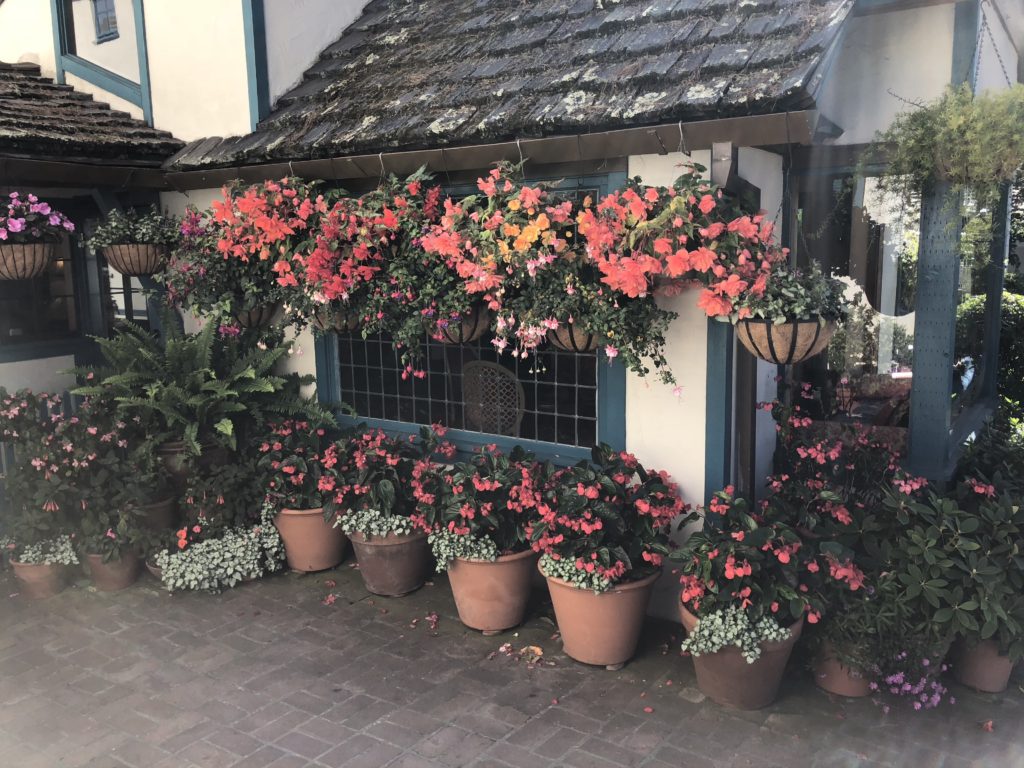 It is always reassuring to see well-tended flowers and gardens. To know that others love flowers and care for their gardens is very comforting.
It is always reassuring to see well-tended flowers and gardens. To know that others love flowers and care for their gardens is very comforting.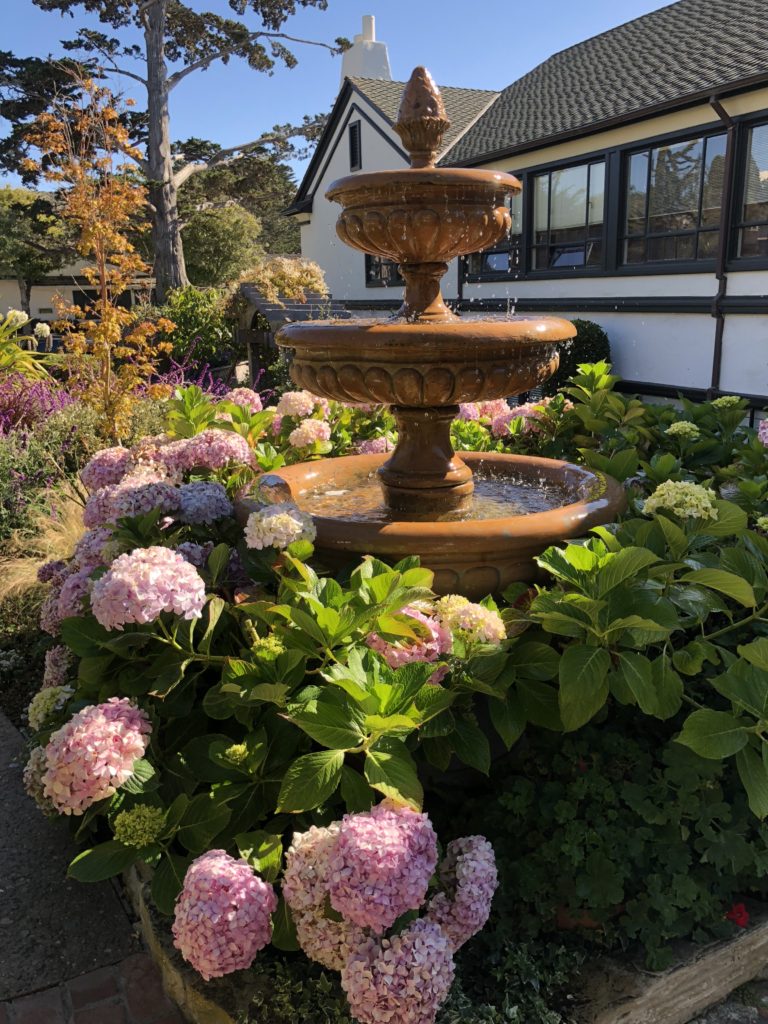 “A garden is a grand teacher. It teaches patience and careful watchfulness; it teaches industry and thrift: above all it teaches entire trust.” __Gertude Jekyll
“A garden is a grand teacher. It teaches patience and careful watchfulness; it teaches industry and thrift: above all it teaches entire trust.” __Gertude Jekyll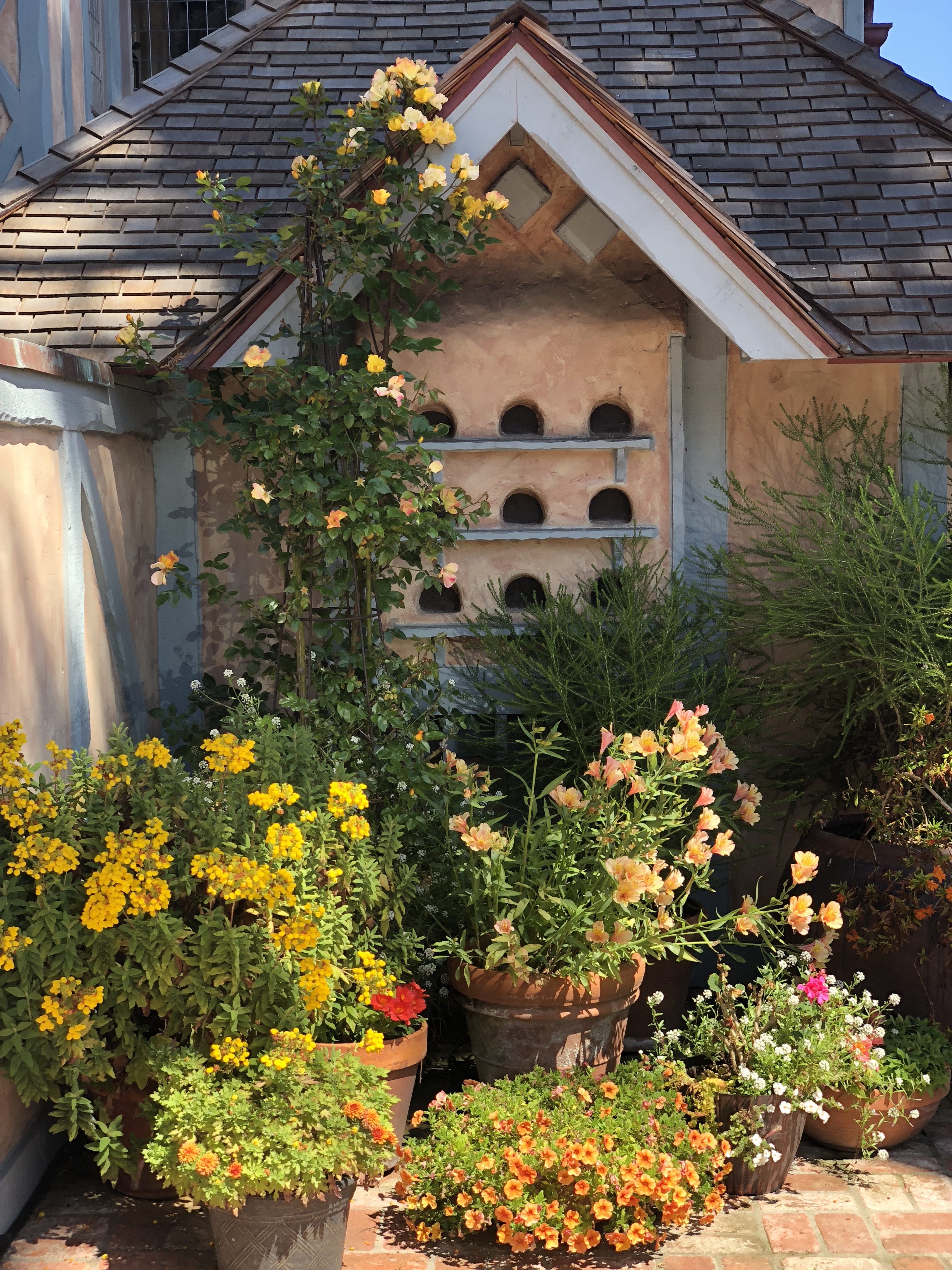 I love that even in the tiniest of spaces, people will grow flowers in pots where there is no room for a garden. I applaud everyone who finds a way to nurture and grow things, no matter where he or she lives.
I love that even in the tiniest of spaces, people will grow flowers in pots where there is no room for a garden. I applaud everyone who finds a way to nurture and grow things, no matter where he or she lives.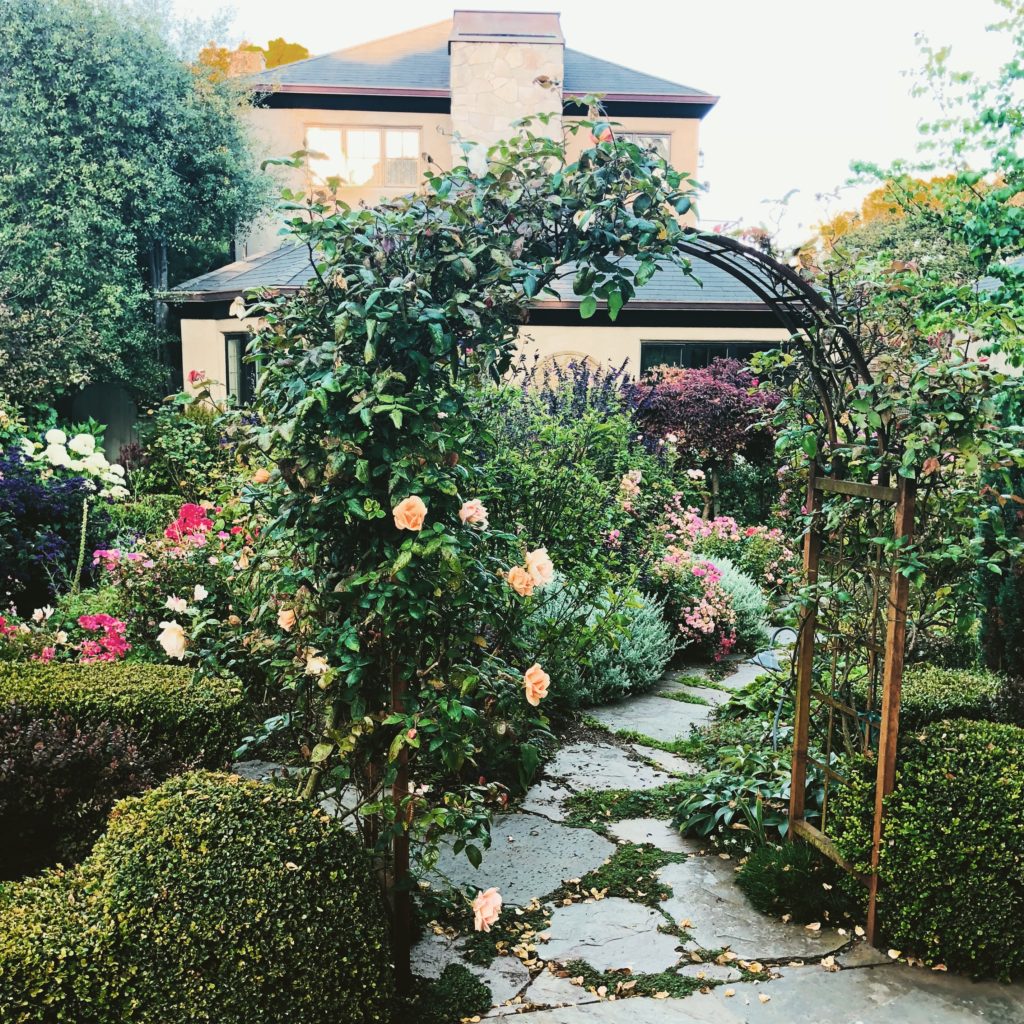 “There are always flowers for those who want to see them.”__Henri Matisse
“There are always flowers for those who want to see them.”__Henri Matisse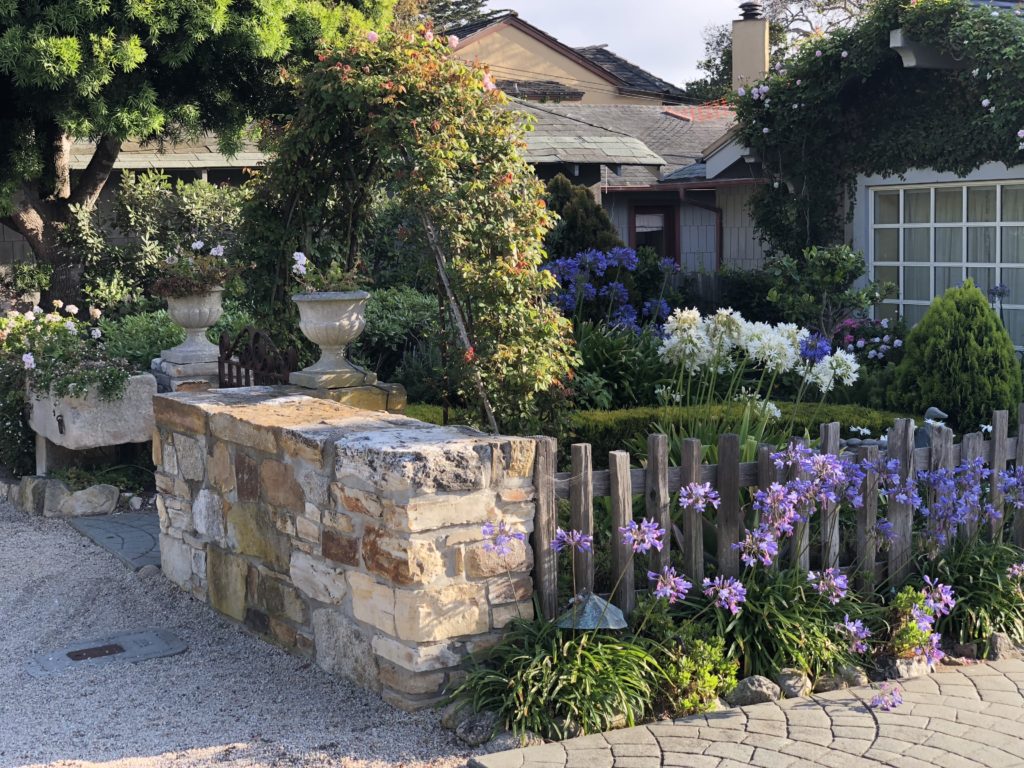 Serendipity is often the best way to discover beautiful gardens. I hope that you enjoyed this post and that it inspired you to find or create your own magical and enchanting gardens!Thank you for visiting my blog! Wishing you peace, love, happiness, & beautiful vistas!
Serendipity is often the best way to discover beautiful gardens. I hope that you enjoyed this post and that it inspired you to find or create your own magical and enchanting gardens!Thank you for visiting my blog! Wishing you peace, love, happiness, & beautiful vistas! -
Nine Best Fresh Herbs To Use In Your Kitchen

If like me, you have had sticker shock at the price of fresh organic herbs lately, you will be happy to know that they are super easy to grow yourself for much less! One of the things I like most about herbs is that you can grow them pretty much anywhere. Even if you have no space for a garden, you can grow many herbs in pots on your windowsill or in containers on a patio. Fresh, organic, high-quality herbs can make the difference between a bland dish and something filled with exceptional flavor and aroma. Herbs often have powerful health benefits as well, by providing vitamins and minerals, strengthening the immune system, lowering blood sugar and cholesterol, and reducing inflammation.
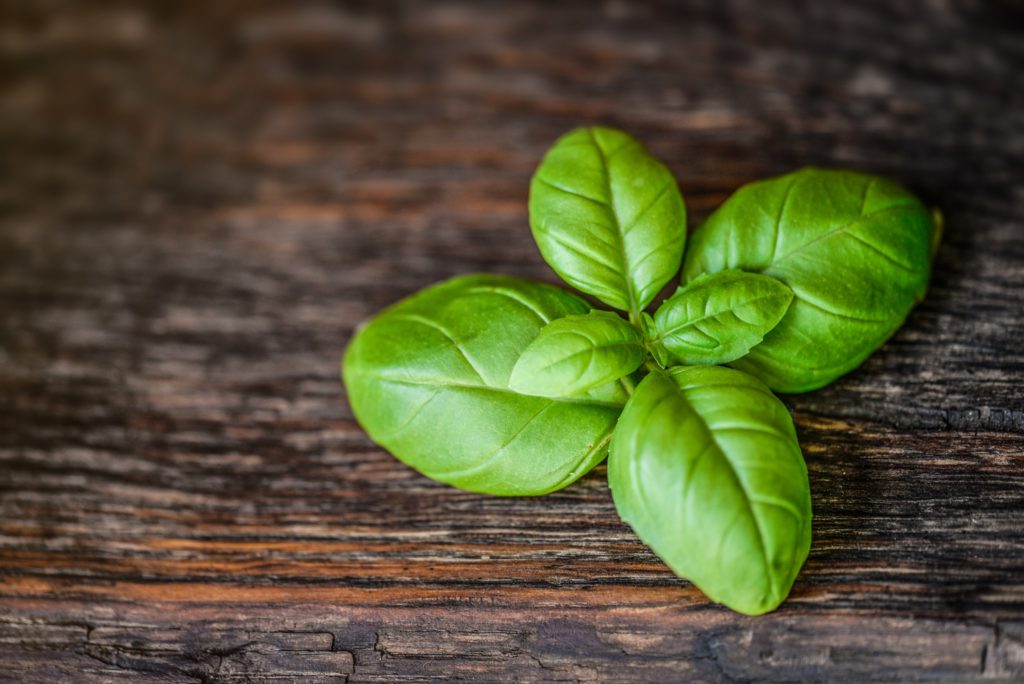
- Basil is by far my favorite herb. It is a staple in pizzas, salads, sauces, and pesto. In addition, it contains antioxidants and helps moderate blood sugar. It is easy to grow but needs hot weather and must be kept watered regularly to thrive.
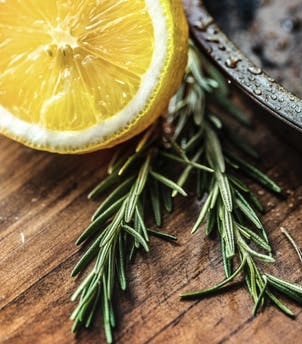
2. Rosemary. I love the smell of rosemary! It is a great herb to add to poultry and vegetable dishes. It has a refreshing scent and is super easy to grow, preferring dry conditions. It is said to improve mood, memory and protect the immune system. Here in California, a rosemary plant will grow into a full-sized bush and thrives with neglect. Seriously!
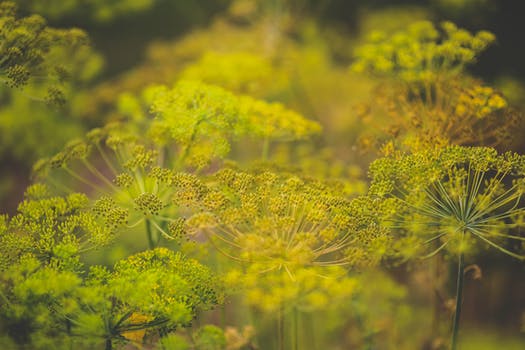
3. Dill is easy to grow. It will also attract helpful insects to your garden such as wasps and other predatory insects. It also is a delicious complement to fish and sour cream dip for vegetables. Dill is a source of calcium (surprise!), iron and magnesium.

4. Thyme is a dainty, low-growing herb with a lemony scent. I love to use it for soups, stews, vegetables, and poultry. It is a staple of Provençal French cuisines. Thymol, an ingredient found in thyme, has been shown to prevent fungal and viral infections, reduce respiratory issues, and alleviate stress.
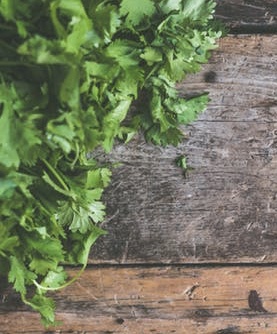
5. Cilantro is another of my favorite herbs and tastes amazing in salads, with chicken, and in Mexican cuisine. The seeds of cilantro are known as coriander. It grows best in cooler weather and requires moderate watering.
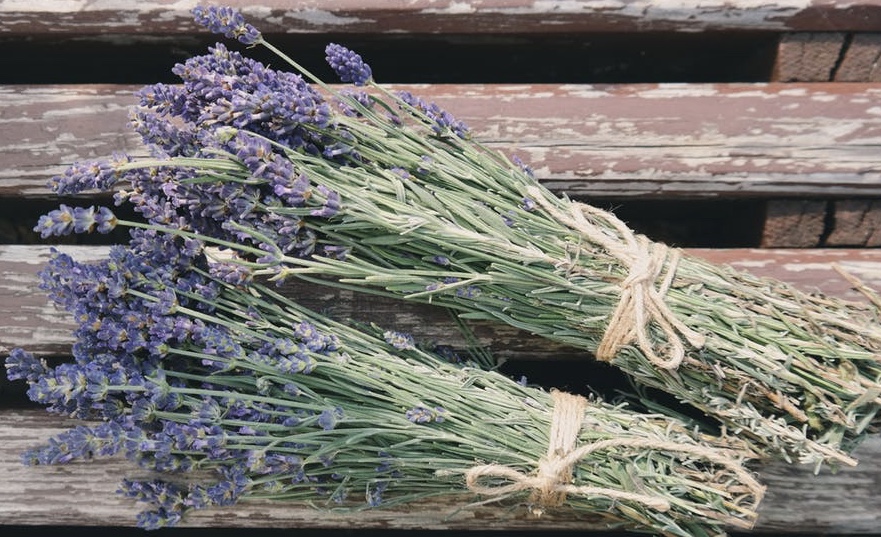
6. Lavender smells fantastic and survives with little care here in California, as long as it has full sun and well-drained soil. Health benefits include the soothing of insect bites and headaches and it has been touted as a sleep aid. I like to keep dried lavender sachets in drawers to keep linens freshly scented. In cooking, lavender imparts a sweet flavor.
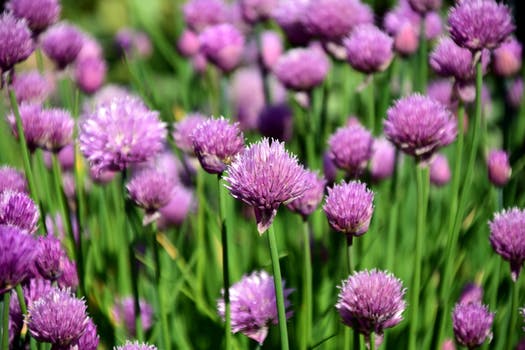
7. Chives are super easy to grow and look amazing in herb gardens. Chives are a member of the garlic family and are considered one of the “fine herbs” of French cuisine. Chives are an excellent source of beta-carotene and Vitamin C and taste great with potatoes and other vegetables as well as fish as well as in soups and salads.

8. Mint is super duper easy to grow. There are several varieties of mint. You can use it in drinks like mojitos, mint juleps, and iced tea. It is also used in soups and salads. It is best used fresh. Mint has high antioxidant levels, freshens the breath and will help to calm your stomach. It also relieves congestion and has anti-inflammatory properties. If you grow mint, remember that it’s invasive. Mint will spread!
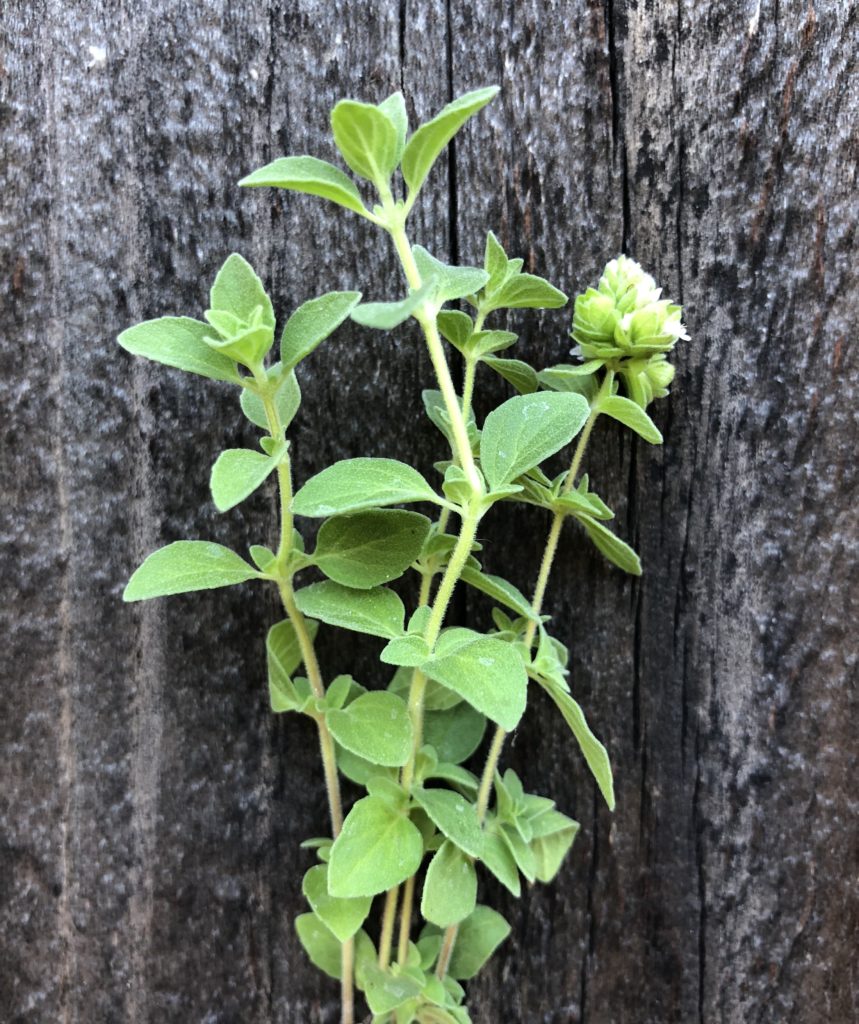
9. Oregano is also part of the mint family and is native to the warm climates of Eurasia and the Mediterranean. Oregano is a plant, but in colder climates can be grown as an annual. It is sometimes called wild marjoram and is closely related to sweet marjoram. Oregano is used for flavoring and is a staple herb of Italian American cuisine including everyone’s favorite, pizza!
If you grow your own herbs, you can be assured that they are fresh and organic. If you grow your herbs indoors you can enjoy them fresh year-round. But if that’s not an option, consider freezing or drying some of your own herbs to have available for use year round. Be warned that herb gardening can be addicting!
Thank you for visiting my blog! Wishing you peace, love and happiness!
- Basil is by far my favorite herb. It is a staple in pizzas, salads, sauces, and pesto. In addition, it contains antioxidants and helps moderate blood sugar. It is easy to grow but needs hot weather and must be kept watered regularly to thrive.
-
Purple Sand & Stone Arches at Pfeiffer Beach in Big Sur
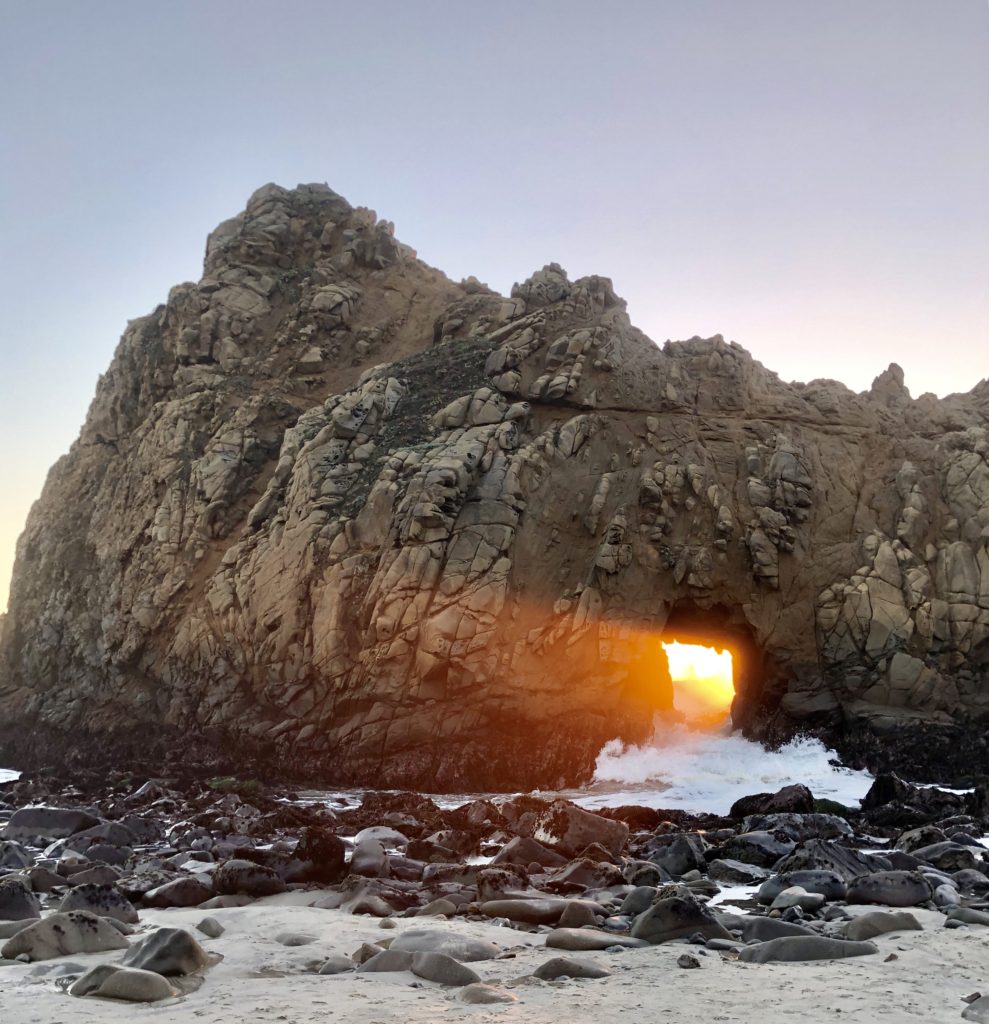
For a few brief weeks around the winter solstice, the sunset casts an ethereal glow through the Keyhole Arch. 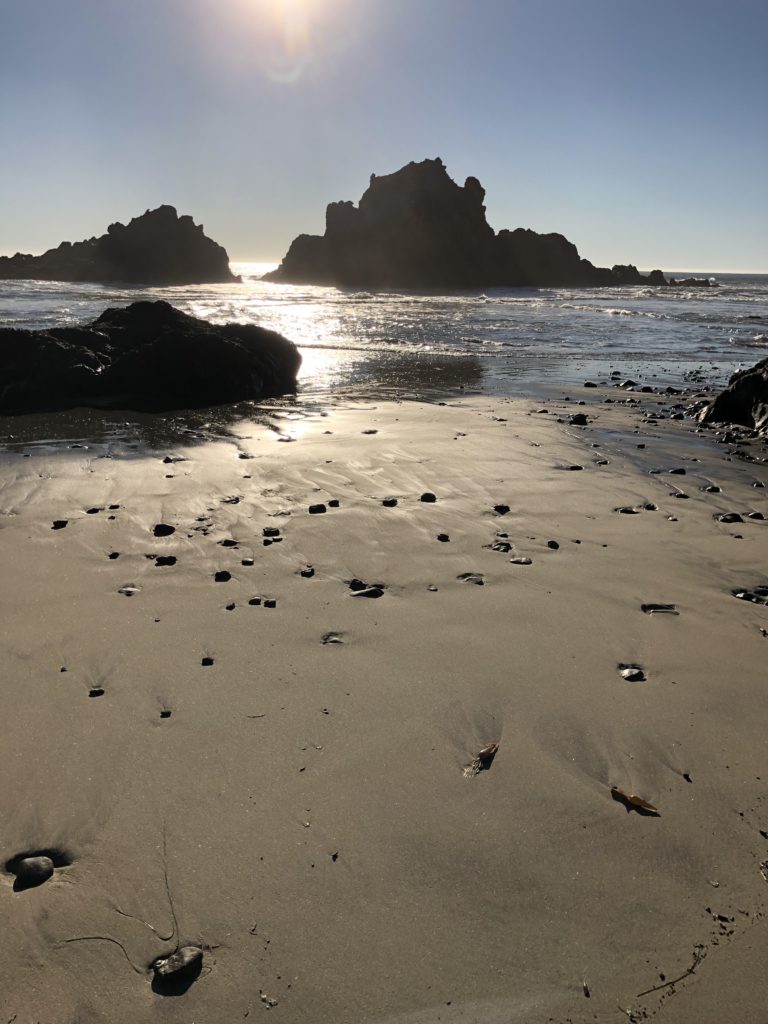
It’s fun to just sit and contemplate the myriad of sea stacks from the beautiful beach. If you are heading to Big Sur, the exquisite Pfeiffer Beach is a must see. It is easy to miss the unmarked turnoff for this secluded beach. Take a severely sharp turn off Highway 1 on Sycamore Canyon Road at mile marker 45.64, the second right turn after Big Sur Station if you are heading south. The meandering, narrow Sycamore Canyon Road is bordered by the occasional and surprising home, given the solitude. Follow Sycamore Canyon Road just over two miles to reach the parking area.
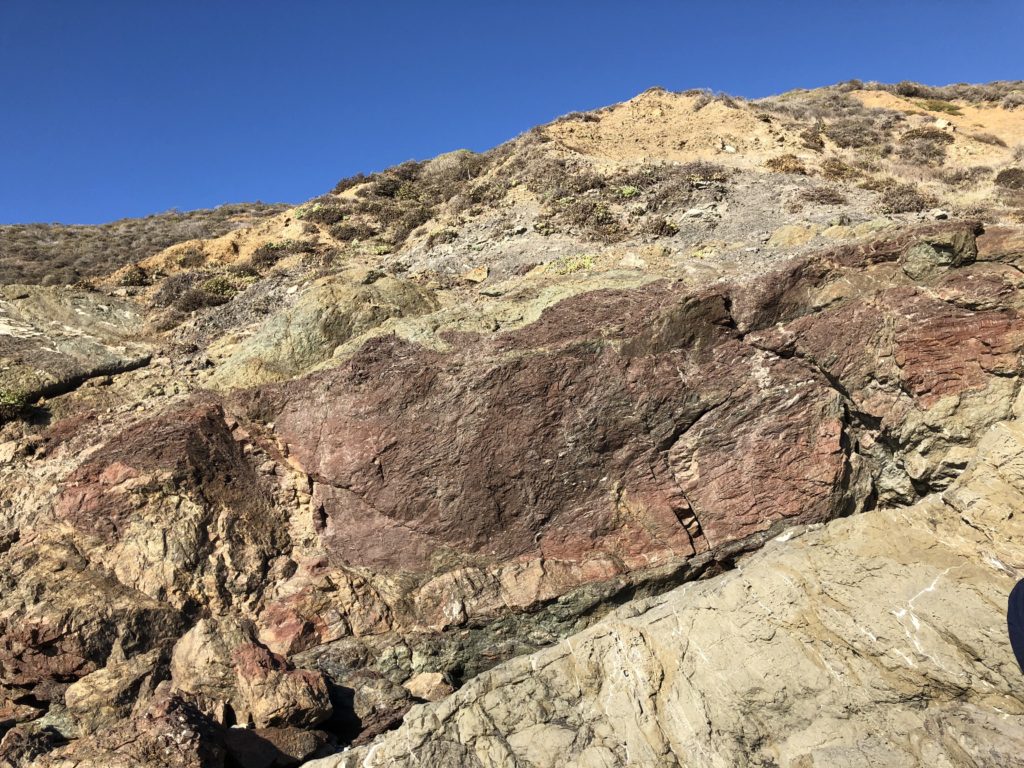
Manganese saturates the rocky outcroppings with its purple hue. 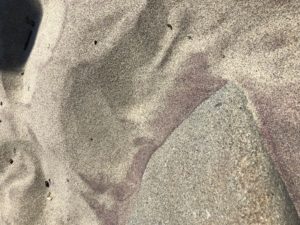
The disintegrating manganese in the cliffside creates a beautiful violet variation in the beach’s sand. Take a ridiculously short .1 mile hike on a flat, sandy path from the parking area to the beach. The path is flanked by Monterey Cypress and the Sycamore Canyon Creek, on the left, flows down to form a serene pool at the beach. The sun beats down on the purple-hued sand and huge waves roll and crash against the rocks and beach. The wind is usually blustery and harsh in this area.
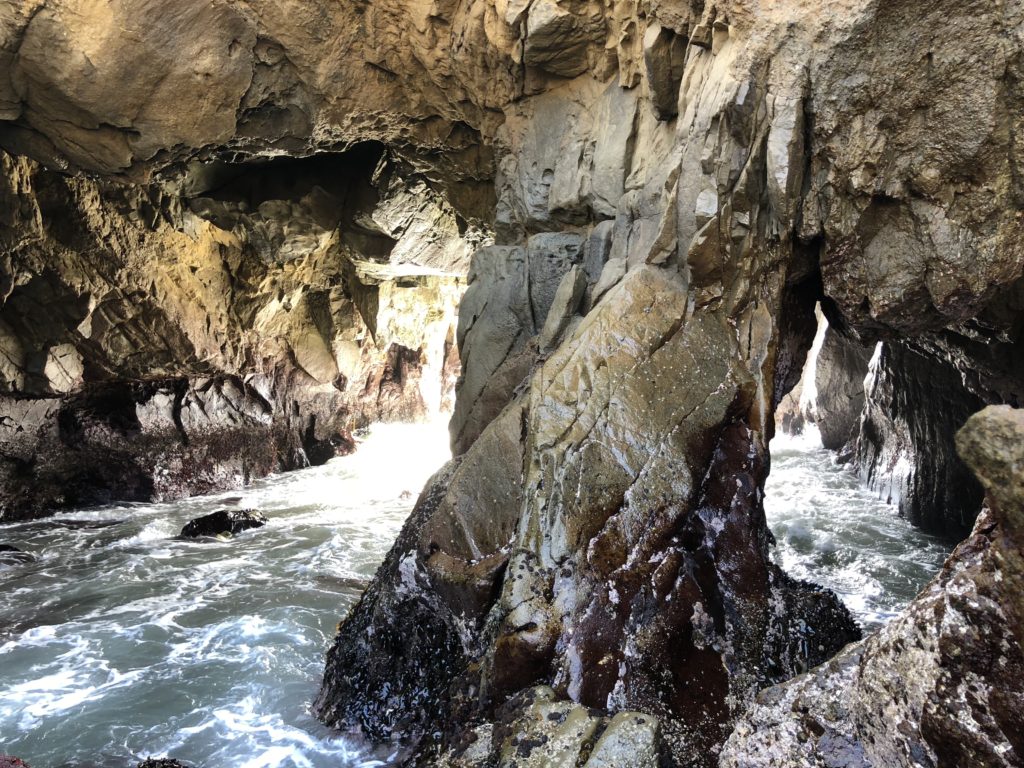
You will be wowed by the sea stack formations here. There are three arches. Two stand side by side, close to the beach. The third, called Keyhole Arch, stands further north, alone and solitary in a wall of rock several yards out in the ocean at high tide. For a few weeks, beginning in mid-December, sunlight comes through the northern keyhole arch perfectly (or close to it) due to the angle of the sunset, and photographers will gather to get that perfect shot. The surf here can also be incredibly powerful, with huge dramatic waves.
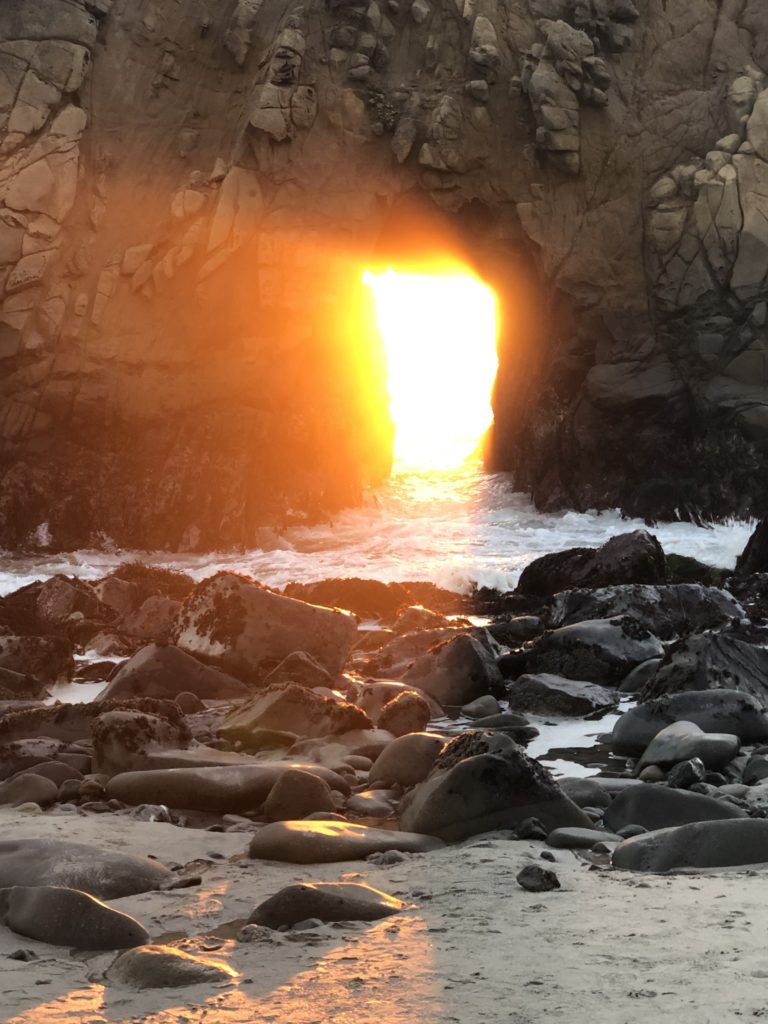
The Keyhole Arch is said to be the most-photographed attraction in Big Sur after Bixby Bridge. Pfeiffer Beach is not a state park, but rather, a part of the Los Padres Nation Forest. During the spring, the low bluffs above the beach are dotted with wildflowers, including California poppies, verbena, Indian paintbrush, and lupines. The cliffs and arches at Pfeiffer Beach are primarily granite which continues to erode over the years with the sea’s crashing waves.
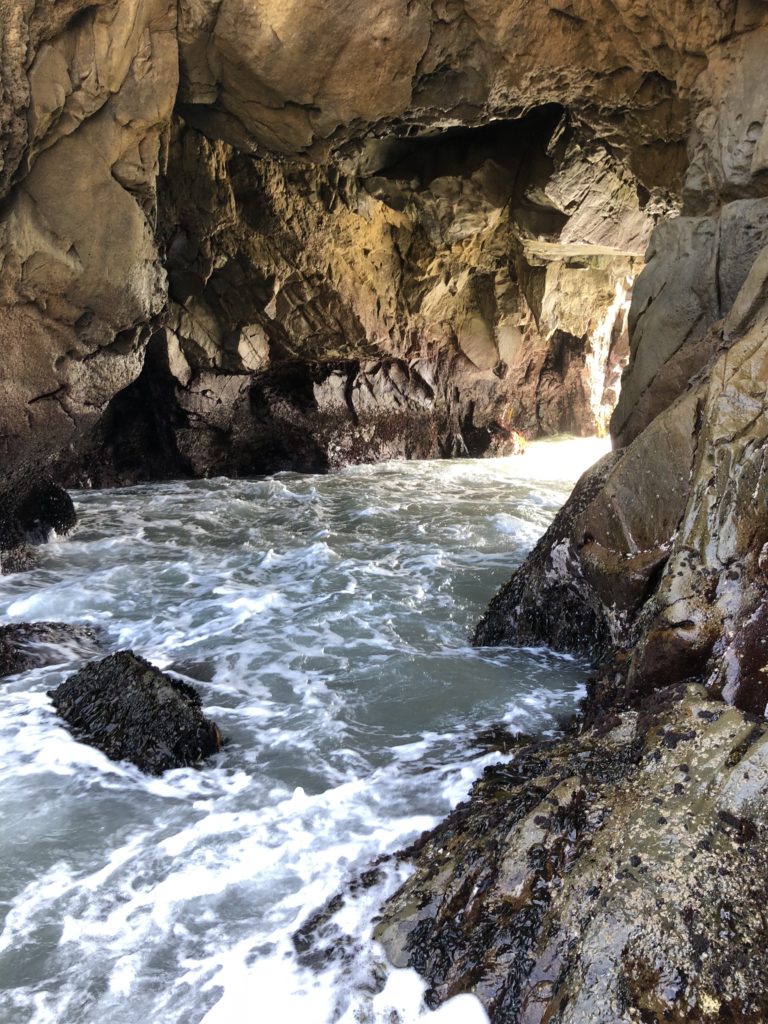
Helpful Tips:
- If you are heading south on Hwy 1, the Pfeiffer Beach turnoff is on the right, shortly after you pass the Pfeiffer Big Sur State Park entrance. The very sharp right turn is at mile marker 45.64 on unmarked Sycamore Canyon Road. Sycamore Canyon Road is a paved, ungated road.
- Pfeiffer Beach does not allow you to park outside and walk in, as you can at other places such as Point Lobos. Au Contraire. You have to pay the $10.00 entrance fee to enter in your vehicle.
- There are a limited number of parking spots and when they’re filled you are out of luck. They do not allow overnight camping, and no RVs or campers are allowed in due to the narrow road.
- Be aware that there is a “nude” section at the extreme far north end of the beach so that if you see a swimsuit or clothing lying on the beach you may be approaching a naked person!
- Pfeiffer Beach can also be extremely crowded on weekends so you may want to visit during the week when it is less busy.
- There are pit toilets available but no water to wash your hands. I recommend bringing hand sanitizer.
- It can be quite chilly and very windy, bring a sweater or jacket.
- The walk from the parking lot to the beach is short and well marked.
- Dogs on leash are allowed on the beach.
- Picnic tables and benches are available near the parking lot.
- GPS coordinates for Pfeiffer Beach are 36.2383,-121.8150.
- No campfires are allowed.
- Swimming and wading are not recommended due to dangerous waves and rip currents.
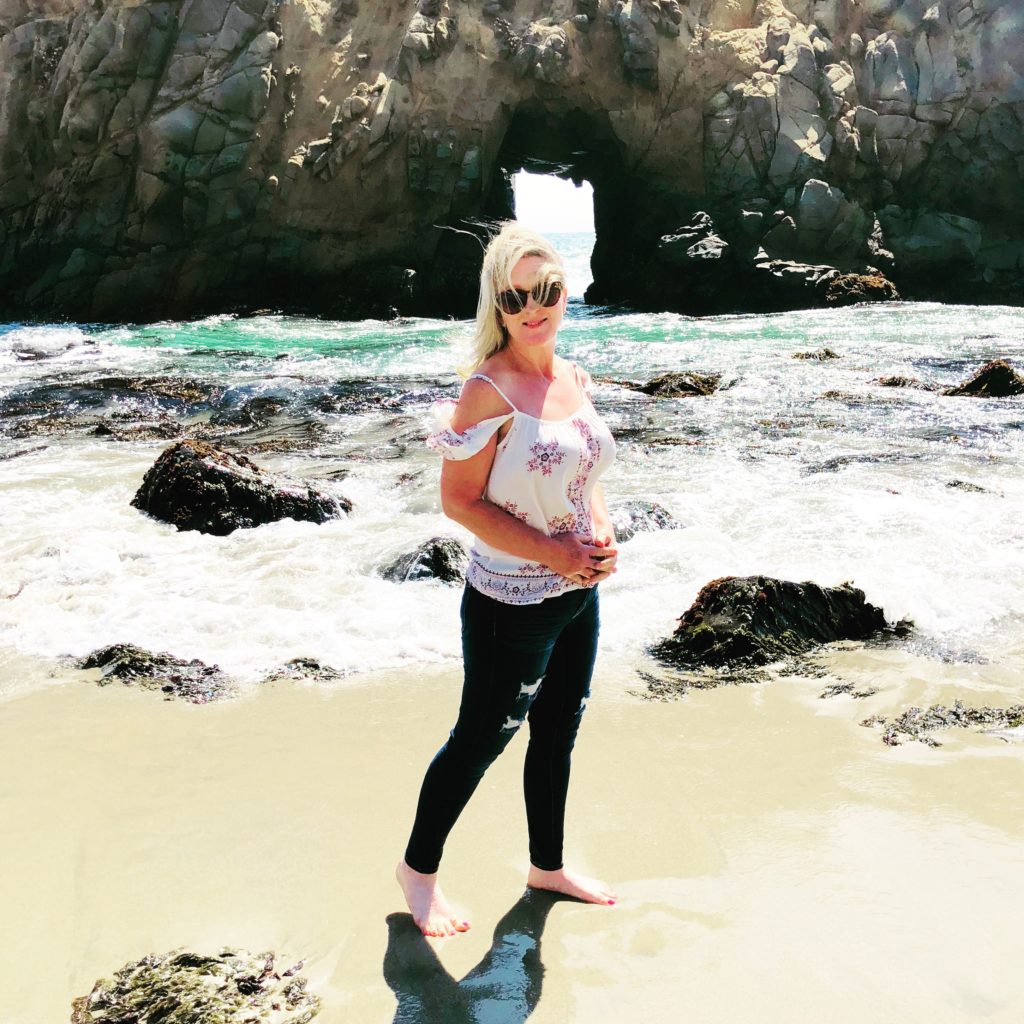
Cost:
Daily admission is 10.00 or you can purchase an annual pass for 50.00. Both cash and credit cards are accepted.
Hours:
They are open daily 8 am to sunset.
Helpful Links:
For more information, see Sycamore Canyon and Pfeiffer Beach
Thank you for visiting my blog! Wishing you peace, love, happiness, & beautiful vistas!